Zebra Technologies WT6000 Wearable Terminal User Manual WT6000 User Guide
Zebra Technologies Corporation Wearable Terminal WT6000 User Guide
Contents
- 1. User Manual (Installation) rev 2 Part 1.pdf
- 2. User Manual (Installation) rev 2 Part 2.pdf
- 3. User Manual (Statements).pdf
User Manual (Installation) rev 2 Part 1.pdf
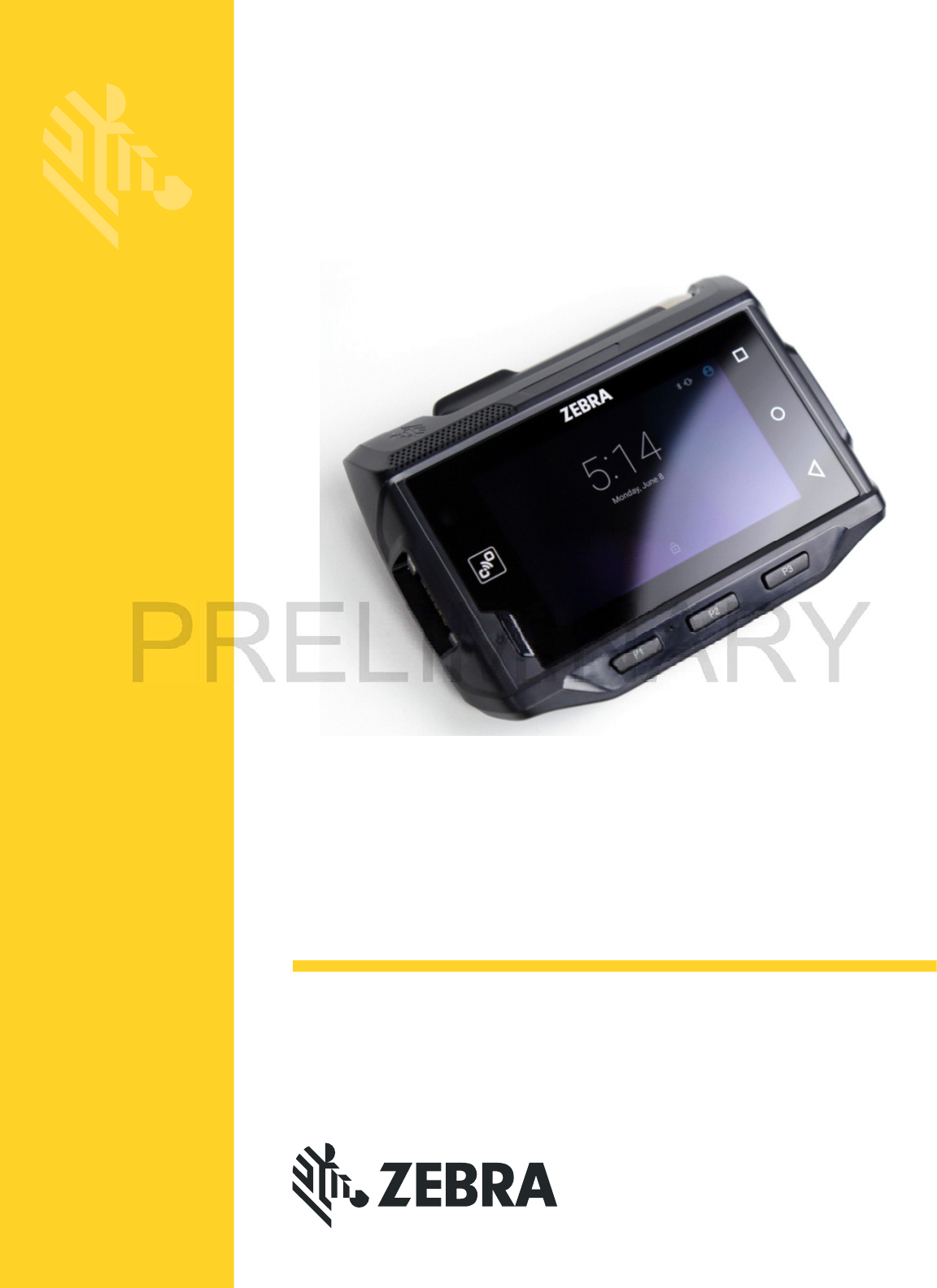
Wearable Computer
User Guide
WT6000
MN-002698-01


WT6000 Wearable Terminal
User Guide
MN-002698-01
Rev. A
May 2016
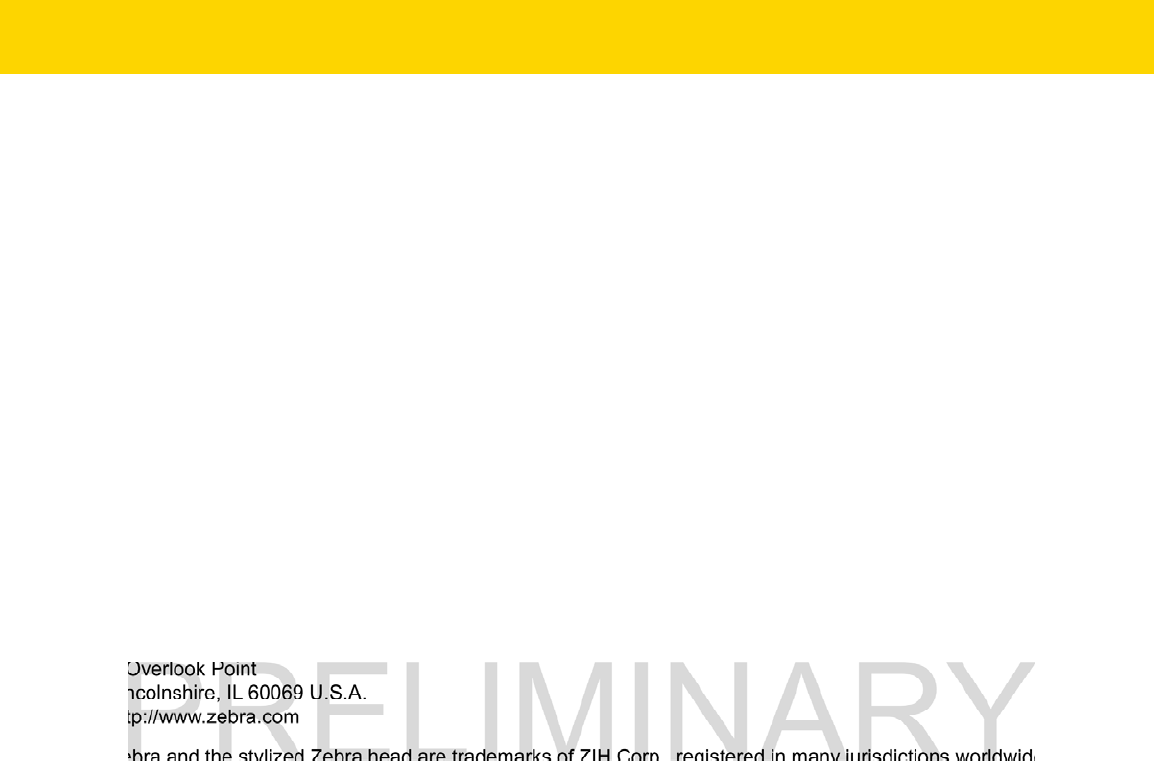
ii WT6000 User Guide
No part of this publication may be reproduced or used in any form, or by any electrical or mechanical means,
without permission in writing. This includes electronic or mechanical means, such as photocopying, recording,
or information storage and retrieval systems. The material in this manual is subject to change without notice.
The software is provided strictly on an “as is” basis. All software, including firmware, furnished to the user is on
a licensed basis. We grant to the user a non-transferable and non-exclusive license to use each software or
firmware program delivered hereunder (licensed program). Except as noted below, such license may not be
assigned, sublicensed, or otherwise transferred by the user without prior written consent. No right to copy a
licensed program in whole or in part is granted, except as permitted under copyright law. The user shall not
modify, merge, or incorporate any form or portion of a licensed program with other program material, create a
derivative work from a licensed program, or use a licensed program in a network without written permission.
The user agrees to maintain copyright notice on the licensed programs delivered hereunder, and to include the
same on any authorized copies it makes, in whole or in part. The user agrees not to decompile, disassemble,
decode, or reverse engineer any licensed program delivered to the user or any portion thereof.
We reserve the right to make changes to any software or product to improve reliability, function, or design.
We do not assume any product liability arising out of, or in connection with, the application or use of any
product, circuit, or application described herein.
No license is granted, either expressly or by implication, estoppel, or otherwise under any of our intellectual
property rights. An implied license only exists for equipment, circuits, and subsystems contained in our
products.
Zebra Technologies Corporation
3 Overlook Point
Lincolnshire, IL 60069 U.S.A.
http://www.zebra.com
Zebra and the stylized Zebra head are trademarks of ZIH Corp., registered in many jurisdictions worldwide. All
other trademarks are the property of their respective owners.
© 2016 Symbol Technologies LLC. All rights reserved.
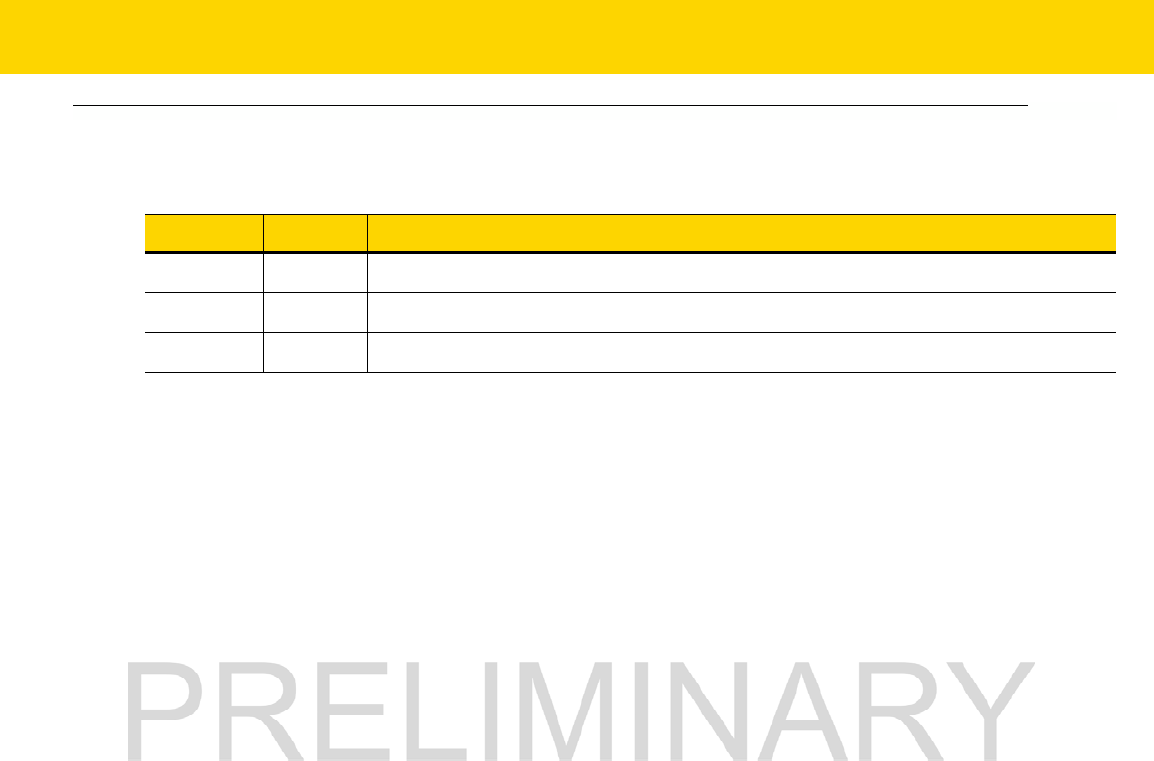
iii
Revision History
Changes to the original manual are listed below:
Change Date Description
01 Rev. A 5/2016 Initial release.

iv WT6000 User Guide

TABLE OF CONTENTS
Revision History ................................................................................................................................. iii
Table Of Contents
About This Guide
Introduction ....................................................................................................................................... xi
Documentation Set ........................................................................................................................... xi
Configurations................................................................................................................................... xii
Software Versions ....................................................................................................................... xii
Chapter Descriptions ........................................................................................................................ xii
Notational Conventions.................................................................................................................... xiii
Related Documents and Software ................................................................................................... xiii
Service Information .......................................................................................................................... xiv
Introduction .................................................................................................................................... 1-1
Unpacking ................................................................................................................................ 1-1
Removing the Screen Protection Film ...................................................................................... 1-1
Features ......................................................................................................................................... 1-2
Setup .............................................................................................................................................. 1-3
Installing the Battery ................................................................................................................. 1-3
Charging the Battery ................................................................................................................ 1-4
Starting the WT6000 ................................................................................................................ 1-5
Installing the Wrist Mount ............................................................................................................... 1-6
Install a Hip Mount ......................................................................................................................... 1-9
Routing an Extended Cable Scanner ..................................................................................... 1-10
Connecting a Scanner ................................................................................................................. 1-11
Replacing the Battery ................................................................................................................... 1-11
Battery Management .................................................................................................................... 1-12
Monitor Battery Usage ........................................................................................................... 1-12
Low Battery Notification ......................................................................................................... 1-13
Battery Optimization ............................................................................................................... 1-13
Turning Off the Radios ........................................................................................................... 1-13
Setting the Date and Time ........................................................................................................... 1-13
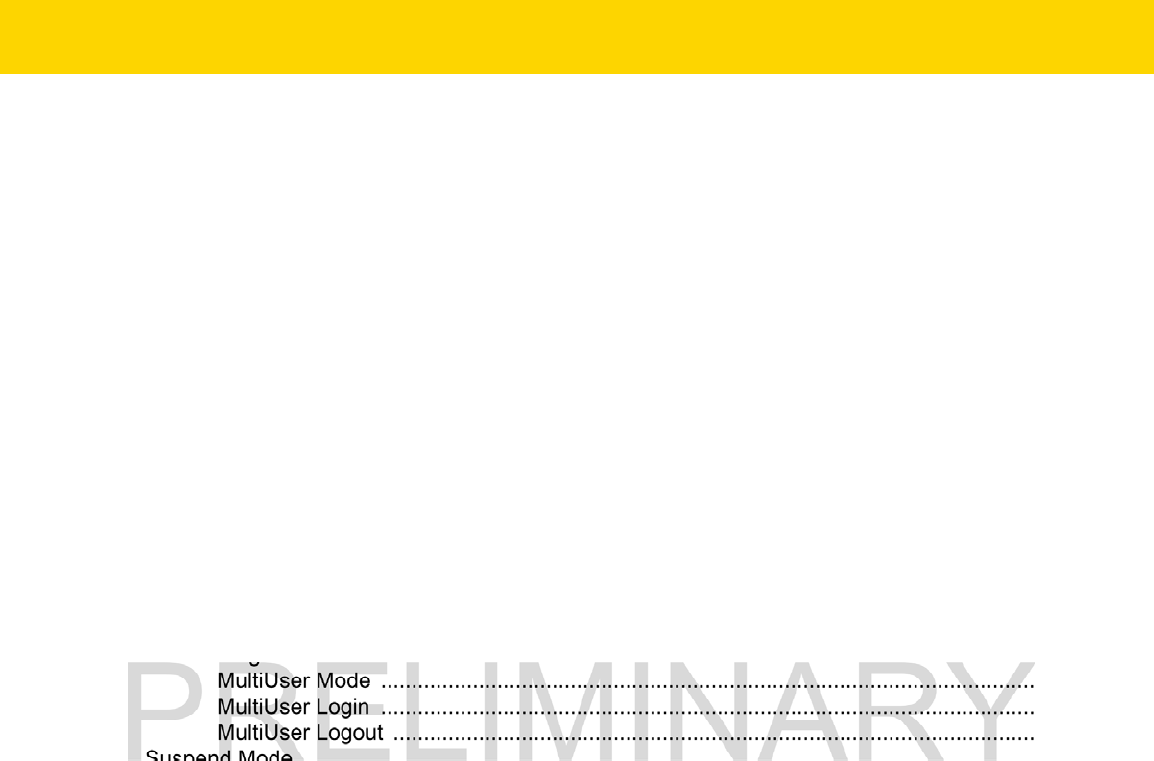
vi WT6000 User Guide
Display Setting ............................................................................................................................. 1-14
Setting the Screen Brightness ................................................................................................ 1-14
Setting Screen Timeout Setting ............................................................................................. 1-14
Setting Key Light Timeout Setting .......................................................................................... 1-15
Setting Font Size .................................................................................................................... 1-15
General Sound Setting ................................................................................................................. 1-15
Introduction .................................................................................................................................... 2-1
Home Screen ................................................................................................................................. 2-1
Status Bar ................................................................................................................................ 2-2
Status Icons ....................................................................................................................... 2-2
Notification Icons ...................................................................................................................... 2-2
Managing Notifications ............................................................................................................. 2-3
Using the Touchscreen ............................................................................................................ 2-4
Using the On-screen Keyboard ................................................................................................ 2-5
Editing Text .............................................................................................................................. 2-5
Entering Numbers, Symbols and Special Characters .............................................................. 2-5
Applications .................................................................................................................................... 2-5
Accessing Applications ...................................................................................................... 2-9
Switching Between Recent Applications .......................................................................... 2-10
Un-Locking the Screen ........................................................................................................... 2-10
Single User Mode ............................................................................................................. 2-10
MultiUser Mode ................................................................................................................ 2-11
MultiUser Login ................................................................................................................ 2-11
MultiUser Logout .............................................................................................................. 2-12
Suspend Mode ............................................................................................................................. 2-12
Resetting the WT6000 ................................................................................................................. 2-13
Performing a Soft Reset ......................................................................................................... 2-13
Performing a Hard Reset ....................................................................................................... 2-13
Introduction .................................................................................................................................... 3-1
Laser Scanning .............................................................................................................................. 3-1
Scanning Bar Codes ................................................................................................................ 3-1
Imaging .......................................................................................................................................... 3-1
Operational Modes ................................................................................................................... 3-2
Scanning Considerations ............................................................................................................... 3-2
Bar Code Capture with RS4000 ..................................................................................................... 3-2
Adaptive Scanning ............................................................................................................. 3-3
Bar Code Capture with RS6000 Hands-Free Imager .................................................................... 3-4
Bar Code Capture with RS507 Hands-Free Imager ...................................................................... 3-5
Pairing the RS507/RS6000 Hands-Free Imager ............................................................................ 3-6
Using NFC ................................................................................................................................ 3-6
Using SSI ................................................................................................................................. 3-7
Using Bluetooth HID ................................................................................................................. 3-8
Wireless Local Area Networks ....................................................................................................... 4-1
Scan and Connect to a Wi-Fi Network ..................................................................................... 4-2
Configuring a Wi-Fi Network .................................................................................................... 4-2
Manually Adding a Wi-Fi Network ............................................................................................ 4-3
Configuring for a Proxy Server ................................................................................................. 4-4
Configuring the Device to Use a Static IP Address .................................................................. 4-5
Advanced Wi-Fi Settings .......................................................................................................... 4-6
Additional Settings ................................................................................................................... 4-6
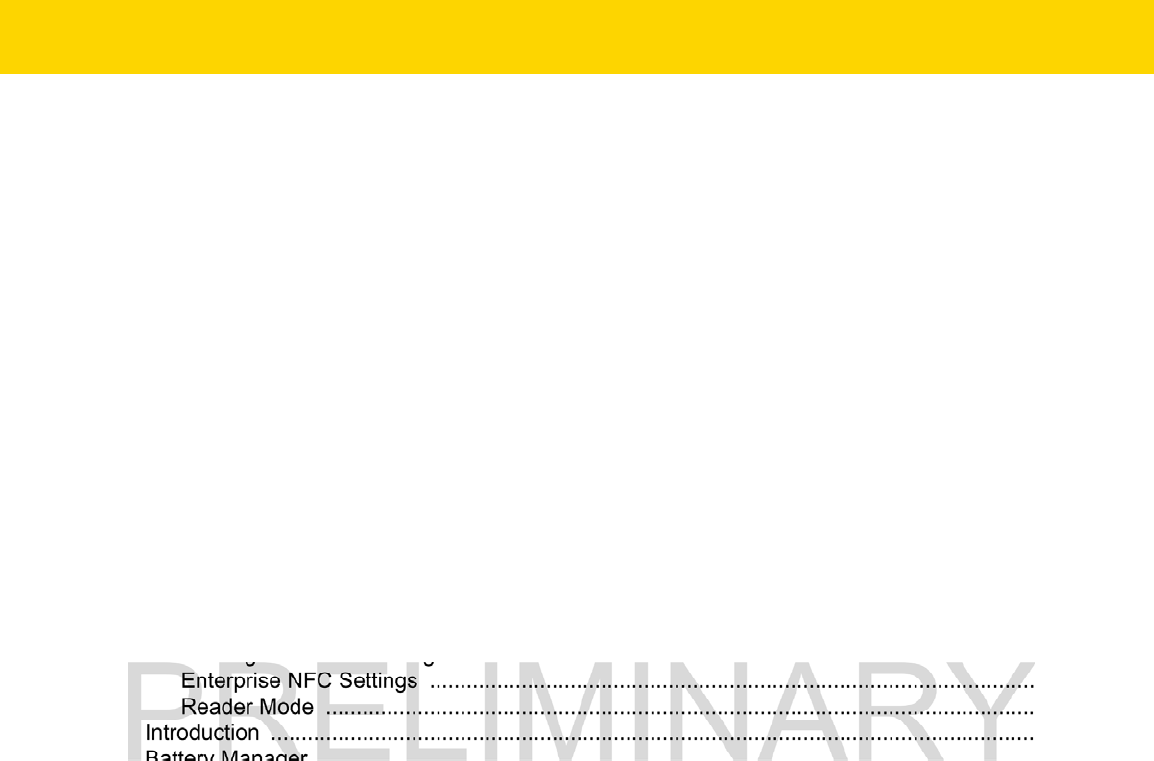
Table of Contents vii
Remove a Wi-Fi Network ......................................................................................................... 4-7
Wi-Fi Direct .................................................................................................................................... 4-7
WPS Pin Entry ............................................................................................................................... 4-8
Wi-Fi Advanced Features .............................................................................................................. 4-9
Zebra Mobility Extensions ............................................................................................................ 4-10
Bluetooth ...................................................................................................................................... 4-10
Adaptive Frequency Hopping ................................................................................................. 4-10
Security .................................................................................................................................. 4-11
Bluetooth Profiles ................................................................................................................... 4-11
Bluetooth Power States .......................................................................................................... 4-12
Bluetooth Radio Power .......................................................................................................... 4-12
Enabling Bluetooth ........................................................................................................... 4-12
Disabling Bluetooth .......................................................................................................... 4-12
Discovering Bluetooth Device(s) ............................................................................................ 4-12
Changing the Bluetooth Name ............................................................................................... 4-13
Connecting to a Bluetooth Device .......................................................................................... 4-14
Selecting Profiles on the Bluetooth Device ............................................................................ 4-14
Unpairing a Bluetooth Device ................................................................................................. 4-14
Near Field Communications ......................................................................................................... 4-14
Reading NFC Cards ............................................................................................................... 4-15
Sharing Information Using NFC ............................................................................................. 4-15
Enterprise NFC Settings ........................................................................................................ 4-16
Reader Mode ......................................................................................................................... 4-17
Introduction .................................................................................................................................... 5-1
Battery Manager ............................................................................................................................ 5-1
File Browser ................................................................................................................................... 5-3
PTT Express Voice Client .............................................................................................................. 5-5
PTT Audible Indicators ............................................................................................................. 5-5
Notification Icons ...................................................................................................................... 5-6
Enabling PTT Communication ................................................................................................. 5-6
Selecting a Talk Group ............................................................................................................. 5-6
PTT Communication ................................................................................................................ 5-7
Creating a Group Call .............................................................................................................. 5-7
Disabling PTT Express Voice Client Communication .............................................................. 5-8
DataWedge .................................................................................................................................... 5-9
DataWedge Demonstration .......................................................................................................... 5-10
MLog Manager ............................................................................................................................. 5-11
RxLogger ..................................................................................................................................... 5-12
RxLogger Configuration ......................................................................................................... 5-12
Configuration File ............................................................................................................. 5-12
Enabling Logging ................................................................................................................... 5-12
Disabling Logging ................................................................................................................... 5-12
Extracting Log Files ................................................................................................................ 5-13
Elemez ......................................................................................................................................... 5-14
Disabling Elemez Data Collection .......................................................................................... 5-14
Enabling Elemez Data Collection ........................................................................................... 5-14
Print Station ................................................................................................................................. 5-16
Zebra Tap & Pair .......................................................................................................................... 5-17
Zebra Utilities ............................................................................................................................... 5-19
Accessories .................................................................................................................................... 6-1
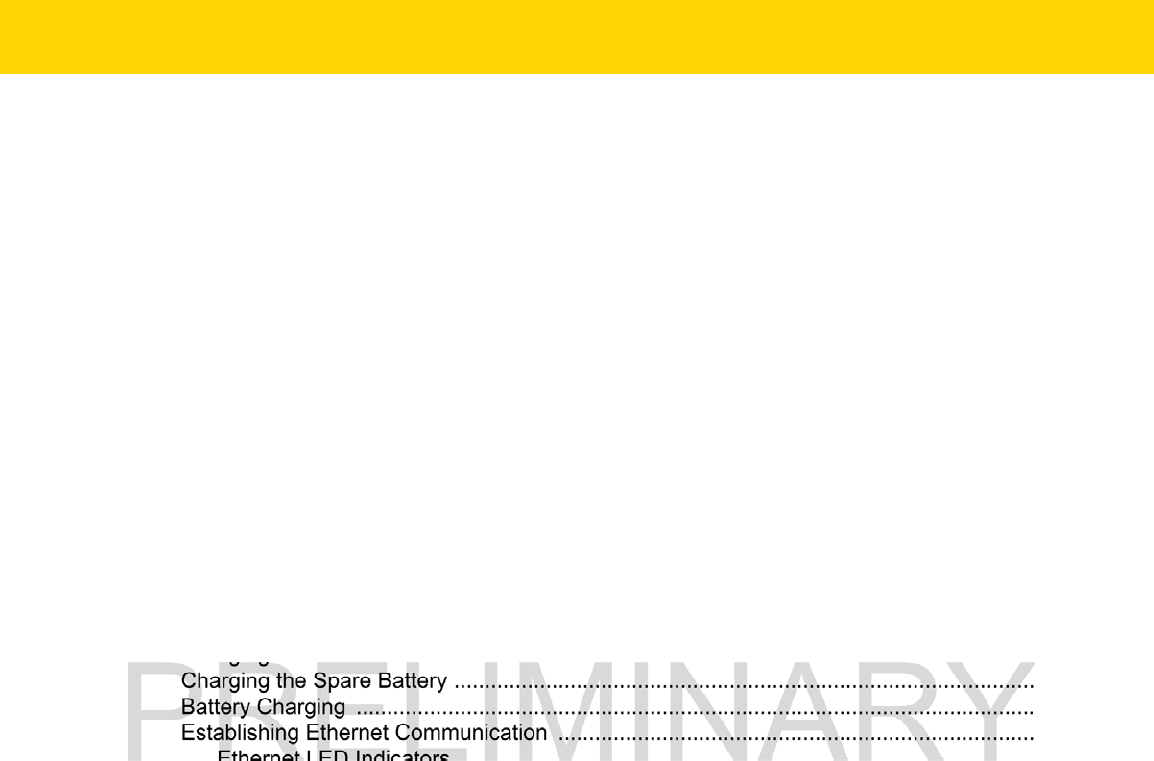
viii WT6000 User Guide
1-Slot WT6000 USB Charging Cradle ........................................................................................... 6-4
Charging the Device ................................................................................................................. 6-4
Charging the Spare Battery ...................................................................................................... 6-5
Battery Charging ...................................................................................................................... 6-5
2-Slot WT6000/RS6000 Charging Cradle ...................................................................................... 6-7
Charging the WT6000 .............................................................................................................. 6-7
Charging the RS6000 ............................................................................................................... 6-8
Battery Charging ...................................................................................................................... 6-8
5-Slot WT6000 Charge Only Cradle .............................................................................................. 6-9
Charging the WT6000 .............................................................................................................. 6-9
Charging the Spare Battery .................................................................................................... 6-10
Battery Charging .................................................................................................................... 6-10
10-Slot WT6000/RS6000 Charge Only Cradle ............................................................................ 6-11
Charging the WT6000 ............................................................................................................ 6-11
Charging the RS6000 ............................................................................................................. 6-12
Battery Charging .................................................................................................................... 6-12
10-Slot WT6000 Charge Only Cradle .......................................................................................... 6-13
Charging the WT6000 ............................................................................................................ 6-13
Battery Charging .................................................................................................................... 6-14
5-Slot WT6000 Ethernet Cradle ................................................................................................... 6-15
Charging the WT6000 ............................................................................................................ 6-15
Charging the Spare Battery .................................................................................................... 6-16
Battery Charging .................................................................................................................... 6-16
Establishing Ethernet Communication ................................................................................... 6-16
Ethernet LED Indicators ................................................................................................... 6-17
4-Slot Battery Charger ................................................................................................................. 6-18
Battery Installation .................................................................................................................. 6-18
Battery Removal ..................................................................................................................... 6-18
Battery Charging .................................................................................................................... 6-19
Spare Battery Charging .................................................................................................... 6-19
20-Slot Battery Charger ............................................................................................................... 6-20
Battery Installation .................................................................................................................. 6-20
Battery Removal ..................................................................................................................... 6-21
Battery Charging .................................................................................................................... 6-21
Spare Battery Charging .................................................................................................... 6-21
USB and Charging Cable ............................................................................................................. 6-22
Attaching the USB and Charging Cable ................................................................................. 6-22
Removing the USB and Charging Cable ................................................................................ 6-23
Battery Charging .................................................................................................................... 6-23
Main Battery Charging ..................................................................................................... 6-23
Charging Temperature ........................................................................................................... 6-23
Quick Disconnect Audio Cables ................................................................................................... 6-24
Attaching the Audio Adapter .................................................................................................. 6-24
Connecting the Adapter to a Headset .................................................................................... 6-24
Removing the Audio Adapter ................................................................................................. 6-25
Vibrator Cable .............................................................................................................................. 6-26
RS4000 Scanner .......................................................................................................................... 6-27
Wired Headset ............................................................................................................................. 6-29
Introduction .................................................................................................................................... 7-1
Maintaining the WT6000 ................................................................................................................ 7-1

Table of Contents ix
Battery Safety Guidelines .............................................................................................................. 7-1
Long Term Storage ........................................................................................................................ 7-2
Cleaning Instructions ..................................................................................................................... 7-2
Approved Cleanser Active Ingredients ..................................................................................... 7-2
Harmful Ingredients .................................................................................................................. 7-2
Cleaning Instructions ................................................................................................................ 7-3
Special Cleaning Notes ............................................................................................................ 7-3
Cleaning Materials Required .................................................................................................... 7-3
Cleaning Frequency ................................................................................................................. 7-3
Cleaning the WT6000 .............................................................................................................. 7-3
Housing .............................................................................................................................. 7-3
Display ............................................................................................................................... 7-3
Power Connector ............................................................................................................... 7-3
Cleaning Cradle Connectors .................................................................................................... 7-4
Cleaning the Wrist Mount ......................................................................................................... 7-4
Troubleshooting ............................................................................................................................. 7-6
WT6000 .................................................................................................................................... 7-6
Appendix A: Specifications
Technical Specifications ............................................................................................................... A-1
Index

x WT6000 User Guide

ABOUT THIS GUIDE
Introduction
This guide provides information about setting up and configuring WT6000 mobile computers with Android
operating system and installing its accessories.
Documentation Set
The documentation set for the WT6000 is divided into guides that provide information for specific user needs.
WT6000 documentation includes:
•
WT6000 Quick Reference Guide - describes basic set up and operation of the WT6000 and it’s
accessories.
•
WT6000 User Guide (this guide) - describes how to set up, operate and program the WT6000 with Android
operating system and it’s accessories.
•
WT6000 Integrator Guide - describes how to setup and configure WT6000 and accessories.
NOTE Some screens or windows shown in this guide may differ from the actual screens shown on the WT6000.
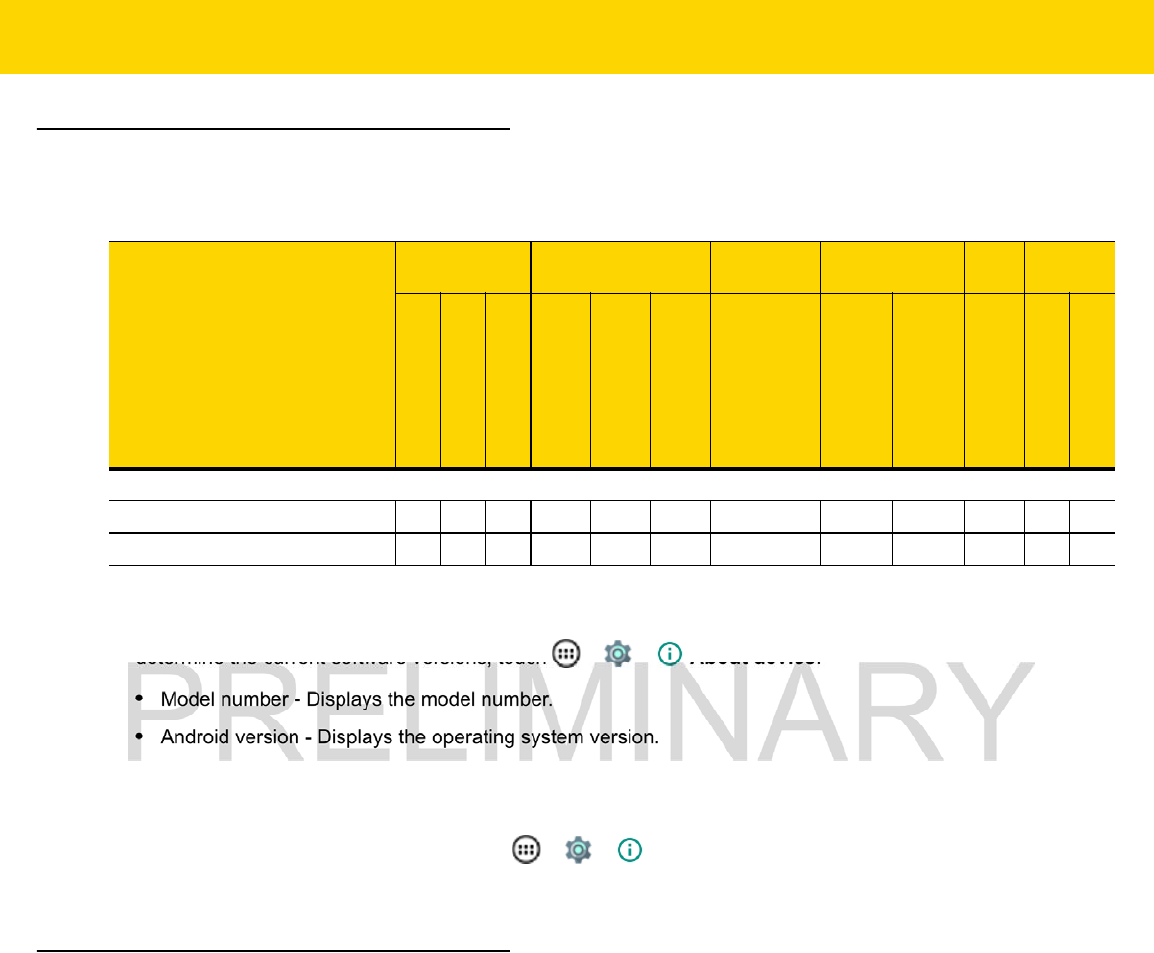
xii WT6000 User Guide
Configurations
This guide covers the following configurations:
Software Versions
To determine the current software versions, touch > > About device.
•
Model number - Displays the model number.
•
Android version - Displays the operating system version.
•
Kernel version - Displays the kernel version number.
•
Build number - Displays the software build number.
To determine the device serial number, touch > > About device > Status.
•
Serial number - Displays the serial number.
Chapter Descriptions
Topics covered in this guide are as follows:
•
Chapter 1, Getting Started, describes the features and basic operation of the WT6000, lists the accessories
for the WT6000 and explains how to install and charge the batteries and start the WT6000 for the first time.
•
Chapter 2, Using the WT6000, provides instructions for connecting the WT6000 to a host computer and
using the OS desktop of the WT6000.
•
Chapter 3, Data Capture, provides information for capturing bar code data.
•
Chapter 4, Wireless, provides information on the various wireless options.
•
Chapter 5, Applications, provides information on various applications pre-installed on the WT6000.
•
Chapter 6, Accessories, Accessories, provides information for using the accessories with the WT6000.
•
Chapter 7, Maintenance and Troubleshooting, includes instructions on cleaning and storing the WT6000, and
provides troubleshooting solutions for potential problems during WT6000 operation.
Configuration
Radios Data Capture Display Memory OS Sensor
s
802.11 abgn
Bluetooth 4.0
NFC
RS6000
RS4000
RS507
3.2” WVGA Color
1G RAM/
4 GB Flash
2G RAM/
16 GB Flash
Android AOSP
V5.1.1
Accelerometer
Gyroscope
Standard
WT60A0-TS0LEWR X X X X X X X X X X X
WT60A0-TS2LEWR X
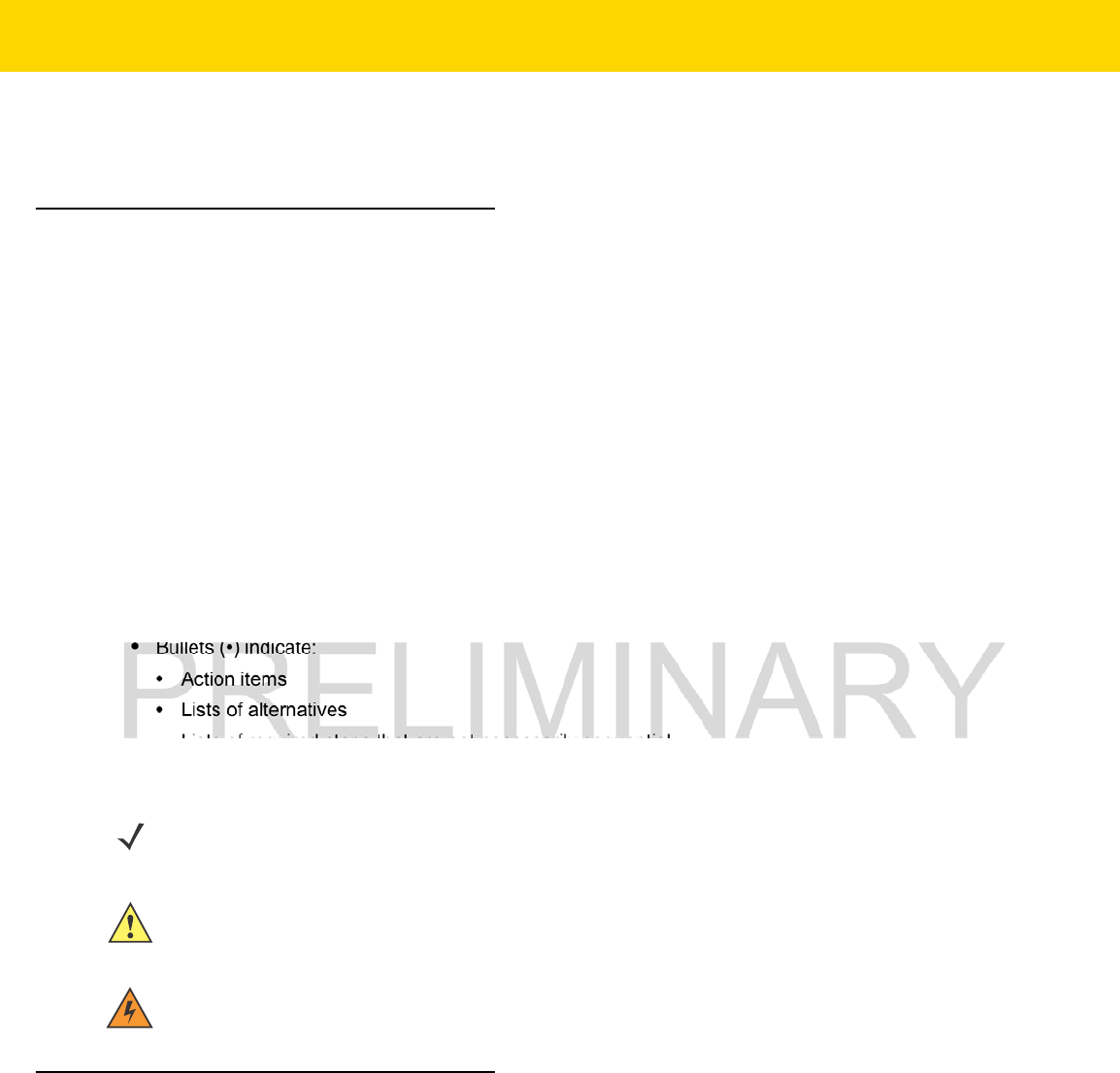
About This Guide xiii
•
Appendix A, Specifications, includes a table listing the technical specifications for the WT6000 and
accessories.
Notational Conventions
The following conventions are used in this document:
•
Italics are used to highlight the following:
•Chapters and sections in this guide
•Related documents
•
Bold text is used to highlight the following:
•Dialog box, window and screen names
•Drop-down list and list box names
•Check box and radio button names
•Icons on a screen
•Key names on a keypad
•Button names on a screen
•
Bullets (•) indicate:
•Action items
•Lists of alternatives
•Lists of required steps that are not necessarily sequential
•Sequential lists (e.g., those that describe step-by-step procedures) appear as numbered lists.
Related Documents and Software
The following documents provide more information about the WT6000 touch computers.
•
WT6000 Quick Start Guide, p/n MN-002700-xx
•
WT6000 Regulatory Guide, p/n MN-002701-xx
•
WT6000 Integrator Guide, p/n MN-002699-xx
•
WT6000 Accessory Regulatory Guide, p/n MN-002702-xx
For the latest version of this guide and all guides, go to: http://www.zebra.com/support.
NOTE This symbol indicates something of special interest or importance to the reader. Failure to read the note
will not result in physical harm to the reader, equipment or data.
CAUTION This symbol indicates that if this information is ignored, the possibility of data or material damage
may occur.
WARNING!This symbol indicates that if this information is ignored the possibility that serious personal
injury may occur.

xiv WT6000 User Guide
Service Information
If you have a problem with your equipment, contact Customer Support for your region. Contact information is
available at: http://www.zebra.com/support.
When contacting Customer Support, please have the following information available:
•
Serial number of the unit
•
Model number or product name
•
Software type and version number.
We respond to calls by E-mail, or telephone within the time limits set forth in support agreements.
If your problem cannot be solved by Zebra Support, you may need to return your equipment for servicing and will
be given specific directions. Zebra is not responsible for any damages incurred during shipment if the approved
shipping container is not used. Shipping the units improperly can possibly void the warranty.
If you purchased your business product from a business partner, contact that business partner for support.

CHAPTER 1 GETTING STARTED
Introduction
This chapter describes the features of the WT6000 and explains how to install and charge the battery and how to
reset the WT6000.
Unpacking
Carefully remove all protective material from the WT6000 and save the shipping container for later storage and
shipping.
Verify that box contains all the equipment listed below:
•
WT6000
•
Battery
•
Regulatory Guide.
Inspect the equipment for damage. If you are missing any equipment or if you find any damaged equipment,
contact Support immediately. See Service Information on page xiv for contact information.
Removing the Screen Protection Film
A screen protection film is applied to the WT6000 screen to protect the screen during shipping. To remove the
screen protector, carefully lift the thin film off the display.
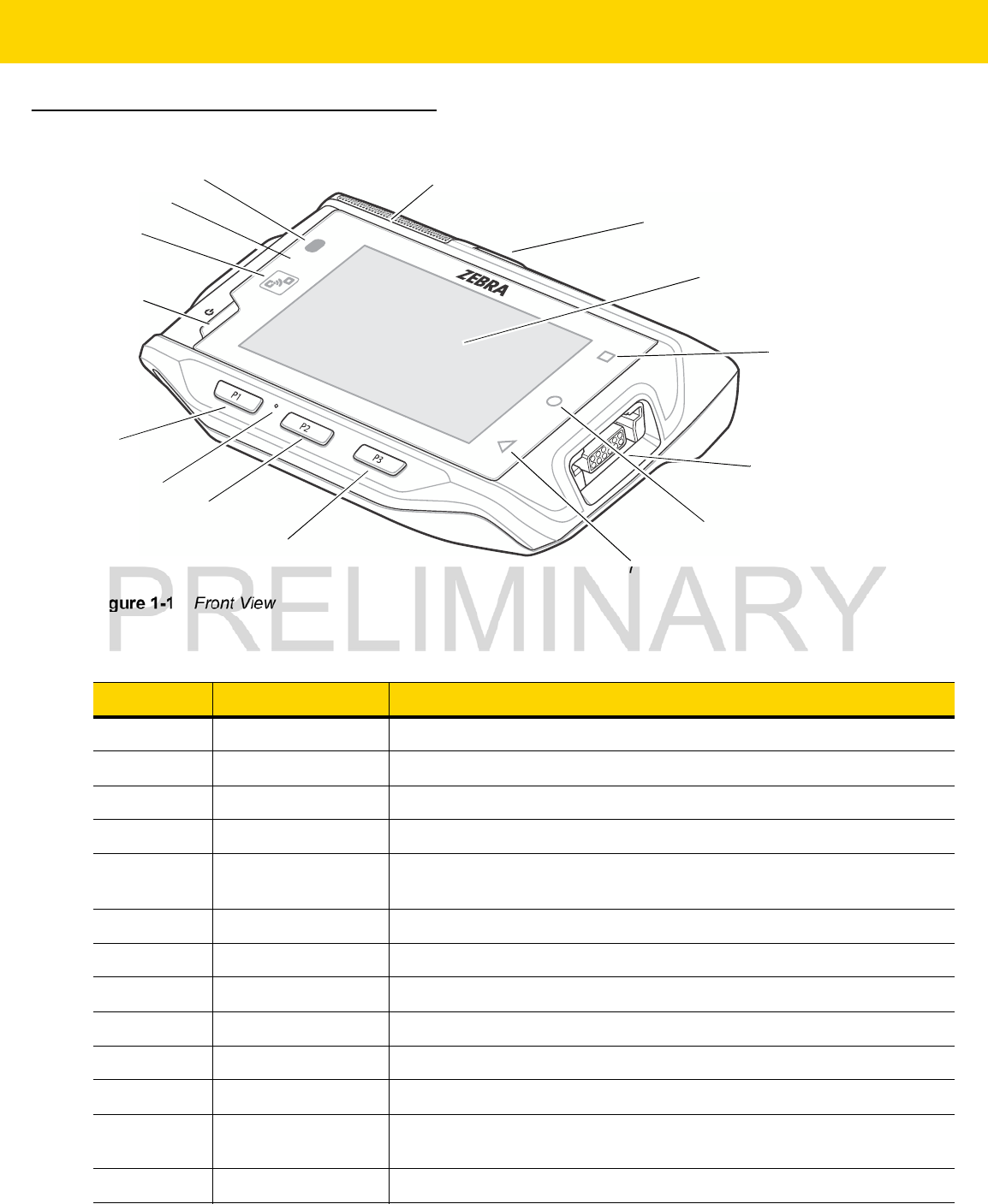
1 - 2 WT6000 User Guide
Features
Figure 1-1 Front View
Table 1-1 Front View Descriptions
Number Item Function
1 Speakers Provides audio output for video and music playback.
2 Battery Provides power to the device.
3 Display Displays all information needed to operate the WT6000.
4 Recent Button Displays recently open applications.
5 Right Interface
Connector
Provides USB host and client communication, audio and device charging
via cables and accessories.
6 Home Button Displays the Home screen.
7 Back Button Displays the previous screen.
8 P3 Button Initiates Push-To-Talk communication (programmable).
9 P2 Button Increases volume.
10 Microphone Use for communication in Headset mode.
11 P1 Button Volume down
12 Power Button Turns the display on and off. Press and hold to reset the device and power
off.
13 NFC Antenna Provides communication with other NFC-enabled devices.
3
12
1
2
15
11
10
9
8
5
13
4
7
6
14
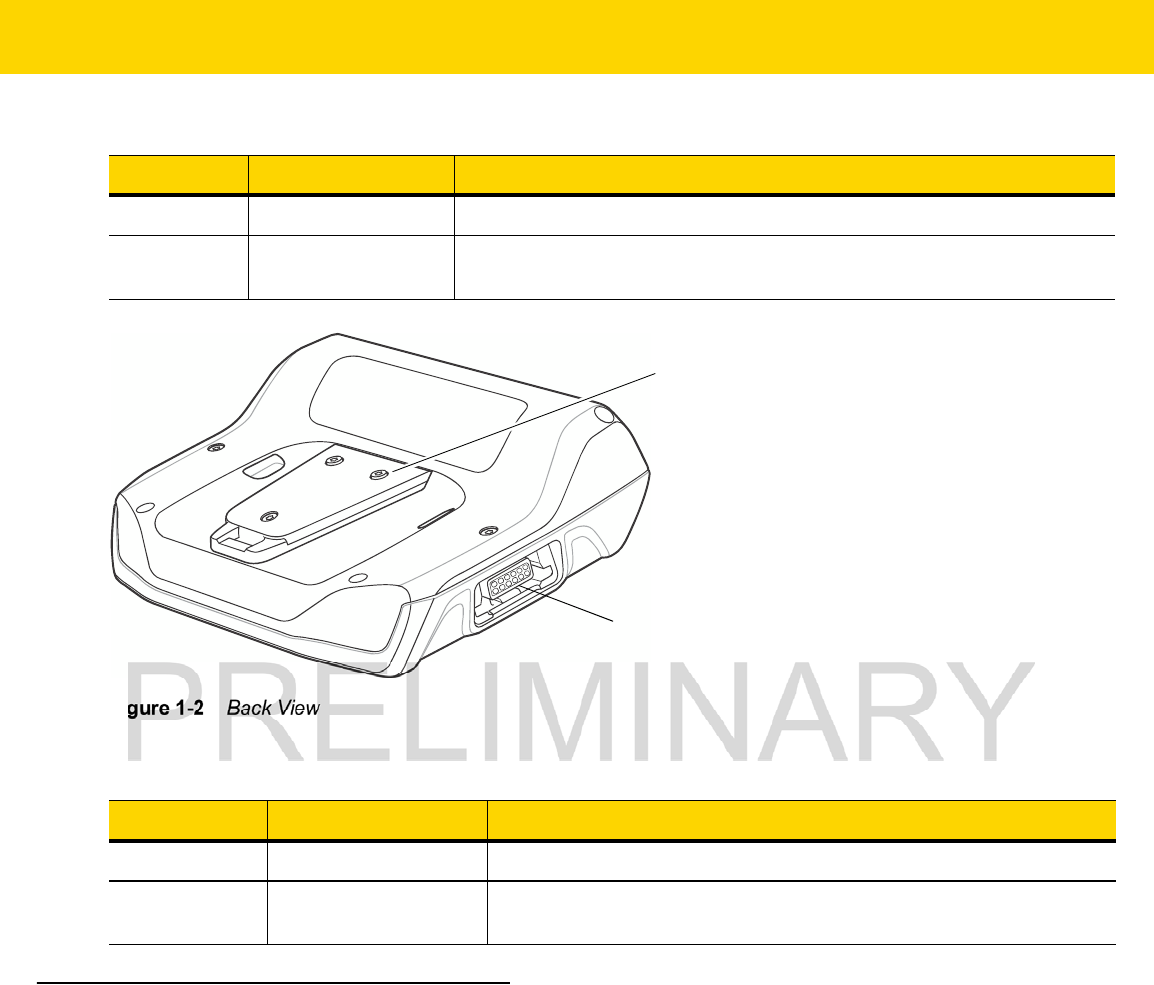
Getting Started 1 - 3
Figure 1-2 Back View
Setup
Perform these procedures to start using the WT6000 for the first time.
1. Install the battery.
2. Charge the WT6000.
3. Power on the WT6000.
Installing the Battery
To install the battery:
1. Insert the silver end of the battery into the battery well.
14 Ambient Light Sensor Determines ambient light for controlling display backlight intensity.
15 Notification/Charge
LED
Indicates battery charging status while charging with USB Charge cable
and provide notifications from applications.
Table 1-2 Back View Descriptions
Number Item Function
16 Cleat Provides alignment and secures the WT6000 to the wrist mount.
17 Left Interface
Connector
Provides USB host and client communication, audio and device
charging via cables and accessories.
Table 1-1 Front View Descriptions (Continued)
Number Item Function
17
16
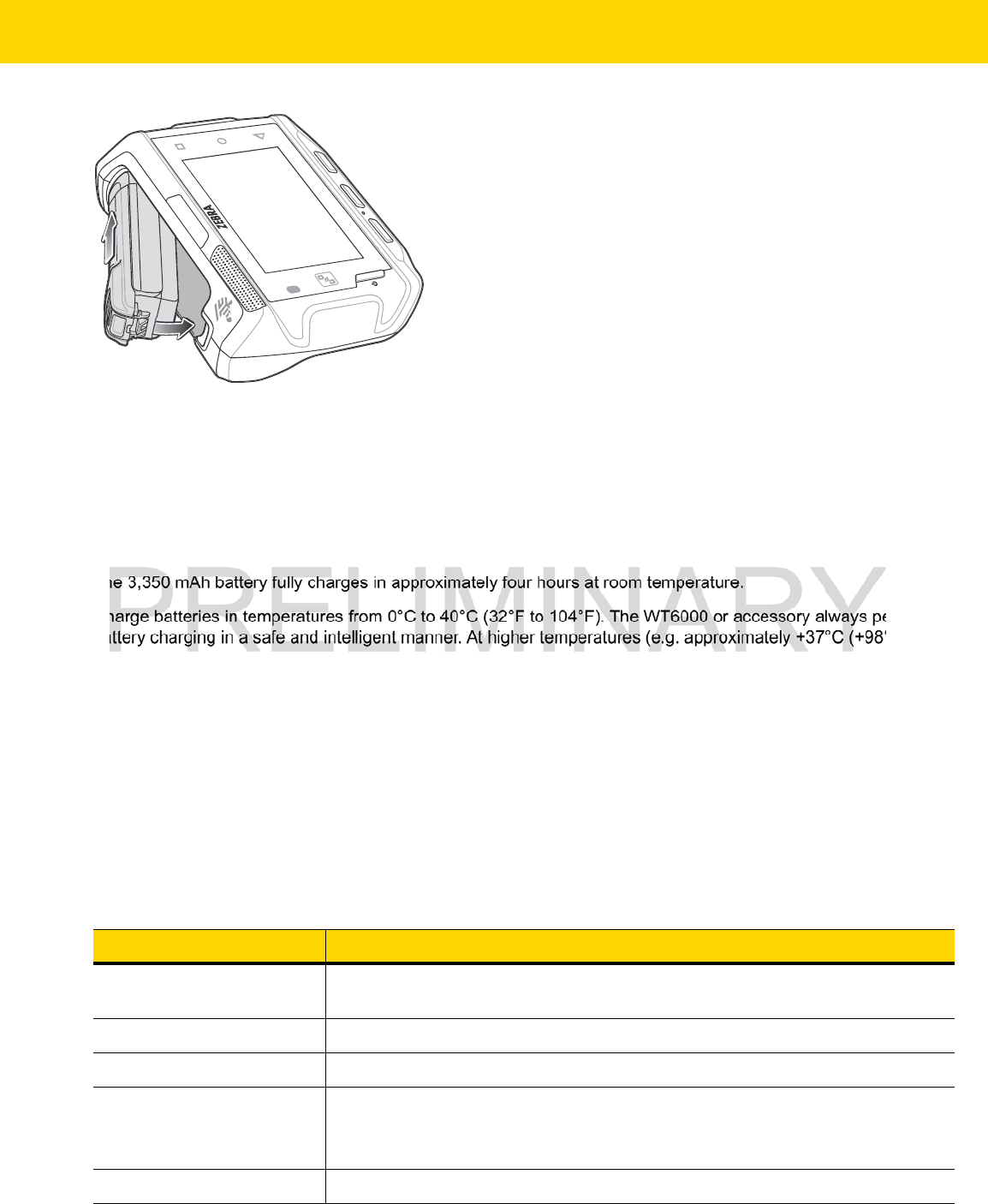
1 - 4 WT6000 User Guide
Figure 1-3 Battery Installation
2. Press the battery down until it snaps into place.
Charging the Battery
Before using the WT6000 for the first time, charge the battery using a cable or a cradle with the appropriate power
supply. For information about the accessories available for the WT6000, see Chapter 6, Accessories.
The 3,350 mAh battery fully charges in approximately four hours at room temperature.
Charge batteries in temperatures from 0°C to 40°C (32°F to 104°F). The WT6000 or accessory always performs
battery charging in a safe and intelligent manner. At higher temperatures (e.g. approximately +37°C (+98°F)) the
WT6000 or accessory may for small periods of time alternately enable and disable battery charging to keep the
battery at acceptable temperatures. The WT6000 or accessory indicates when charging is disabled due to
abnormal temperatures via its red blinking LED.
1. To charge the main battery, connect the charging accessory to the appropriate power source.
2. Insert the WT6000 into a cradle or attach to a cable. The WT6000 turns on and begins charging.
When using the USB Charge cable, the Notification/Charge LED lights amber while charging, then turns solid
green when fully charged.
When using a cradle, the cradle Charge LED lights amber while charging, then turns solid green when fully
charged.
Table 1-3 Charge LED Charging Indicators
State Indication
Off WT6000 is not charging. WT6000 is not inserted correctly in the cradle or
connected to a power source. Charger/cradle is not powered.
Solid Amber Healthy battery is charging.
Solid Green Healthy battery charging is complete.
Fast Blinking Red
(2 blinks/second)
Charging error, e.g.:
- Temperature is too low or too high.
- Charging has gone on too long without completion (typically eight hours).
Solid Red Unhealthy battery is charging or fully charged.
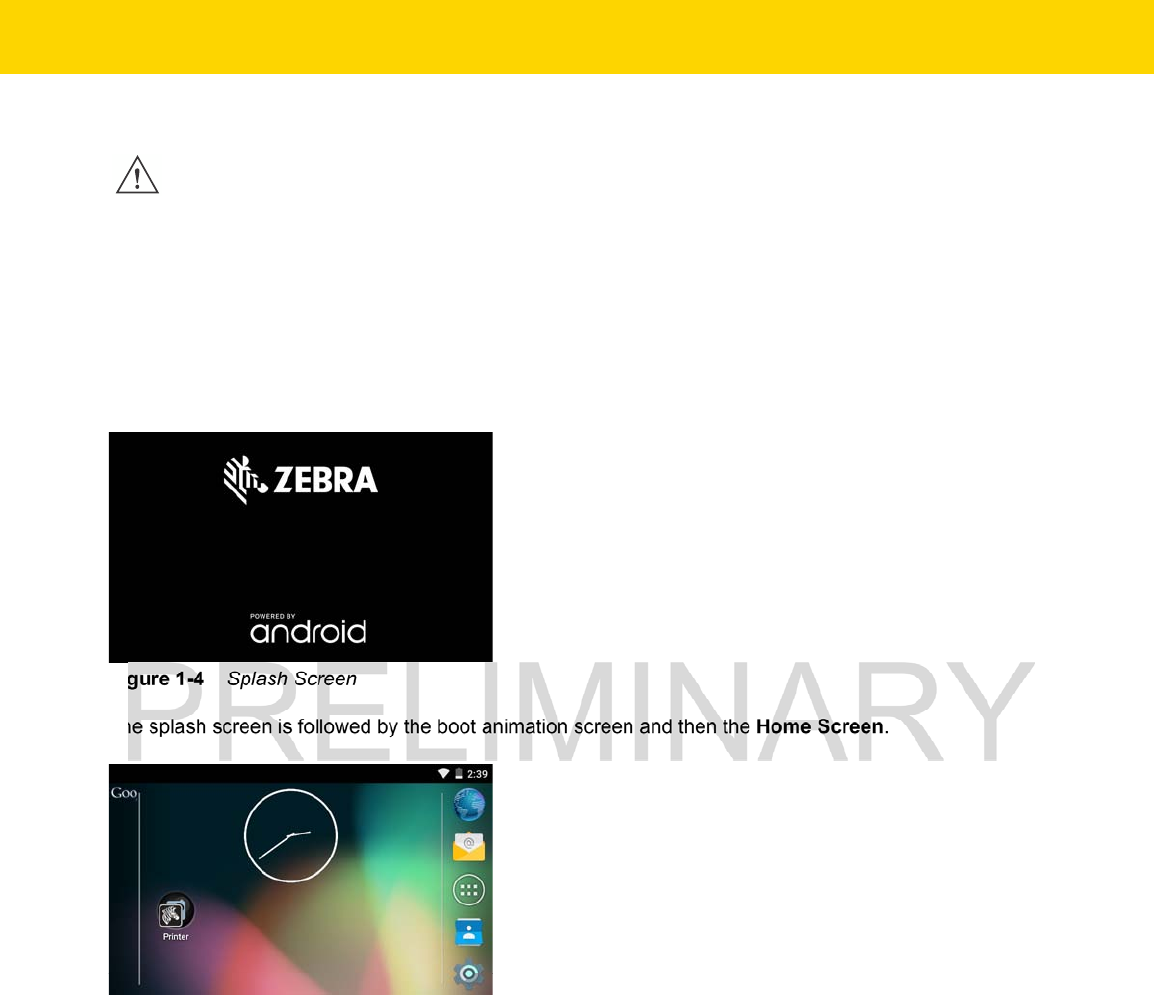
Getting Started 1 - 5
Starting the WT6000
When installed in a cradle, the WT6000 starts automatically as soon as power is applied.
When a charged battery is installed and the WT6000 is turned off, press the Power button to turn on.
When the WT6000 is powered on for the first time, it initializes its system. The splash screen appears for a short
period of time.
Figure 1-4 Splash Screen
The splash screen is followed by the boot animation screen and then the Home Screen.
Figure 1-5 Home Screen
IMPORTANT
When trying to power on the device, a quick red blink of the Charging LED indicates that it does not have
enough battery power to turn on. Charge the battery or replace it.
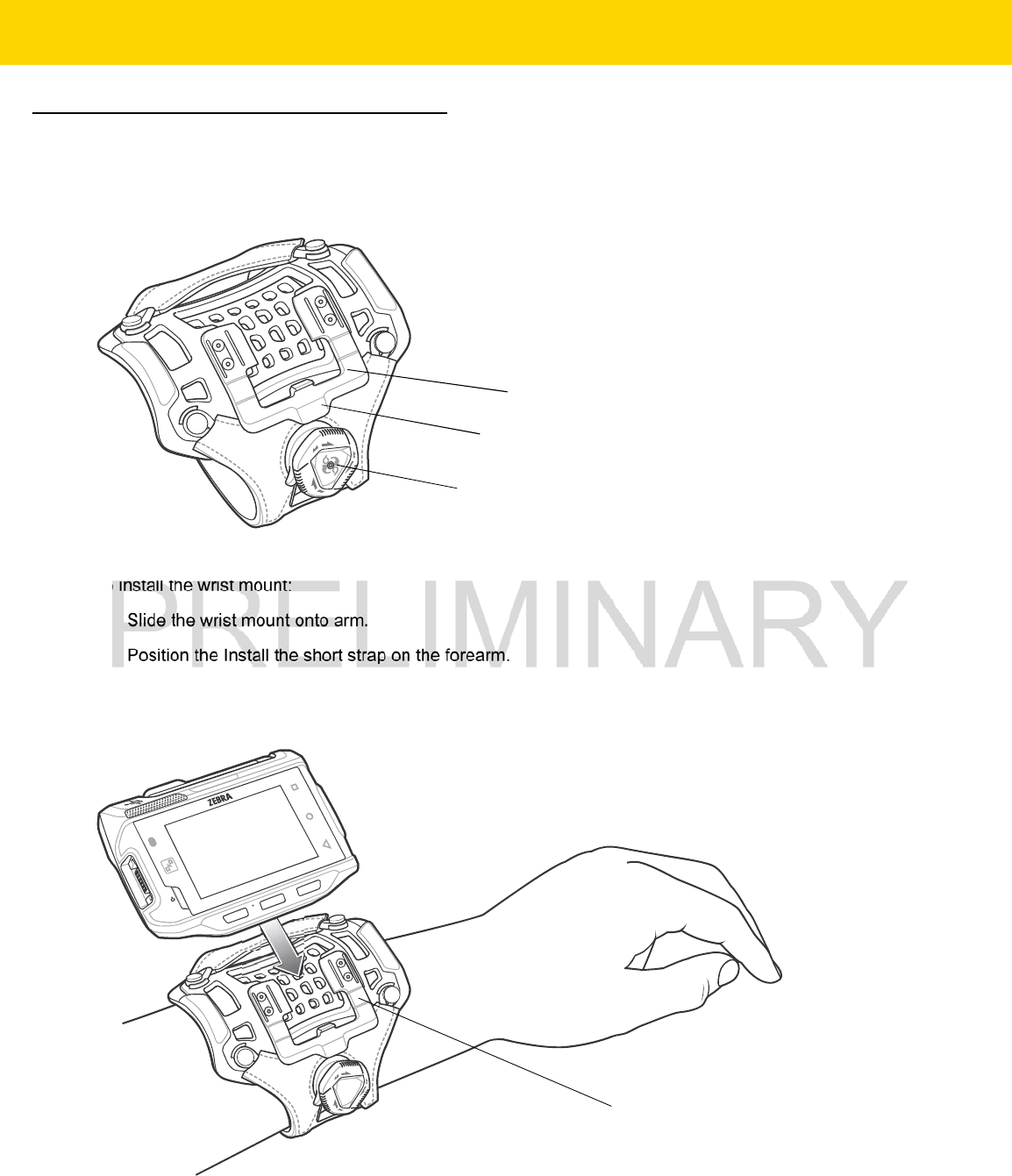
1 - 6 WT6000 User Guide
Installing the Wrist Mount
The wrist mount provides the mounting of the WT6000 on the forearm for hands-free applications. Refer to the
Wrist Mount Installation Guide for information on the wrist mount.
Figure 1-6 Wrist Mount
To install the wrist mount:
1. Slide the wrist mount onto arm.
2. Position the Install the short strap on the forearm.
3. Turn the dial clockwise to tighten. If too tight, turn counterclockwise to loose slightly.
4. Align the cleat on the back of the WT6000 with the mounting bracket on the wrist mount.
Figure 1-7 Aligning the Cleat
5. Slide the WT6000 onto the wrist mount until it clicks into place.
Mounting Bracket
Release Lever
Strap Tighten Dial
Mounting Bracket
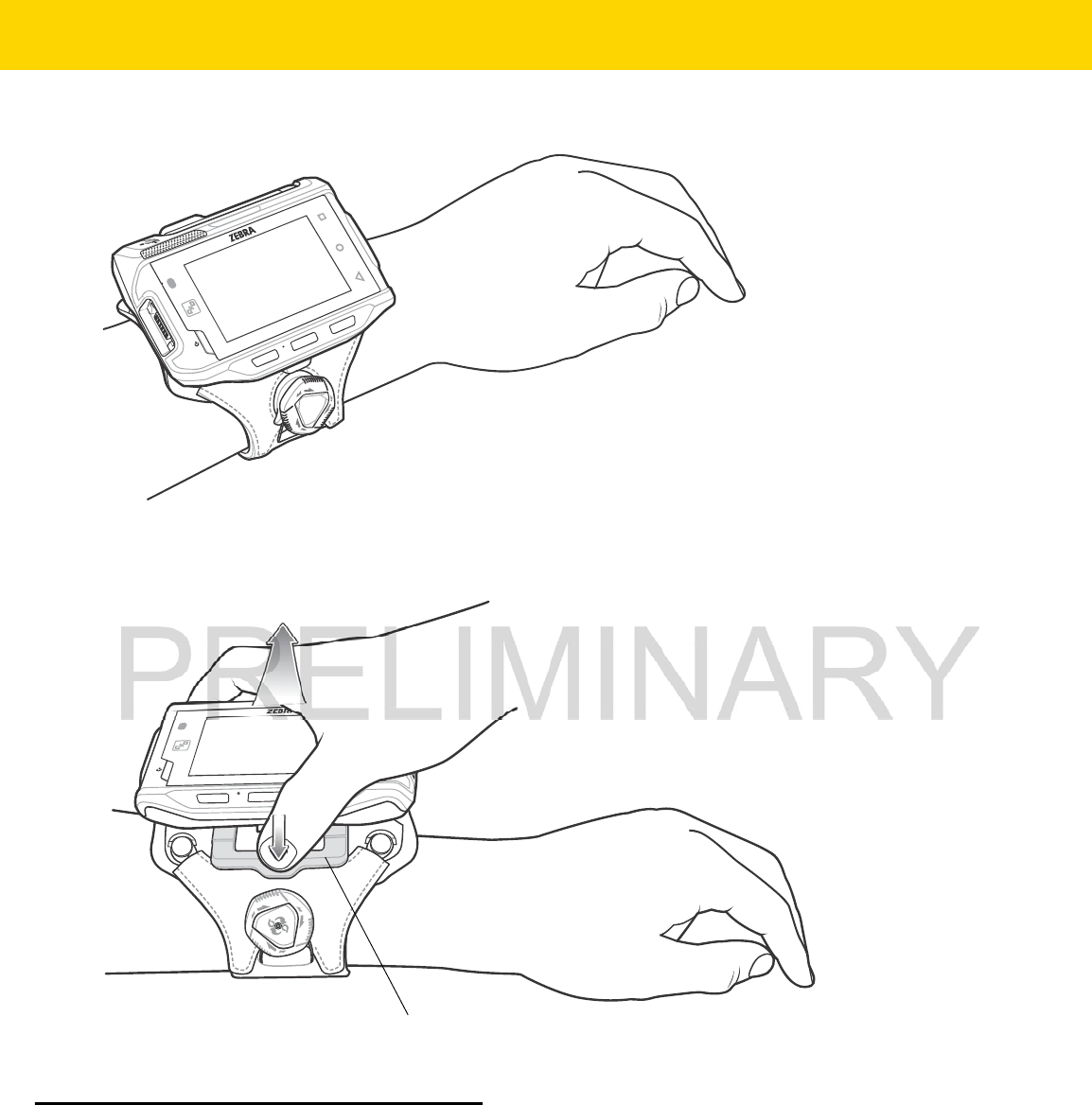
Getting Started 1 - 7
6. If necessary, use the dial to loosen and re-tighten the strap.
Figure 1-8 WT6000 and Wrist Mount
To remove the WT6000 from the wrist mount, press down on the release lever and slide the WT6000 out.
Figure 1-9 WT6000 Removal
Connecting a Scanner
The RS4000 scanner and the RS6000 imager can be used with the WT6000. See and RS409/RS419 Scanner on
page 5-8 for procedures for connecting the scanner to the WT6000. Refer to the RS6000 Product Reference Guide
for procedures for connecting the imager to the WT6000.
Release Lever
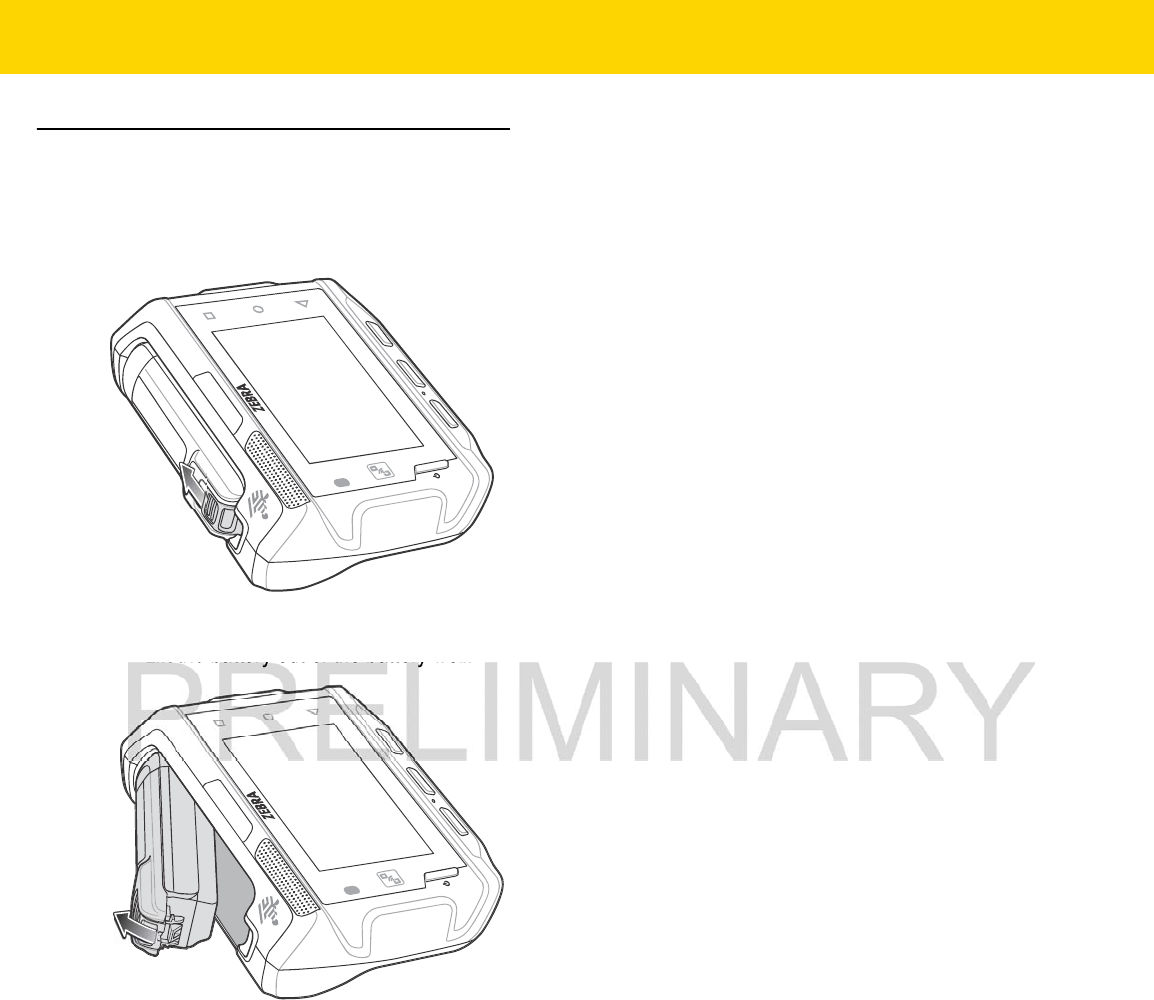
1 - 8 WT6000 User Guide
Replacing the Battery
To remove the battery:
1. Using finger tip, press the battery release latch toward the silver end of the battery.
Figure 1-10 Pull Release Latch Back
2. Lift the battery out of the battery well.
Figure 1-11 Battery Removal
3. Insert the silver end of the battery into the battery well.
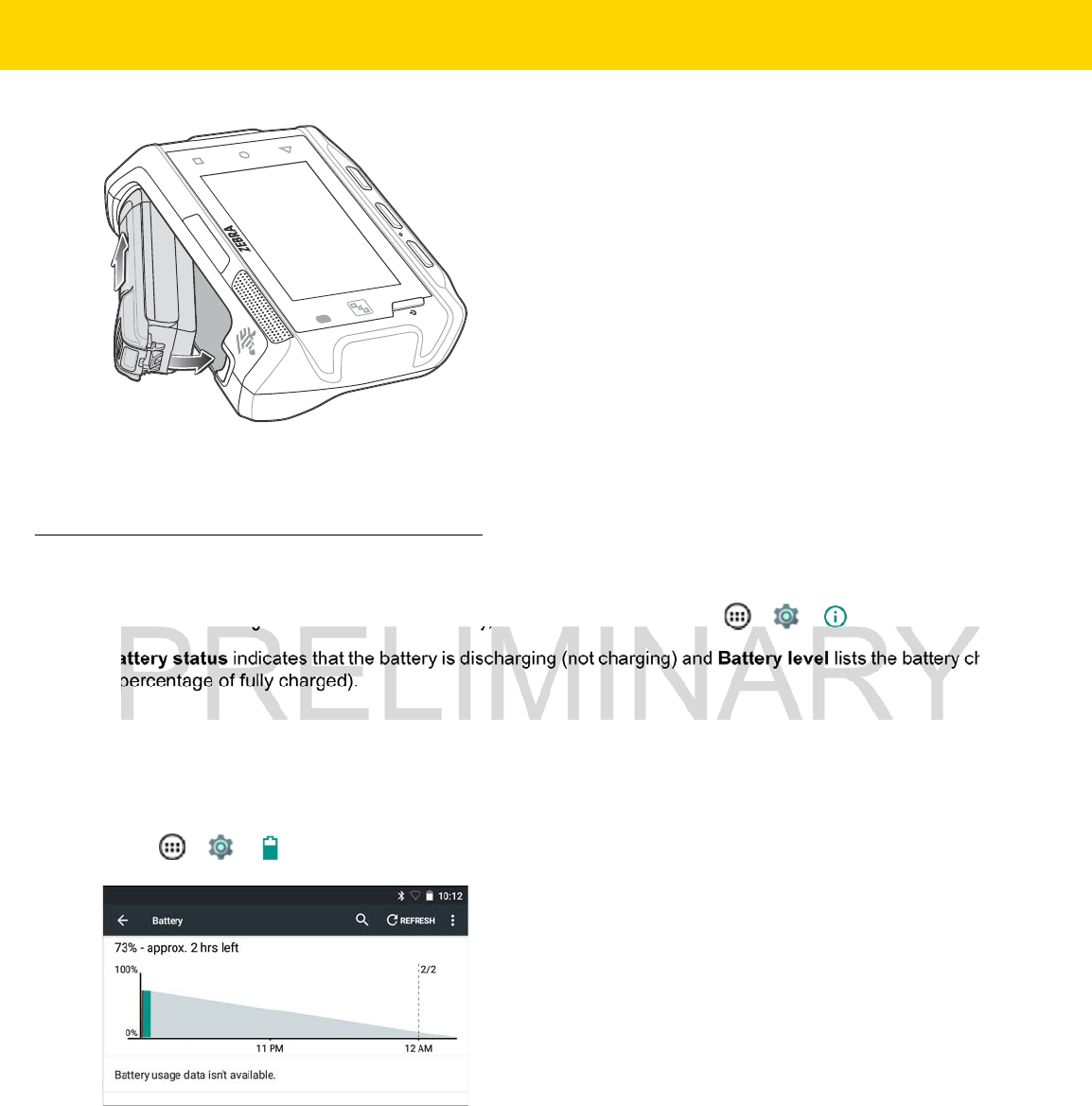
Getting Started 1 - 9
Figure 1-12 Battery Installation
4. Press the battery down until it snaps into place.
Battery Management
To check the charge status of the main battery, on the Home screen touch > > About device > Status.
Battery status indicates that the battery is discharging (not charging) and Battery level lists the battery charge (as
a percentage of fully charged).
Monitor Battery Usage
The Battery screen lists which applications consume the most battery power. Also use it to turn off applications that
were downloaded if they are consuming too much power.
Touch > > Battery.
Figure 1-13 Battery Screen
The Battery screen lists the applications using the battery. The discharge graph at the top of the screen shows the
rate of the battery discharge since last charged (short periods of time when connected to a charger are shown as
thin green lines at the bottom of the chart), and how long it has been running on battery power.
Touch an application in the Battery screen to display details about its power consumption. Different applications
display different information. Some applications include buttons that open screens with settings to adjust power
use.
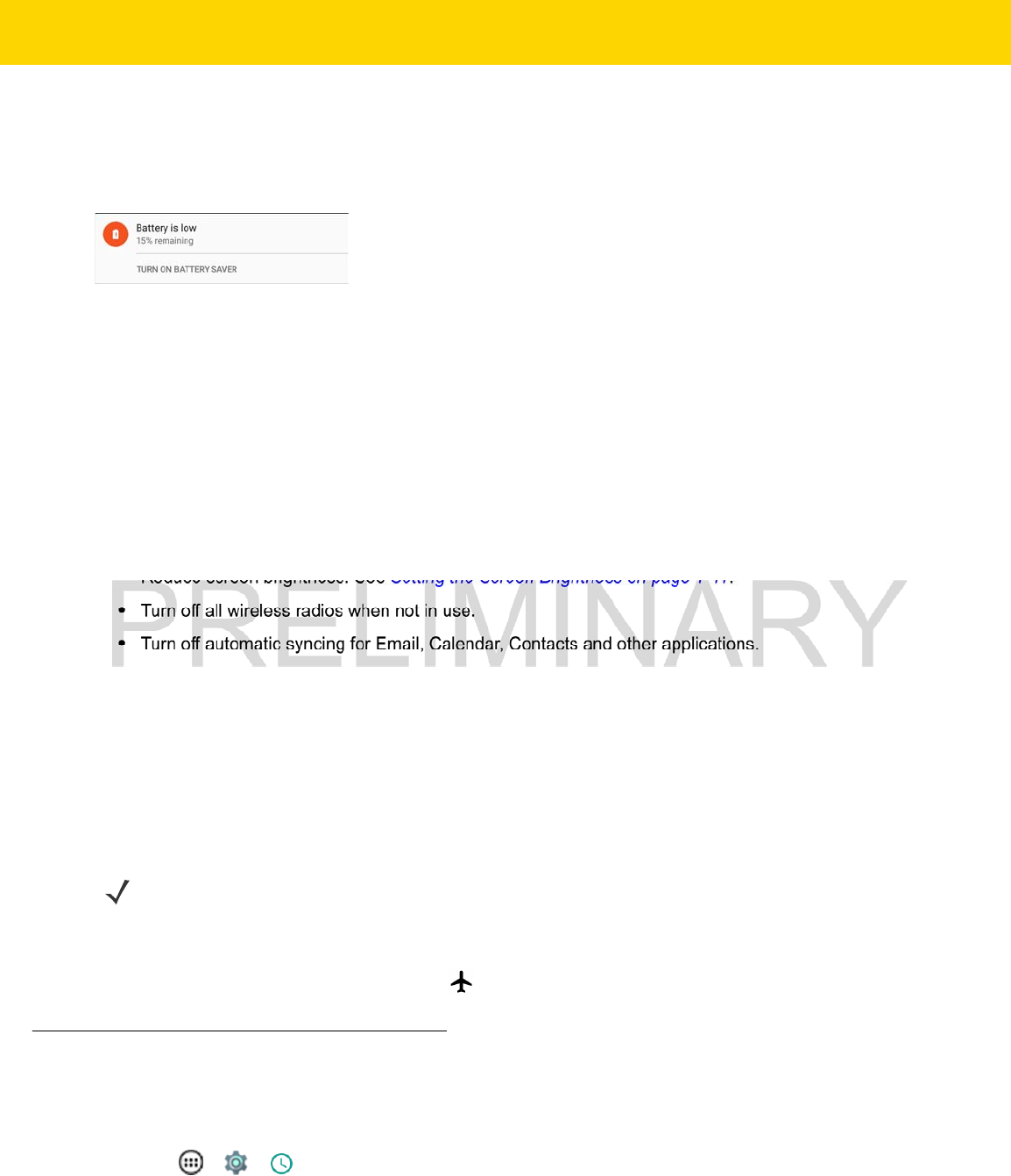
1 - 10 WT6000 User Guide
Low Battery Notification
When the battery charge level drops below 15%, the WT6000 displays a notice to connect the WT6000 to power.
Place the WT6000 into a cradle to charge the battery.
Figure 1-14 Low Battery Notification
When the battery charge drops below 10%, the WT6000 displays a notice to connect the WT6000 to power. The
user must charge the battery using one of the charging accessories.
When the battery charge drops below 5%, the WT6000 turns off. Place the WT6000 into a cradle to charge the
battery.
Battery Optimization
Observe the following battery saving tips:
•
Set the screen to turn off after a short period of non-use. See Setting Screen Timeout Setting on page 1-11.
•
Reduce screen brightness. See Setting the Screen Brightness on page 1-11.
•
Turn off all wireless radios when not in use.
•
Turn off automatic syncing for Email, Calendar, Contacts and other applications.
•
Use the Power Control widget to check and control the status of radios, the screen brightness, and syncing.
•
Minimize use of applications that keep the WT6000 from suspending, for example, music and video
applications.
Turning Off the Radios
To turn off all the radios:
1. Press the power button until the menu appears.
2. Touch Airplane mode. The airplane icon appears in the Status bar indicating that all the radios are off.
Setting the Date and Time
The date and time is automatically synchronized using a NITZ server when the WT6000 is connected to a Wi-Fi
network. To manually change the date and time:
1. Touch > > Date & time.
2. Touch Automatic date & time to disable automatic date and time synchronization.
3. Touch Set date.
NOTE
Alternately, you can place the device into Airplane mode using the Quick Settings option.
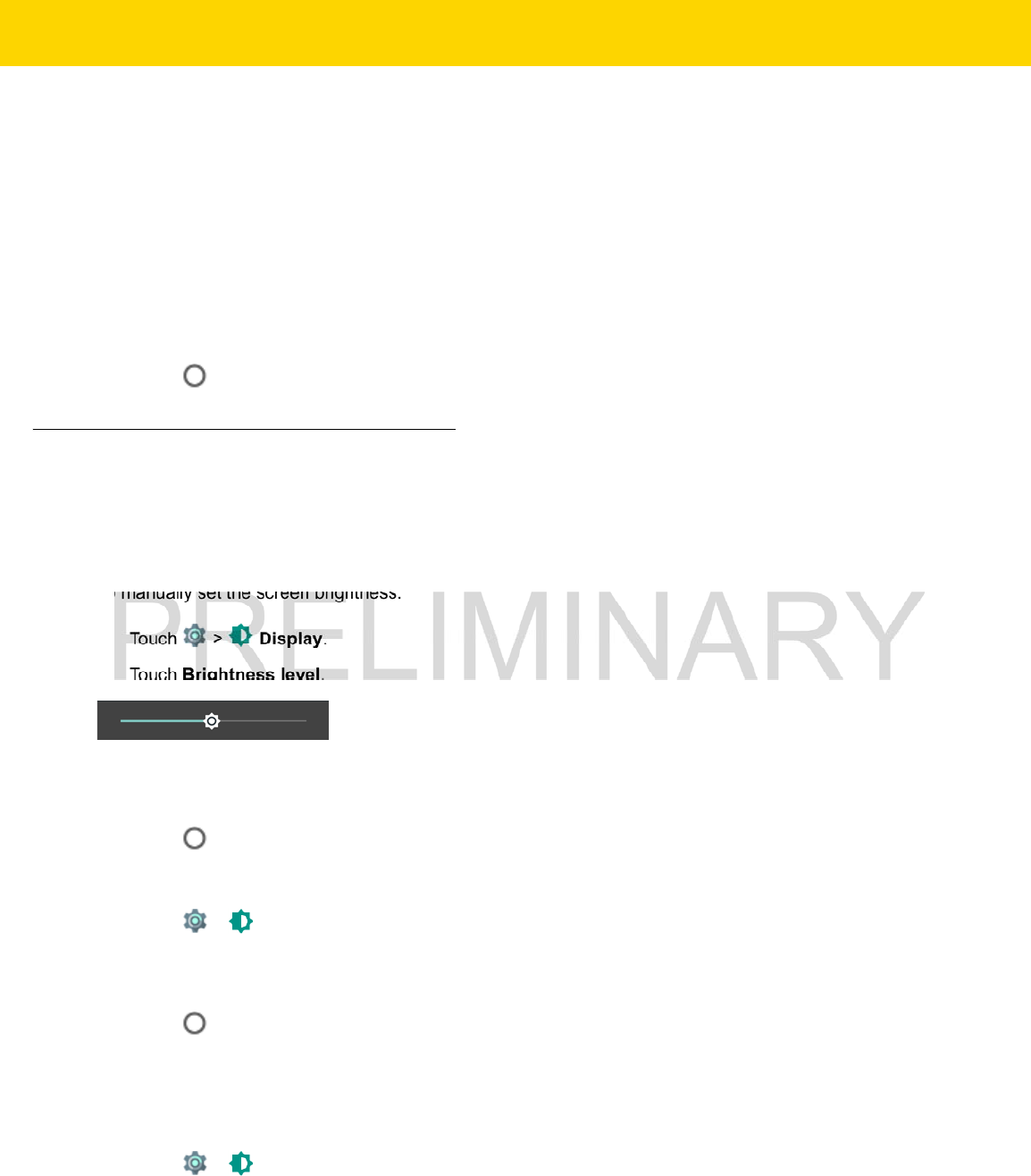
Getting Started 1 - 11
4. Move the sliders up and down to select the month, date and year.
5. Touch Done.
6. Touch Set time.
7. Move the sliders up and down to select the hour, minutes and part of the day.
8. Touch Done.
9. Touch Select time zone.
10. Select the current time zone from the list.
11. Touch .
Display Setting
Use Display settings to change the screen brightness, set sleep time and change font size.
Setting the Screen Brightness
To manually set the screen brightness:
1. Touch > Display.
2. Touch Brightness level.
Figure 1-15 Brightness Dialog Box
3. Use the slider to set a brightness level.
4. Touch .
To automatically set the screen brightness:
1. Touch > Display.
2. Touch Adaptive brightness. The control switch moves to the right and turns green indicating the option is
enabled.
3. Touch .
Setting Screen Timeout Setting
To set the screen sleep time:
1. Touch > Display > Sleep.
2. Select one of the sleep values.
•
15 seconds
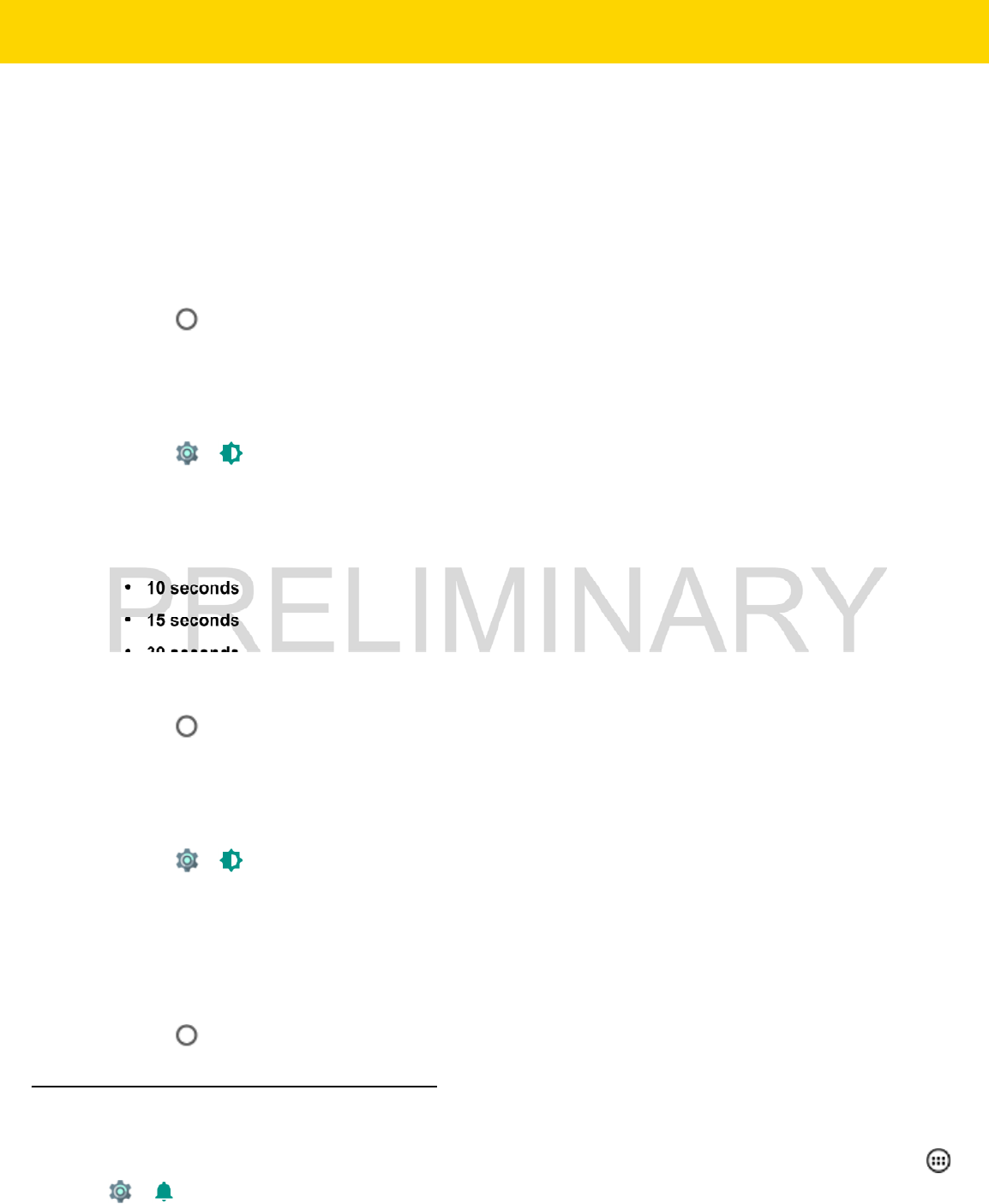
1 - 12 WT6000 User Guide
•
30 seconds
•
1 minute
•
2 minutes
•
5 minutes (default)
•
10 minutes
•
30 minutes.
3. Touch .
Setting Key Light Timeout Setting
To set the key light sleep time:
1. Touch > Display > Key light timeout setting.
2. Select one of the sleep values.
•
Always on
•
6 seconds (default)
•
10 seconds
•
15 seconds
•
30 seconds
•
1 minute.
3. Touch .
Setting Font Size
To set the size of the font is system applications:
1. Touch > Display > Font size.
2. Select one of the font size values.
•
Normal (default)
•
Large
•
Huge.
3. Touch .
General Sound Setting
Use the Sounds & notifications settings to configure media and alarm volumes. On the Home screen, touch
> > Sounds.
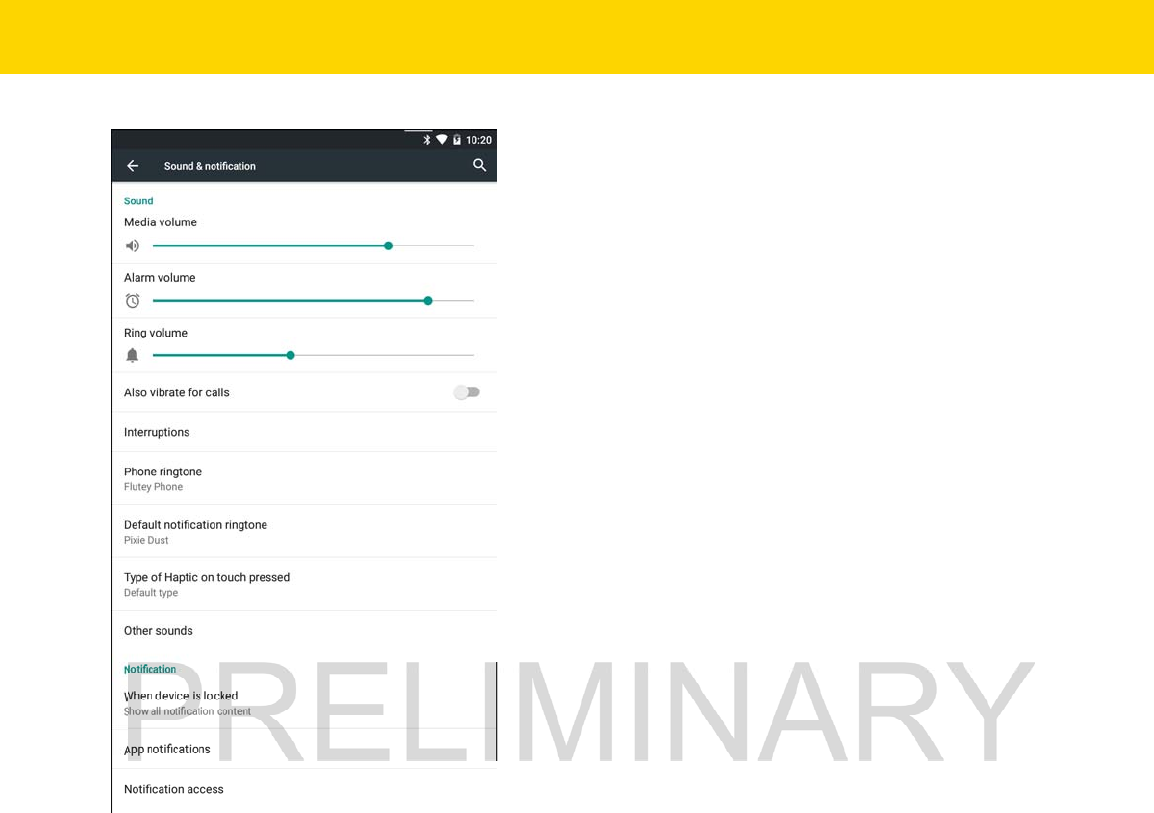
Getting Started 1 - 13
Figure 1-16 Sounds Screen
•
Sound
• Zebra Volume Control
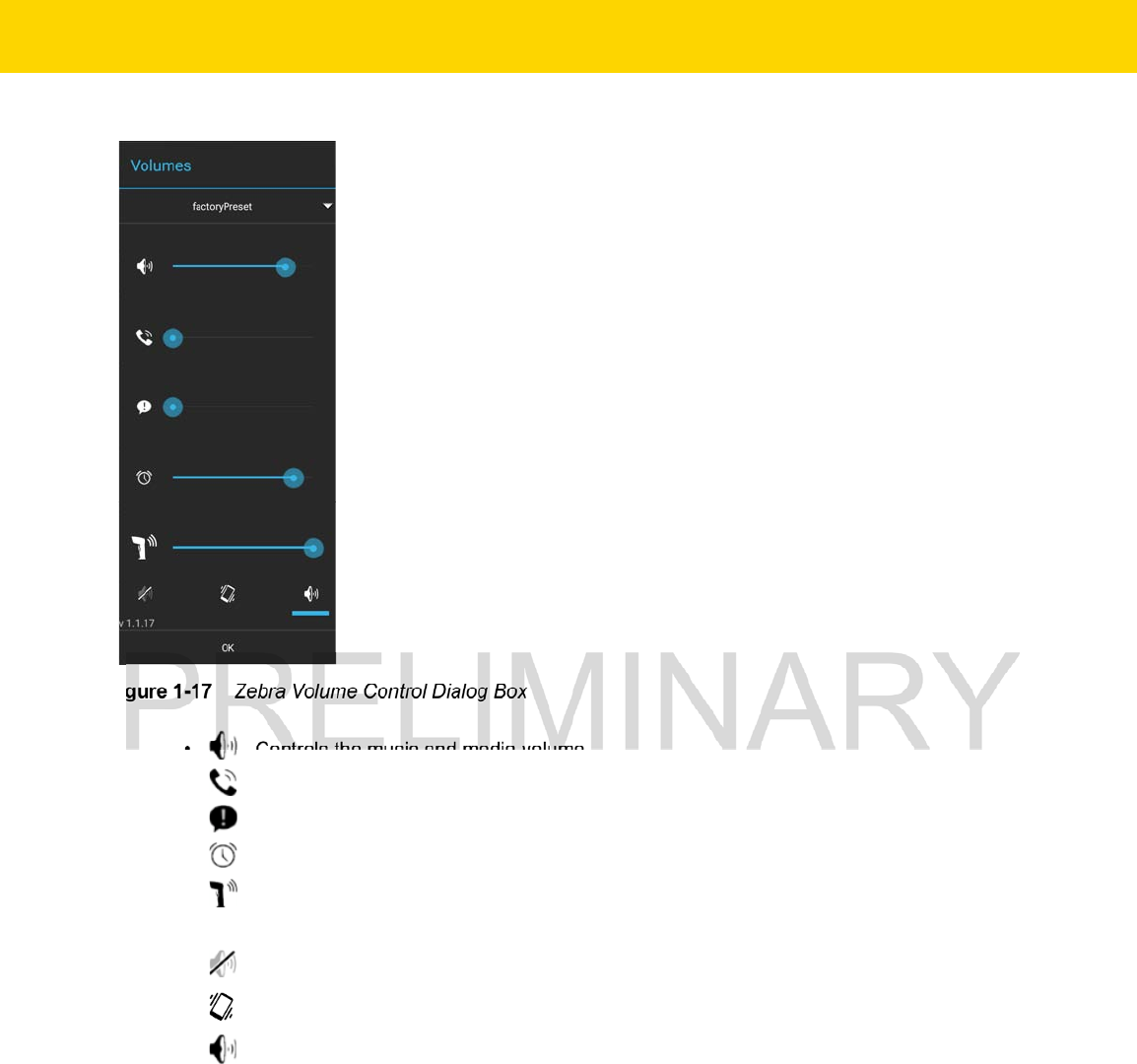
1 - 14 WT6000 User Guide
Figure 1-17 Zebra Volume Control Dialog Box
• - Controls the music and media volume.
• - Controls the ringtone volume.
• - Controls the system notification volume.
• - Controls the alarm clock volume.
• - Controls the scan good decode beep volume.
•Bottom row icons:
• - Places all sounds except media and alarms in silence mode.
• - Places all sounds except media and alarms in vibrate mode.
• - Places all sounds in sound mode.
• Also vibrate for calls - Touch to enable the WT6000 to also vibrate on incoming calls.
• Interruptions - Use to prioritize sound notifications. Touch the settings to turn call and message
interruptions on or off.
If user turns Messages notifications on, touch Calls/messages from to specify from whom to accept
notifications (Anyone, Starred contacts only or Contacts Only).
In Downtime section, select which days and times to allow for sound notifications.
• Phone ringtone - Touch to select a sound to play on incoming calls.
• Default notification ringtone - Touch to select a sound to play for all system notifications.
• Type of Heptic on touch pressed - Touch to select the type of haptic feedback when user touch the
Back, Home and Recent buttons.
•Type2 25ms, 45ms, 10ms - Long vibration.
•Type3 30ms, 260ms, 10ms - Medium vibration.

Getting Started 1 - 15
•Default type - Short vibration.
• Other sounds
•Dial pad tones - (default – enabled)
•Screen locking sounds - plays a sound when locking and unlocking the screen (default – enabled)
•Touch sounds - Plays a sound when making screen selections (default – enabled).
•Vibrate on touch - Vibrates when making screen selections (default – enabled).
•
Notification
• When device is locked - Manage whether notifications can be seen when the WT6000 is locked.
•Show all notification content -
•Don’t show notifications at all -
• App notification - Modify the notification settings individually for an application. The setting under When
device is locked always takes precedence over the setting for an individual application.
• Notification access - Displays which applications can access notifications.
When a notification arrives, its icon appears at the top of the screen. Icons for pending notifications appear
on the left, and system icons on the right.

1 - 16 WT6000 User Guide
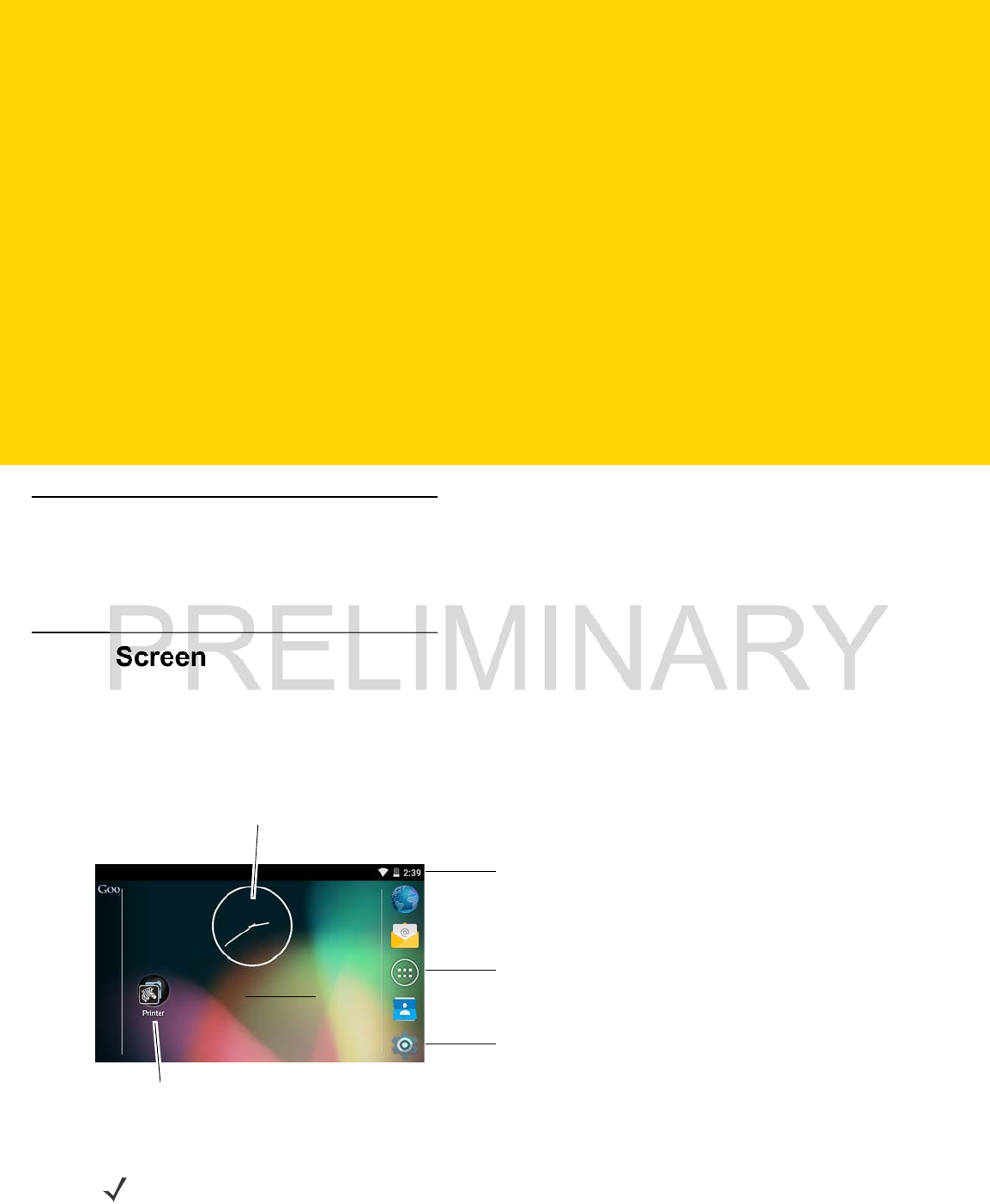
CHAPTER 2 USING THE WT6000
Introduction
This chapter describes the screens, status and notification icons, and controls on the WT6000, and provides basic
instructions for using the WT6000.
Home Screen
The Home screen displays when the WT6000 turns on. Depending upon the configuration, the Home screen might
appear different. Contact your system administrator for more information.
After a suspend or screen time-out, the Home screen displays with the lock sliders. Slide to the right toward to
unlock the screen. For screen locking information see Un-Locking the Screen on page 2-9.
Figure 2-1 Home Screen
Status Bar
2
Widget
All App Icon
Setting Icon
Shortcut Icon
NOTE
The Home screen icons can be configured by the user and may look different than shown.
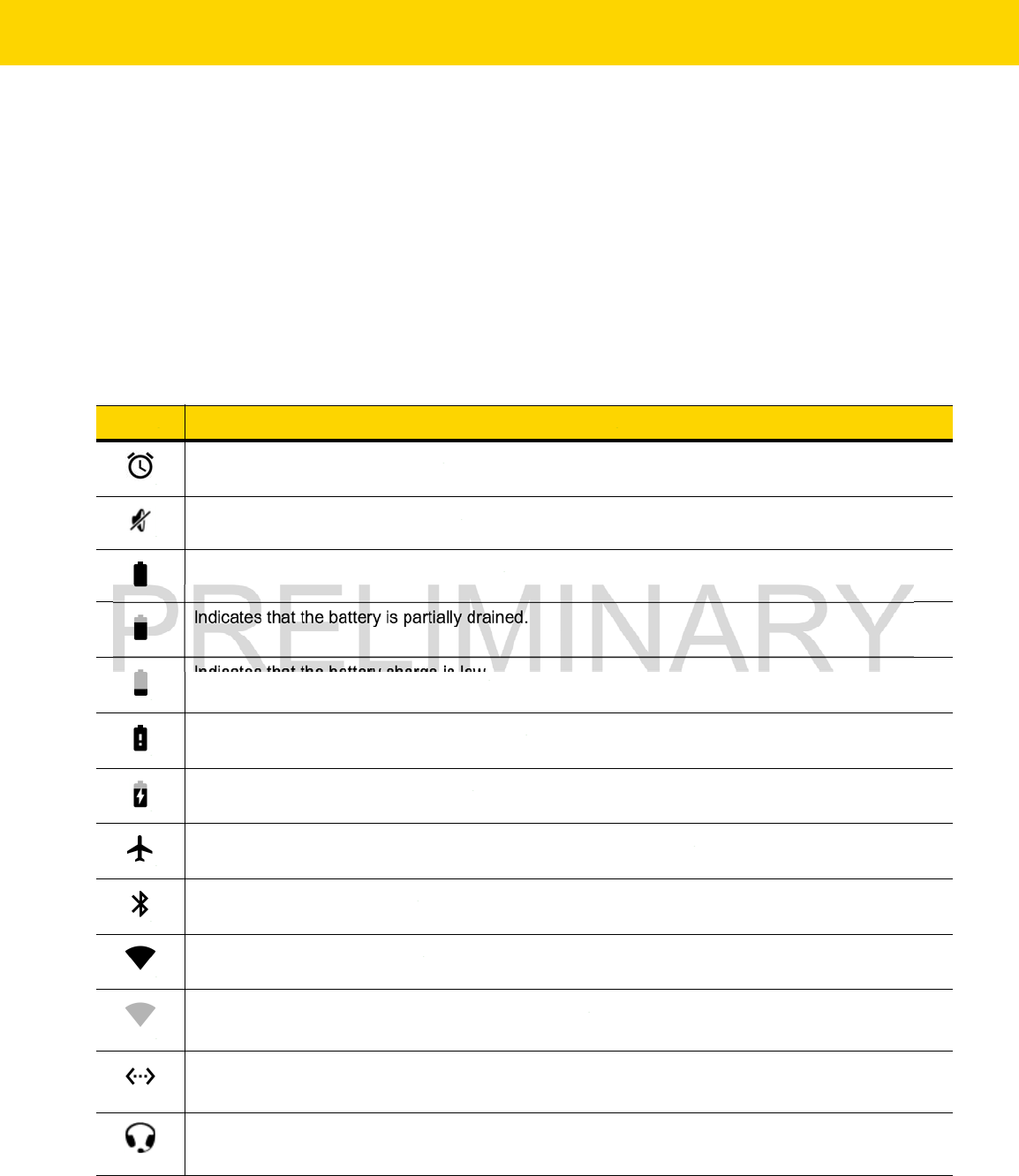
2 - 2 WT6000 User Guide
The Home screen provides four additional screens for placement of widgets and shortcuts. Swipe the screen left or
right to view the additional screens.
Status Bar
The Status bar displays the time, notification icons (left side) and status icons (right side).
If there are more notifications than can fit in the Status bar, displays indicating that more notifications exist. Open
the Notifications panel to view all notifications and status.
Status Icons
Table 2-1 Status Icons
Icon Description
Indicates that the Alarm is active.
Indicates that the ringer is silenced.
Indicates that the battery is fully charged.
Indicates that the battery is partially drained.
Indicates that the battery charge is low.
Indicates that the battery charge is very low.
Indicates that the battery is charging.
Indicates that the Airplane Mode is active. All radios are turned off.
Indicates that Bluetooth is on.
Connected to a Wi-Fi network.
Not connected to a Wi-Fi network or no Wi-Fi signal.
Connected to an Ethernet network.
Headset audio cable is connected to the WT6000.
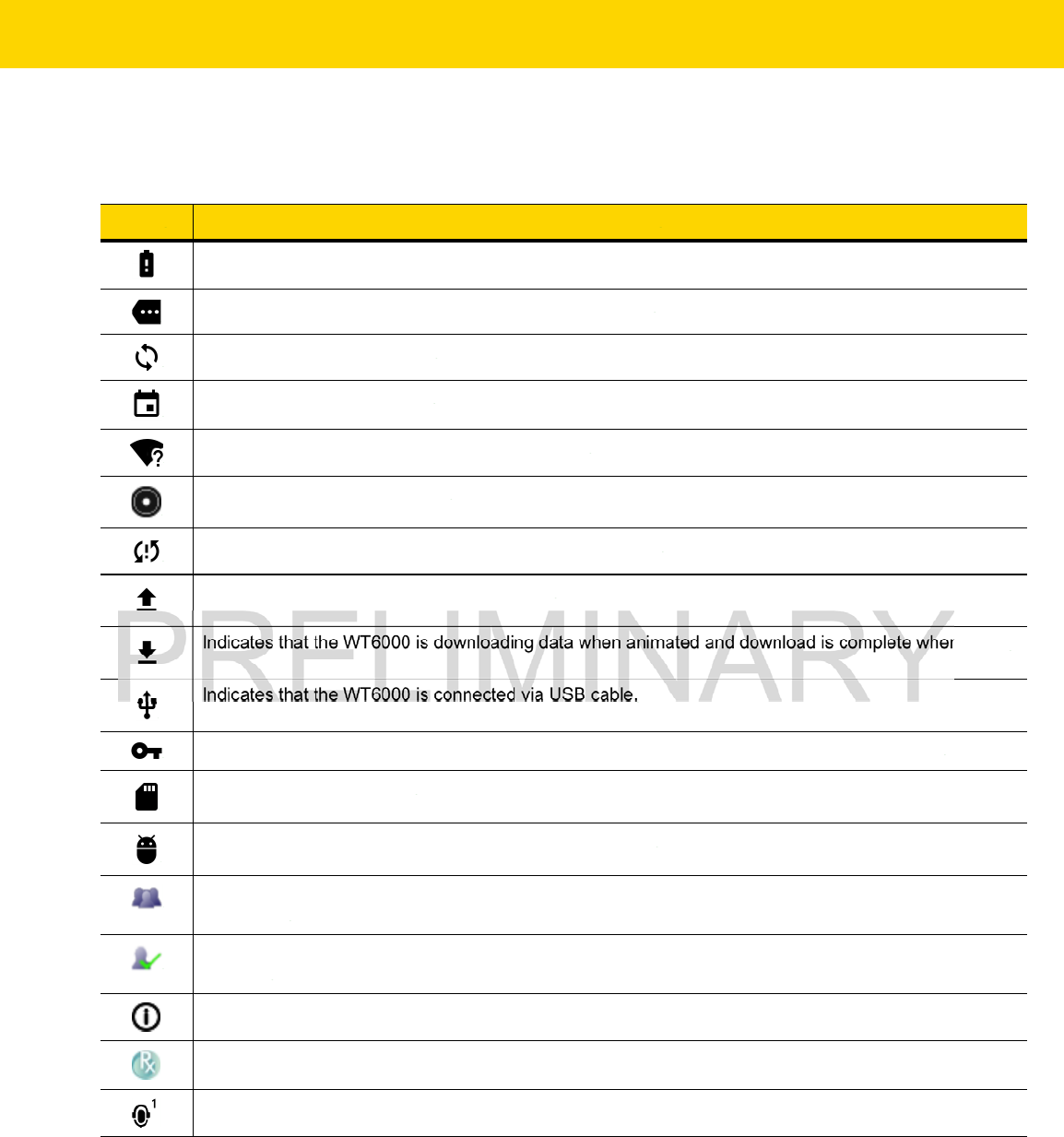
Using the WT6000 2 - 3
Notification Icons
Managing Notifications
Notification icons report the arrival of new messages, calendar events, and alarms, as well as ongoing events.
When a notification occurs, an icon may appear in the Status bar with a brief description. See Notification Icons on
page 2-3 for a list of possible notification icons and their description. Open the Notifications panel to view a list of all
the notifications.
Table 2-2 Notification Icons
Icon Description
Indicates battery is low.
Indicates that more notifications are available for viewing.
Indicates that data is syncing.
Indicates an upcoming event.
Indicates that an open Wi-Fi network is available.
Indicates that a song is playing.
Indicates that a problem with sign-in or sync has occurred.
Indicates that the WT6000 is uploading data.
Indicates that the WT6000 is downloading data when animated and download is complete when static.
Indicates that the WT6000 is connected via USB cable.
Indicates that the WT6000 is connected to or disconnected from virtual private network (VPN).
Preparing Internal Storage.
Indicates that USB debugging is enabled on the WT6000.
Indicates that the MultiUser feature is enabled. Appears only when MultiUser Administrator application
is installed.
Indicates that a new user is logging in. Appears only when MultiUser Administrator application is
installed.
Indicates that the WT6000 is connected to a cable or cradle.
Indicates that the RxLogger application is running and capturing data.
Indicates PTT Express is active. See
PTT Express Voice Client on page 5-5
for more information.
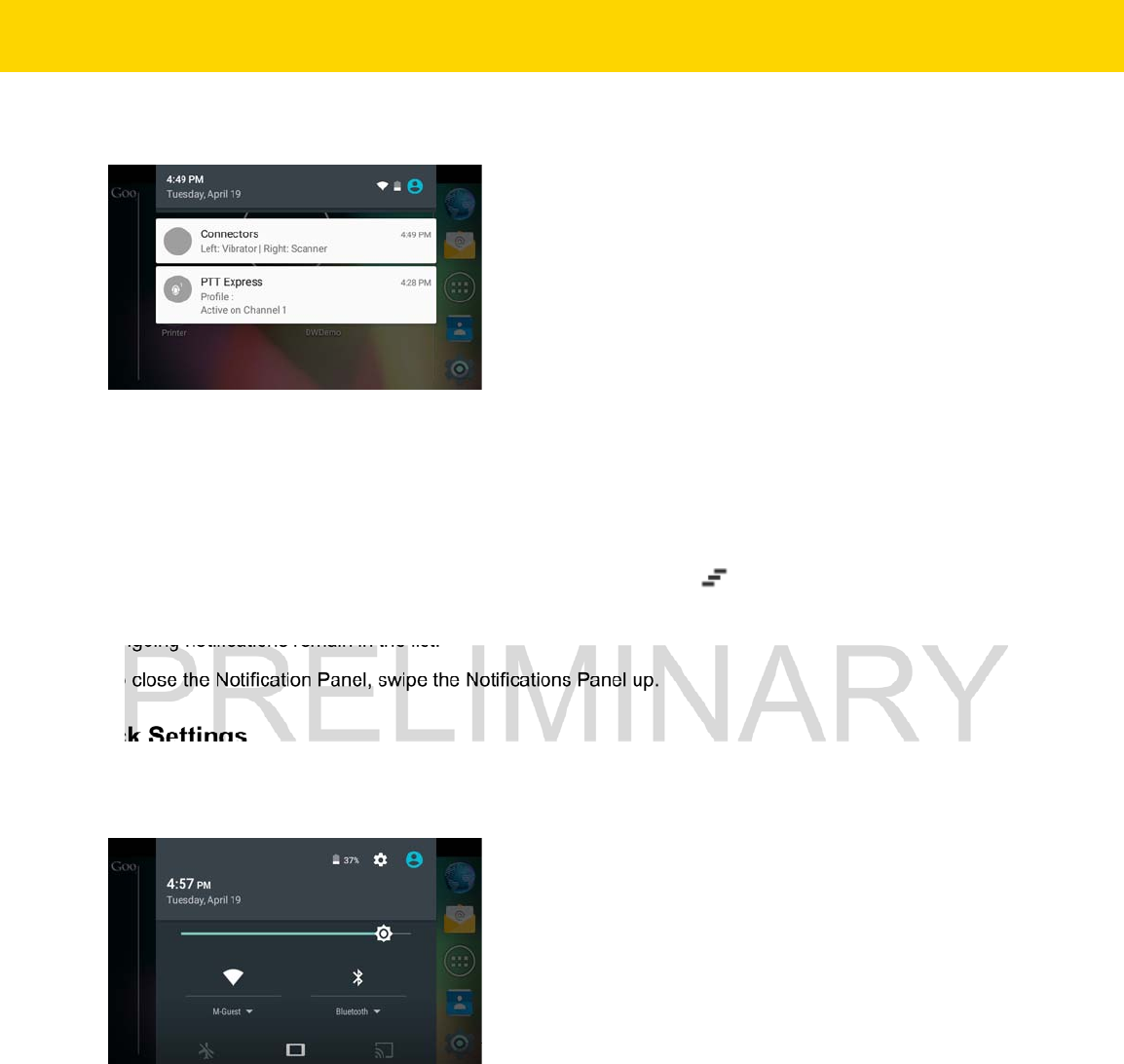
2 - 4 WT6000 User Guide
To open the Notification panel, drag the Status bar down from the top of the screen.
Figure 2-2 Notification Panel
The WT6000 provides notifications when the user connects an accessory or cables into the interface connectors.
The notification list the connector and the type of cable.
To respond to a notification, open the Notifications Panel and then touch a notification. The Notifications Panel
closes and the subsequent activity is dependent on the notification.
To clear all notifications, open the Notifications Panel and then touch . All event-based notifications are
removed.
Ongoing notifications remain in the list.
To close the Notification Panel, swipe the Notifications Panel up.
Quick Settings
Use Quick Settings to get to frequently used settings, like turning on airplane mode. To open Quick Settings, swipe
down from the top of the screen with two fingers or twice with one finger.
Figure 2-3 Quick Settings
To change a setting, just touch the icon:
•
Display brightness: Slide to lower or increase the brightness of the screen.
•
Wi-Fi network: Turn Wi-Fi on or off. To open Wi-Fi settings, touch the Wi-Fi network name.
•
Bluetooth settings: Turn Bluetooth on or off. To open Bluetooth settings, touch the Bluetooth.
•
Airplane mode: Turn airplane mode on or off. Airplane mode means device will not connect to Wi-Fi or
Bluetooth.
•
Auto-rotate: Lock the device’s orientation in portrait or landscape mode or set to automatically rotate.

Using the WT6000 2 - 5
Using the Touchscreen
Use the multi-tap sensitive screen to operate the device.
•
Tap - Tap to:
•select items on the screen
•type letters and symbols using the on-screen keyboard
•press on-screen buttons.
•
Tap and Hold - Tap and hold:
•an item on the Home screen to move it to a new location or to the trash.
•an item in Apps to create a shortcut on the Home screen.
•the Home screen to open a menu for customizing the Home screen.
•an empty area on the Home screen until the menu appears.
•
Drag - Tap and hold an item for a moment and then move finger on the screen until reaching the new
position.
•
Swipe - Move finger up and down or left and right on the screen to:
•unlock the screen
•view additional Home screens
•view additional application icons in the Launcher window
•view more information on an application’s screen.
•
Double-tap - Tap twice on a web page, map, or other screen to zoom in and out.
•
Pinch - In some applications, zoom in and out by placing two fingers on the screen and pinching them
together (to zoom out) or spreading them apart (to zoom in).
Using the On-screen Keyboard
Use the on-screen keyboard to enter text in a text field. To configure the keyboard settings, touch and hold
(comma) > and then select Android keyboard settings.
Editing Text
Edit entered text and use menu commands to cut, copy, and paste text within or across applications. Some
applications do not support editing some or all of the text they display; others may offer their own way to select text.
Entering Numbers, Symbols and Special Characters
To enter numbers and symbols:
•
Touch and hold one of the top-row keys until a menu appears then select a number. Keys with alternate
characters display an ellipsis ( ... ) below the character.
•
Touch and hold the Shift key with one finger, touch one or more capital letters or symbols to enter them, and
then lift both fingers to return to the lowercase keyboard.
•
Touch to switch to the numbers and symbols keyboard.
•
Touch the key on the numbers and symbols keyboard to view additional symbols.
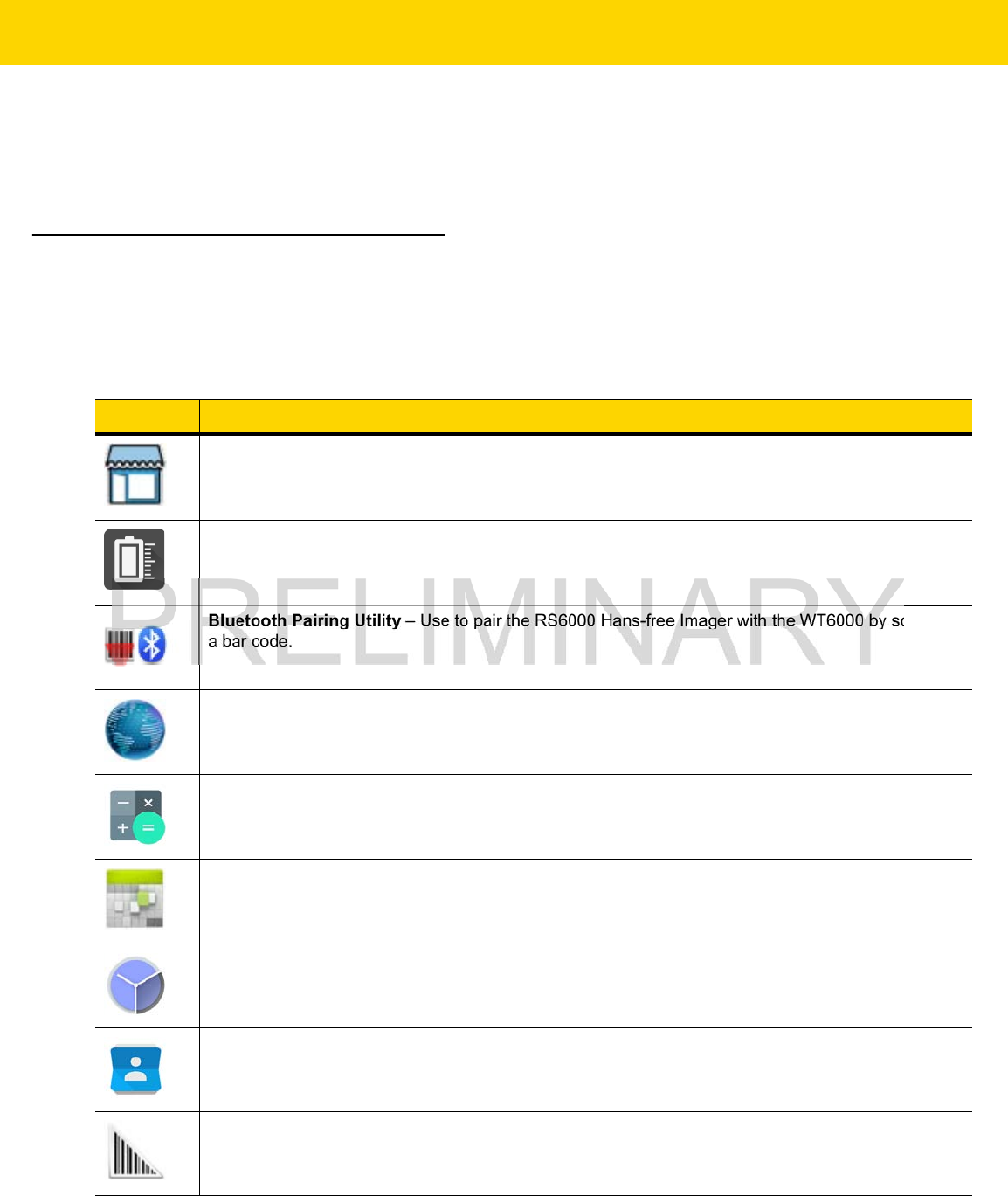
2 - 6 WT6000 User Guide
To enter special characters, touch and hold a number or symbol key to open a menu of additional symbols.
•
A larger version of the key displays briefly over the keyboard.
•
Keys with alternate characters display an ellipsis ( ... ) below the character.
Applications
The APPS screen displays icons for all installed applications. The table below lists the applications installed on the
WT6000. Refer to the WT6000 Integrator Guide for information on installing and uninstalling application.
Table 2-3 Applications
Icon Description
App Gallery
- Provides links to utilities and demonstration applications that can be installed on the
WT6000.
Battery Manager
- Displays battery information, including charge level, status, health and wear level.
Bluetooth Pairing Utility
– Use to pair the RS6000 Hans-free Imager with the WT6000 by scanning
a bar code.
Browser
- Use to access the Internet or intranet.
Calculator
- Provides the basic and scientific arithmetic functions.
Calendar
- Use to manage events and appointments.
Clock
- Use to schedule alarms for appointments or as a wake-up.
Contacts
- Use to manage contact information.
DataWedge
- Enables data capture using the imager.
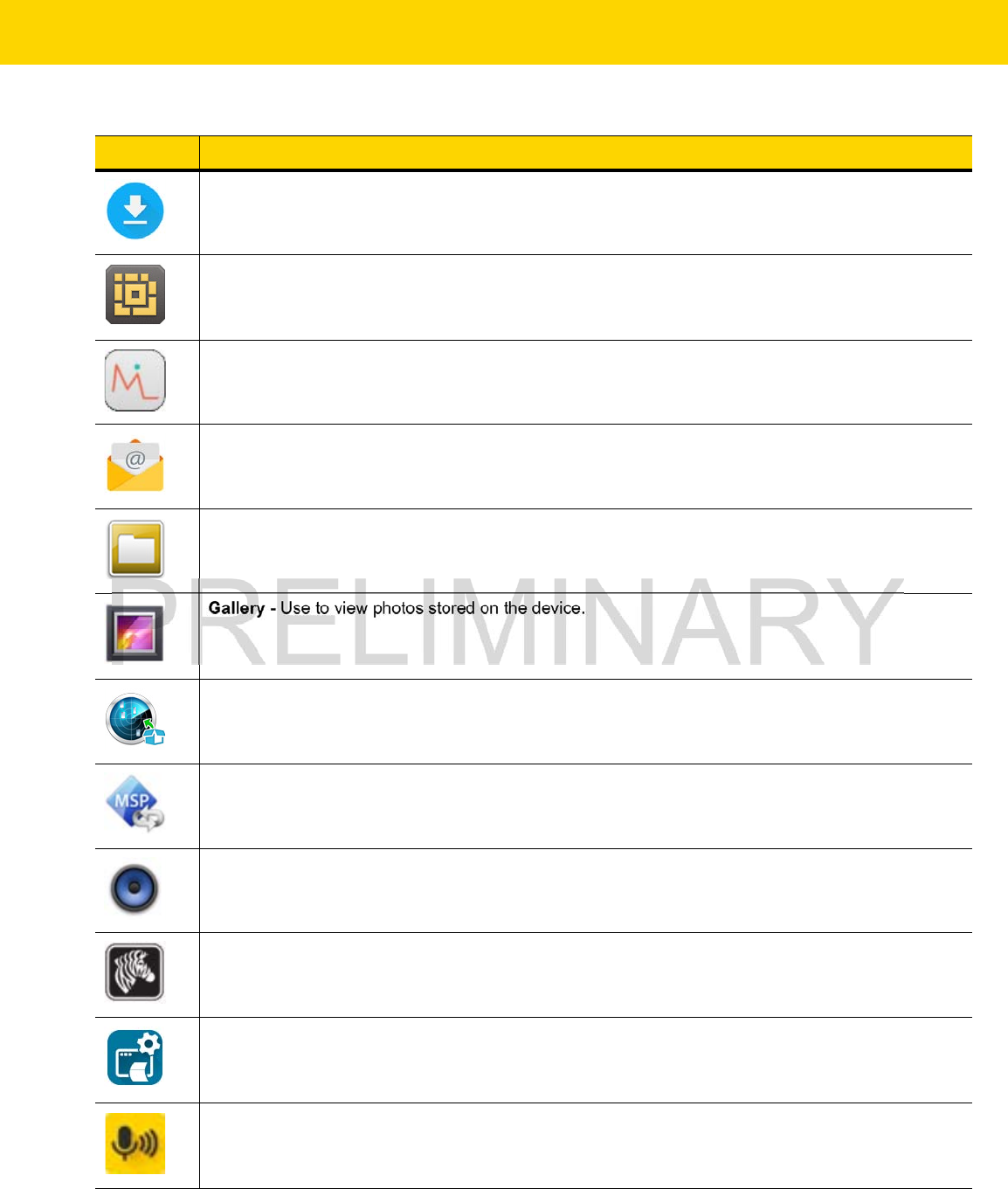
Using the WT6000 2 - 7
Downloads
- Lists all downloads files.
DWDemo
- Provides a way to demonstrate the data capture features using the imager. See
DataWedge Demonstration on page 5-9
for more information.
elemez
- Use to provide diagnostic information. See
Elemez on page 5-12
for more information.
Email
- Use to send and receive email.
File Browser
- Organize and manage files on the WT6000. See
File Browser on page 5-3
for more
information.
Gallery
- Use to view photos stored on the device.
Mobi Control Stage
– Opens the
Mobi Control Stage
application to stage the device.
MSP Agent
- Enables management of the WT6000 from an MSP server. Requires the purchase of an
appropriate MSP client license per device to suit the level of management functionality required.
Music
- Play music stored on the device.
Print Station
- Use to print labels and receipts directly to a Zebra ZPL printer via USB, Bluetooth or
WLAN.
Printer Setup
- Use to connect to a Zebra printer.
PTT Express
- Use to launch PTT Express client for VoIP communication.
Table 2-3 Applications (Continued)
Icon Description
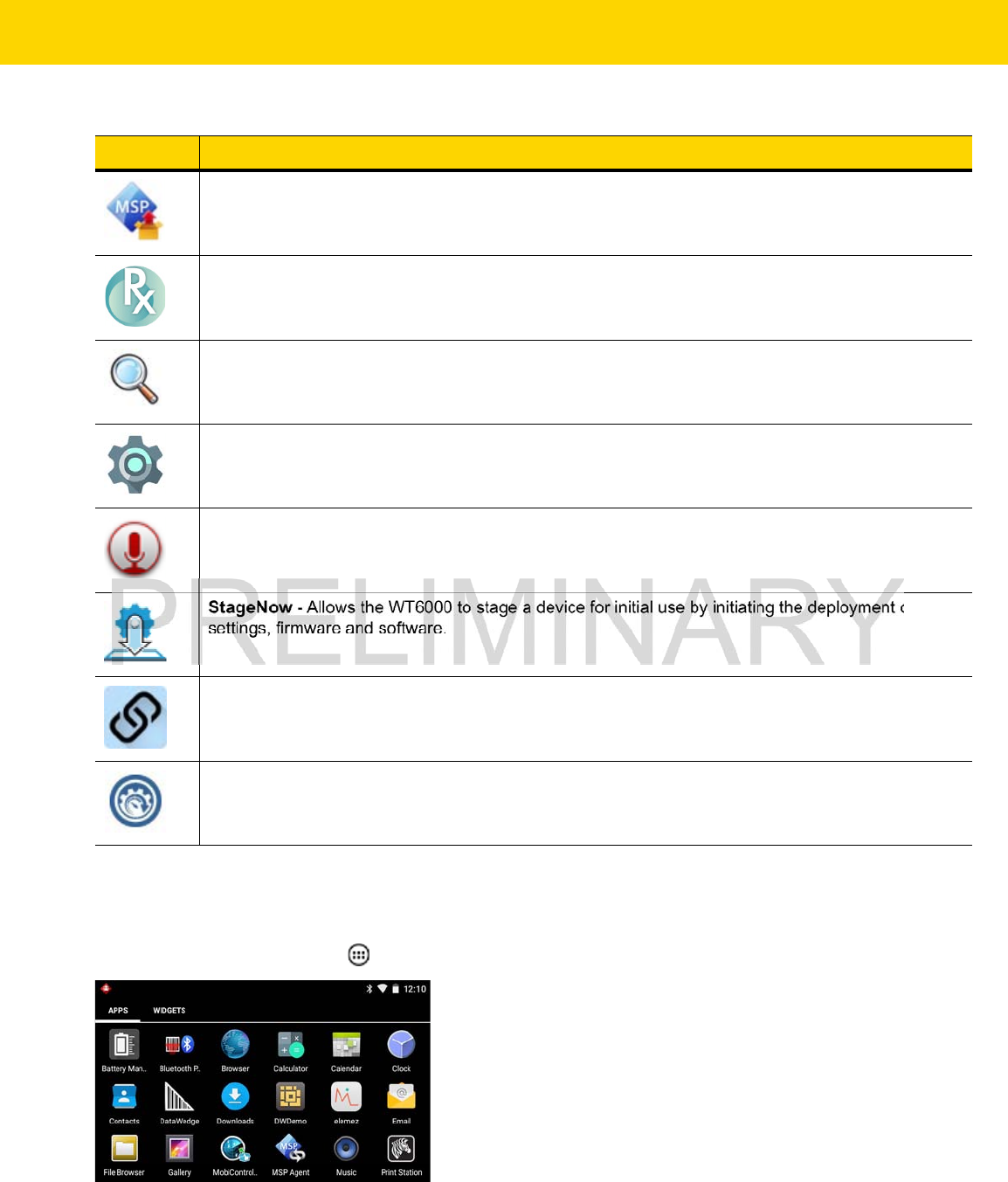
2 - 8 WT6000 User Guide
Accessing Applications
All applications installed on the device are accessed using the APPS window.
1. On the Home screen, touch .
Figure 2-4 APPS Window
2. Slide the APPS window left or right to view more application icons. Touch an icon to open the application.
Rapid Deployment
- Allows the WT6000 to stage a device for initial use by initiating the deployment
of settings, firmware and software. Requires the purchase of an MSP client license per device.
RxLogger
- Use to diagnose device and application issues. See the WT6000 Integrator Guide for
more information.
Search
- Use the Google search engine to search the Internet and the WT6000.
Settings
- Use to configure the WT6000.
Sound Recorder
- Use to record audio.
StageNow
- Allows the WT6000 to stage a device for initial use by initiating the deployment of
settings, firmware and software.
Tap & Pair
- Use to pair the WT6000 with a Zebra Bluetooth printer.
Velocity
- Opens the Wavelink terminal emulation application.
Table 2-3 Applications (Continued)
Icon Description
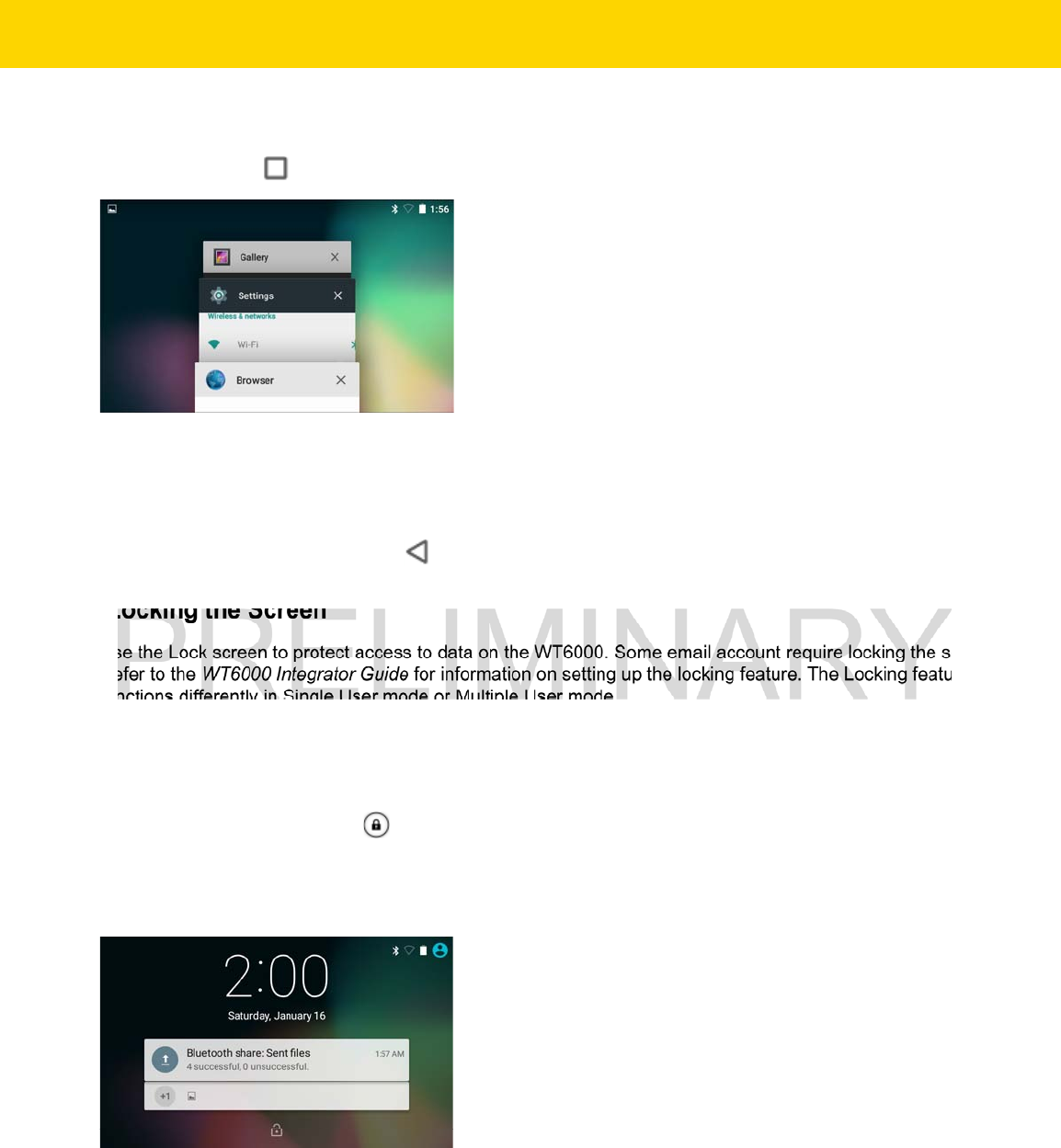
Using the WT6000 2 - 9
Switching Between Recent Applications
1. Touch and hold . A window appears on the screen with icons of recently used applications.
Figure 2-5 Recently Used Applications
2. Slide the window up and down to view all recently used applications.
3. Swipe left or right to remove application from the list and force close the application.
4. Touch an icon to open it or touch to return to the current screen.
Un-Locking the Screen
Use the Lock screen to protect access to data on the WT6000. Some email account require locking the screen.
Refer to the WT6000 Integrator Guide for information on setting up the locking feature. The Locking feature
functions differently in Single User mode or Multiple User mode.
When locked, a pattern, PIN or password is required to unlock the device. Press the Power button to lock the
screen. The device also locks after a pre-defined time-out.
Press and release the Power button to wake the device.
The Lock screen displays. Slide up to unlock the screen.
If the Pattern screen unlock feature is enabled, the Pattern screen appears instead of the Lock screen.
If the PIN or Password screen unlock feature is enabled, enter the PIN or password after unlocking the screen.
Figure 2-6 Lock Screen
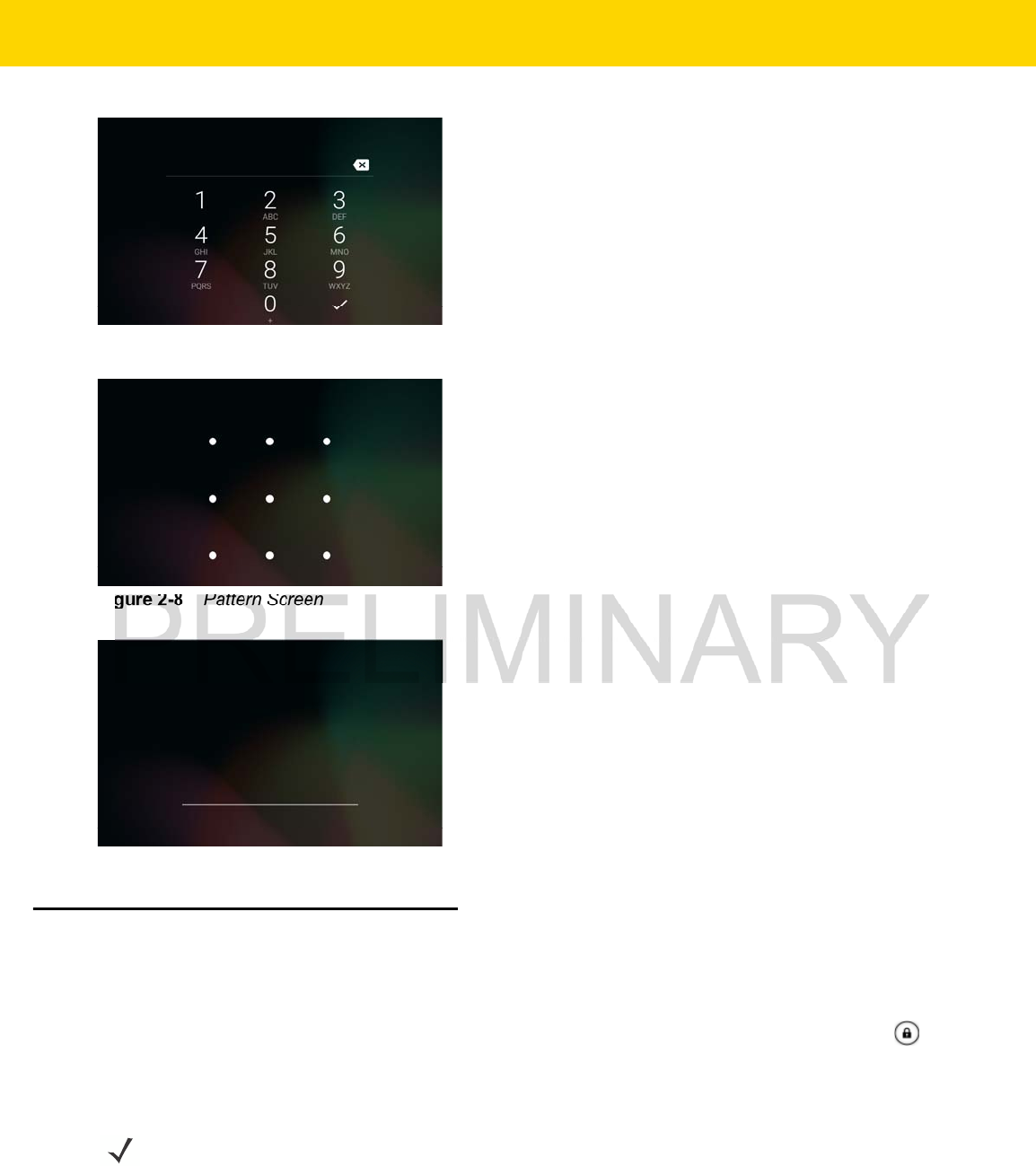
2 - 10 WT6000 User Guide
Figure 2-7 PIN Screen
Figure 2-8 Pattern Screen
Figure 2-9 Password Screen
Suspend Mode
The WT6000 goes into suspend mode when the user presses the Power button or after a period of inactivity (set in
the Display settings).
To wake the WT6000 from Suspend mode, press the Power button. The Lock screen displays. Slide up to
unlock the screen. If the Pattern screen unlock feature is enabled, the Pattern screen appears instead of the Lock
screen.
If the user forgets the PIN, password or pattern contact the system administrator.
NOTE
If the user enters the PIN, password or pattern incorrectly five times, they must wait 30 seconds before
trying again.
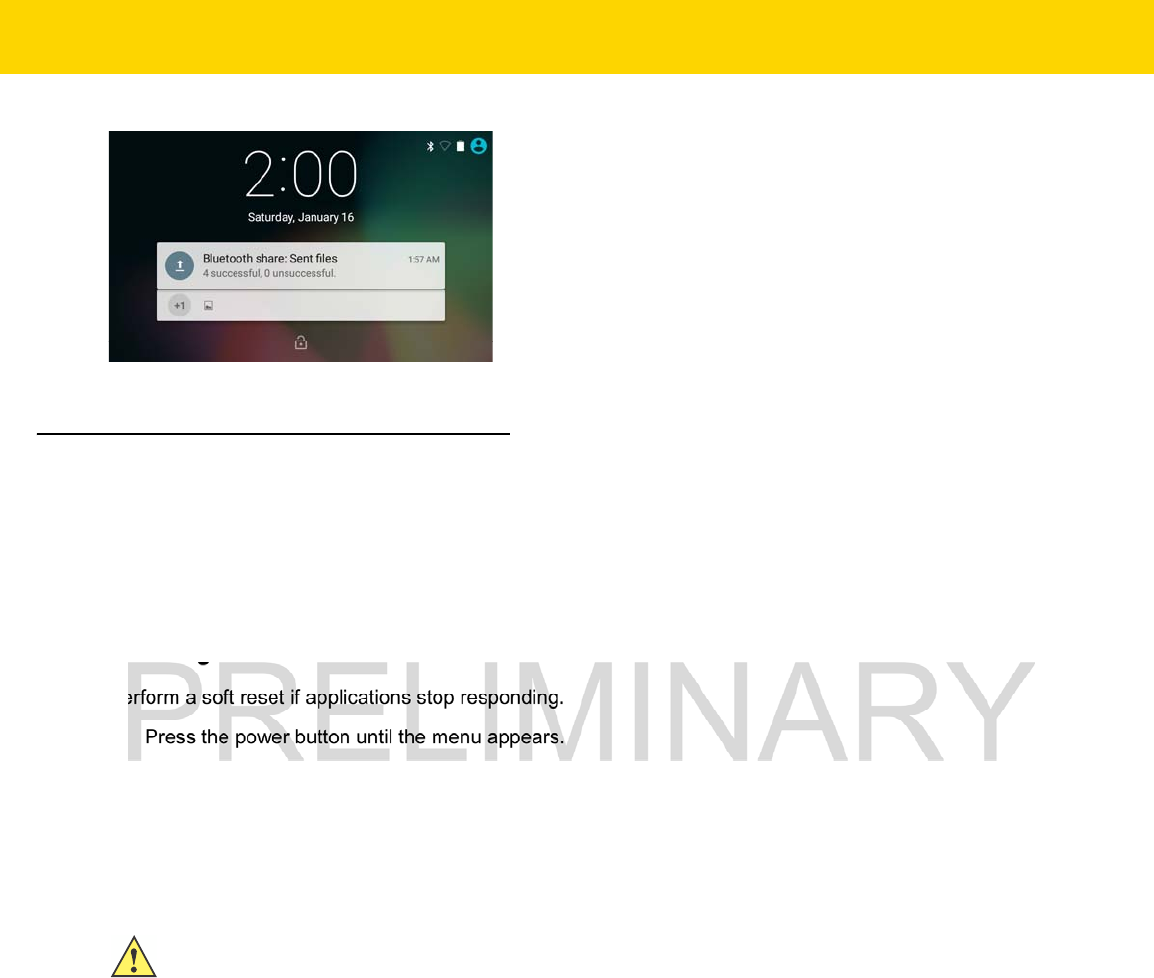
Using the WT6000 2 - 11
Figure 2-10 Lock Screen
Resetting the WT6000
There are two reset functions:
•
Soft reset
•
Hard reset.
Performing a Soft Reset
Perform a soft reset if applications stop responding.
1. Press the power button until the menu appears.
2. Touch Reset.
3. The device reboots.
Performing a Hard Reset
To perform a hard reset, simultaneously press and hold the power, P1 and P2 buttons for five seconds. When the
device reboots, release the buttons.
CAUTION
Perform a hard reset only if the WT6000 stops responding.

2 - 12 WT6000 User Guide

CHAPTER 3 DATA CAPTURE
Introduction
The WT6000 can be used with the following optional data capture accessories:
•
RS4000 laser scanner
•
RS6000 Hands-free imager
•
RS507 Hands-free imager.
Laser Scanning
WT6000 with an optional RS4000 laser scanner has the following features:
•
Reading of a variety of bar code symbologies, including the most popular linear and 1D code types.
•
Advanced intuitive laser aiming for easy point-and-shoot operation
•
Adaptive scanning.
Scanning Bar Codes
Imaging
The WT6000 with an optional RS507 or RS6000 imager has the following features:
•
Omnidirectional (360°) reading of a variety of bar code symbologies, including the most popular linear, postal,
PDF417, and 2D matrix code types.
•
Advanced intuitive laser aiming for easy point-and-shoot operation.
NOTE
Scanning procedures depend on the application and WT6000 configuration. An application may use
different scanning procedures from the one listed below.
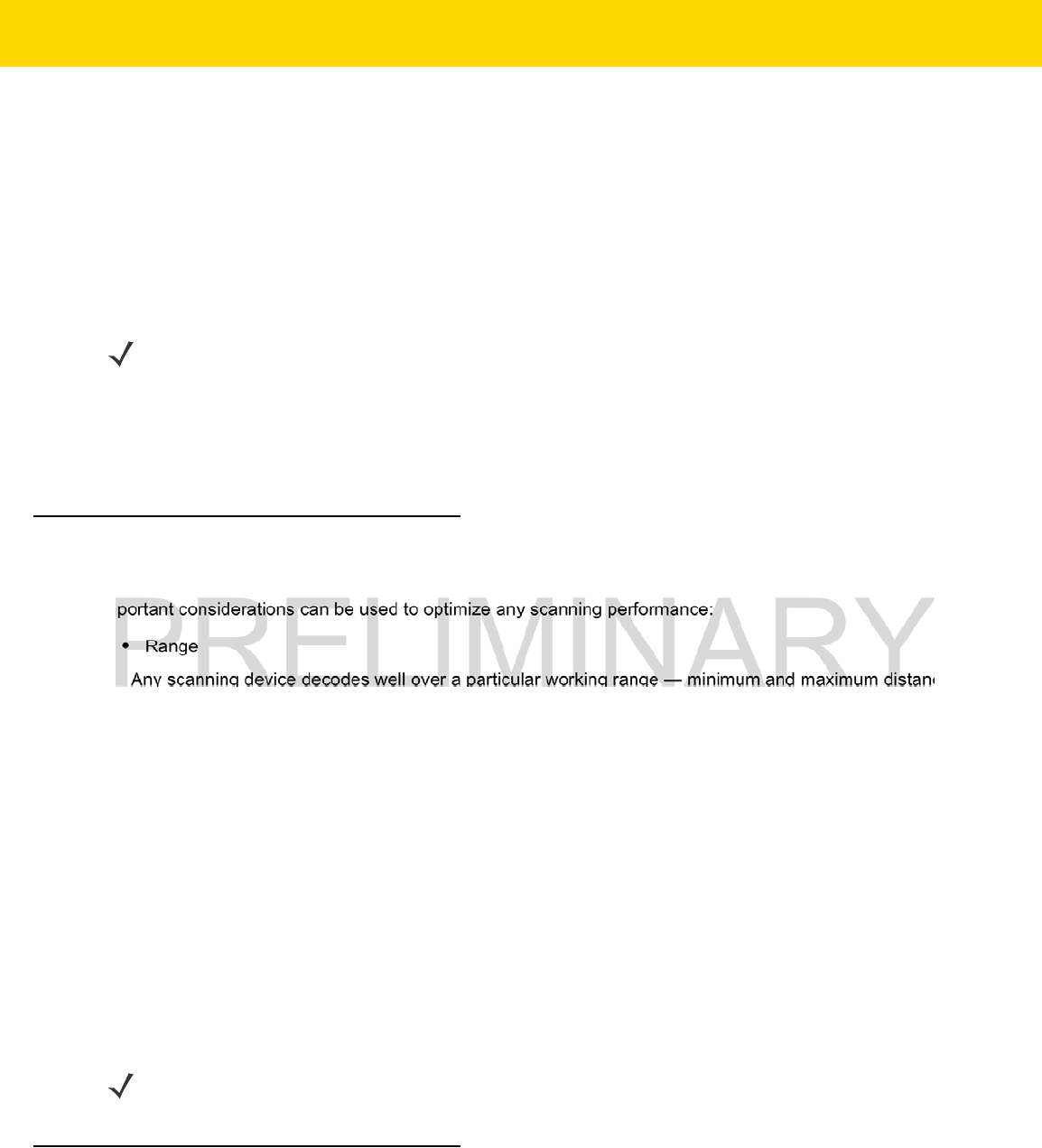
3 - 2 WT6000 User Guide
The imager uses imaging technology to take a picture of a bar code, stores the resulting image in its memory, and
executes state-of-the-art software decoding algorithms to extract the bar code data from the image.
Operational Modes
The optional imager supports two modes of operation. Activate each mode pressing the Scan button.
•
Decode Mode: In this mode, the imager attempts to locate and decode bar codes within its field of view. The
imager remains in this mode as long as the user holds the scan button, or until it decodes a bar code.
•
Pick List Mode: This mode allows the user to selectively decode a bar code when more than one bar code is
in the imager’s field of view. To accomplish this, move the aiming crosshair center dot over the required bar
code to decode only that bar code. This feature is ideal for pick lists containing multiple bar codes and
manufacturing or transport labels containing more than one bar code (either 1D or 2D).
Scanning Considerations
Typically, scanning is a simple matter of aim, scan/decode and a few quick trial efforts master it. However, two
important considerations can be used to optimize any scanning performance:
•
Range
Any scanning device decodes well over a particular working range — minimum and maximum distances from
the bar code. This range varies according to bar code density and scanning device optics.
Scanning within range brings quick and constant decodes; scanning too close or too far away prevents
decodes. Move the scanner closer and further away to find the right working range for the bar codes being
scanned. However, the situation is complicated by the availability of various integrated scanning modules. The
best way to specify the appropriate working range per bar code density is through a chart called a decode zone
for each scan module. A decode zone simply plots working range as a function of minimum element widths of
bar code symbols. Refer to the WT6000 Integrator Guide for decode zones for the optional data capture
options.
•
Angle
Scanning angle is important for promoting quick decodes. When laser beams reflect directly back into the
scanner from the bar code, this specular reflection can “blind” the scanner.
To avoid this, scan the bar code so that the beam does not bounce directly back. But don’t scan at too sharp an
angle; the scanner needs to collect scattered reflections from the scan to make a successful decode. Practice
quickly shows what tolerances to work within.
\
Bar Code Capture with RS4000
To read a bar code, a scan-enabled application is required. The WT6000 contains the DataWedge application that
allows the user to enable the scanner to decode bar code data and display the bar code content. See DataWedge
on page 5-8 for information on enabling DataWedge.
NOTE
To enable Pick List Mode use DataWedge. Pick List can also be set in an application using a API command.
NOTE
Contact the Zebra Global Support Center if chronic scanning difficulties develop. Decoding of properly
printed bar codes should be quick and effortless.
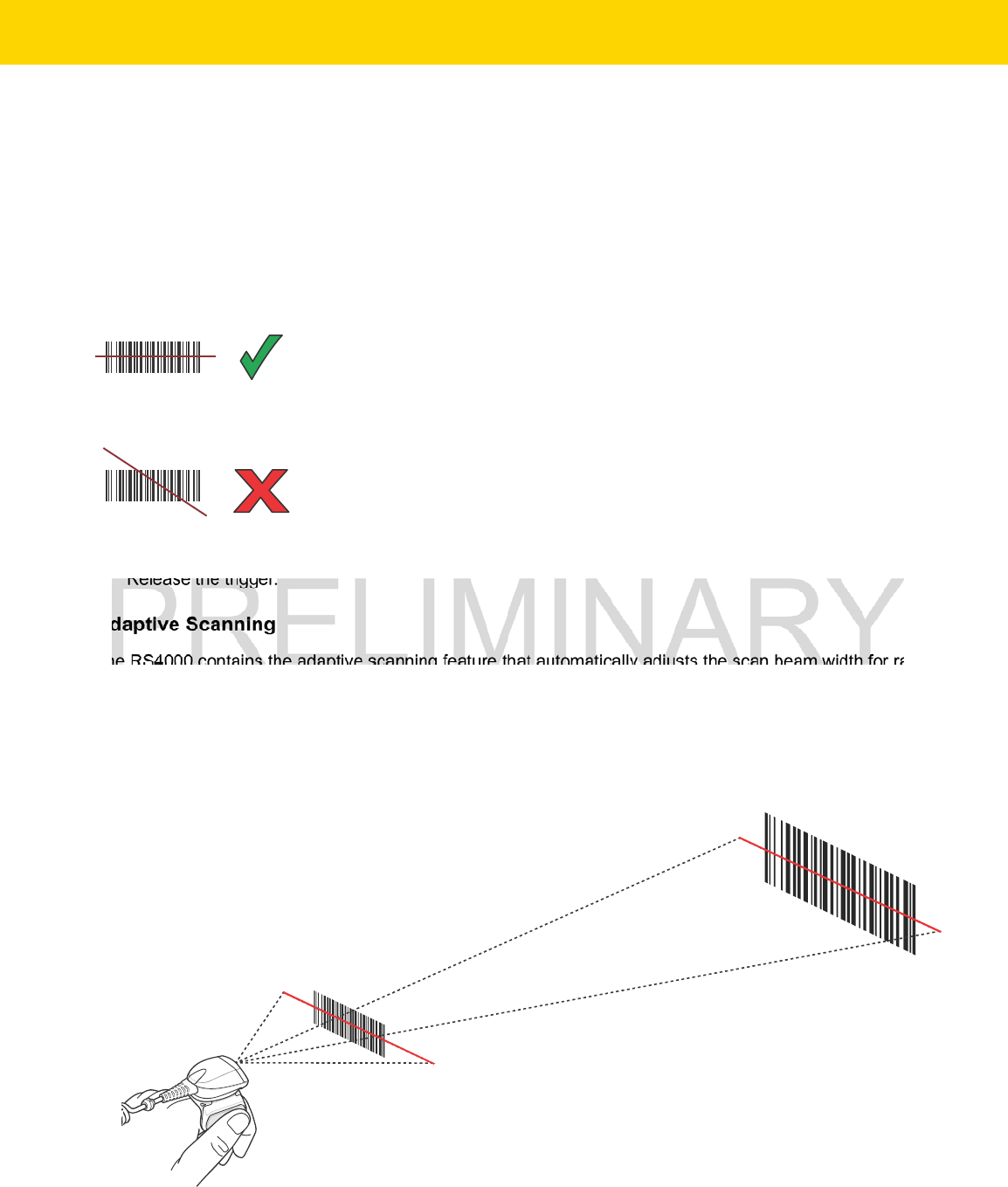
Data Capture 3 - 3
1. Connect the RS4000 to the WT6000. See Chapter 5, Accessories for more information.
2. Ensure that a scan enabled application is loaded or DataWedge is enabled (see DataWedge on page 5-8 for
more information).
3. Press the trigger.
4. Aim the scan beam at the bar code.
Ensure the red scan beam covers the entire bar code. The Decode LED lights red to indicate that scanning is
in process, then lights green and a beep sounds, by default, to indicate the bar code was decoded
successfully.
Figure 3-1 Laser Scanner Aiming Pattern
5. Release the trigger.
Adaptive Scanning
The RS4000 contains the adaptive scanning feature that automatically adjusts the scan beam width for rapid and
easy scanning of bar codes from near contact to more than 200 inches away.
By default the RS4000 is set to wide scan beam width. When the user presses the trigger, the RS4000 determines
the distance from the bar code. For close bar codes the RS4000 sets a wide beam width and for far bar codes it
sets a narrow beam width. The RS4000 uses distance, bar code type and material to determine the correct scan
beam width.
Figure 3-2 RS4000 Adaptive Scanning
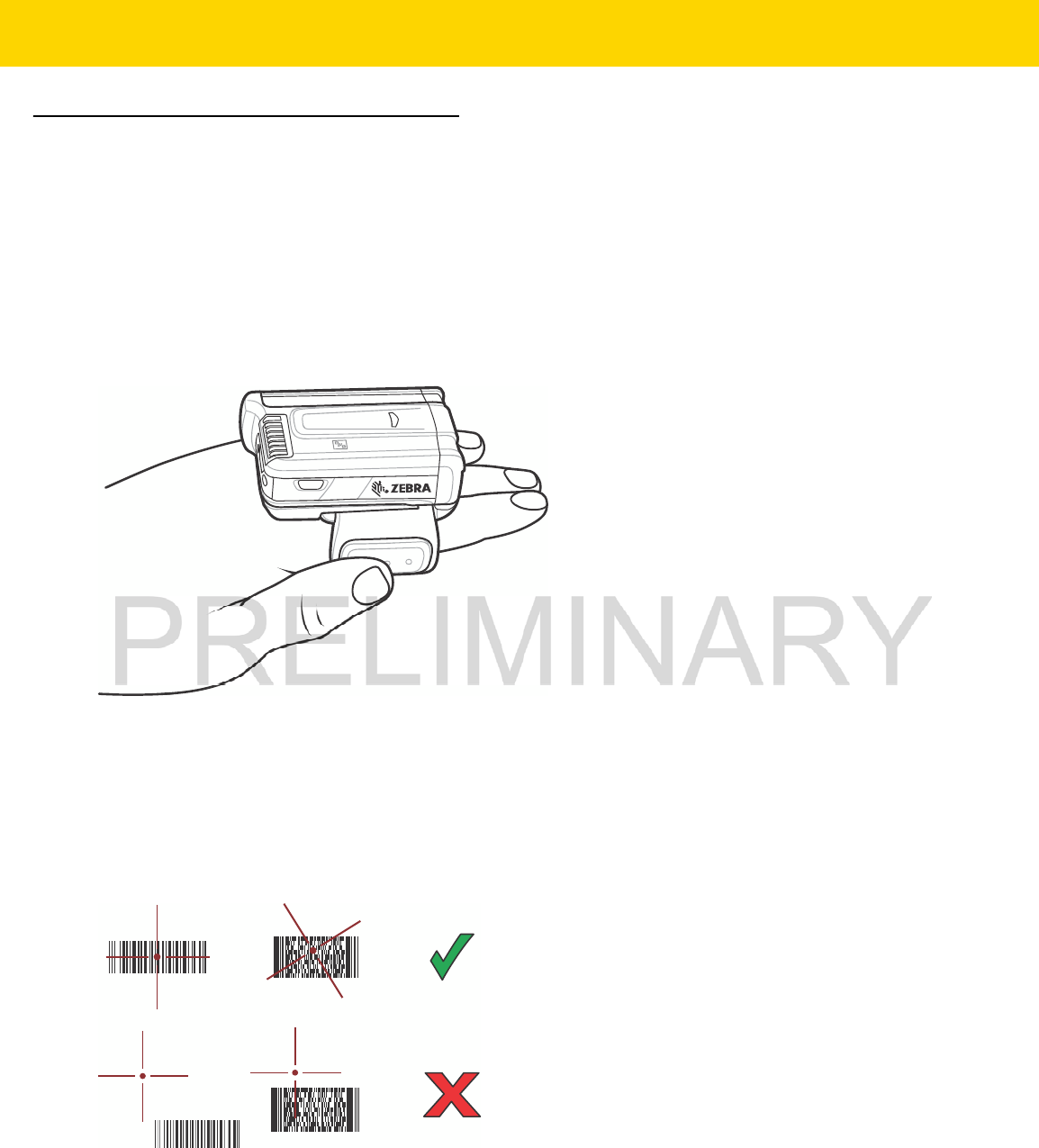
3 - 4 WT6000 User Guide
Bar Code Capture with RS6000 Hands-Free Imager
To read a bar code, a scan-enabled application is required. The WT6000 contains the DataWedge application that
allows the user to enable the scanner to decode bar code data and display the bar code content. See DataWedge
on page 5-8 for more information on launching DataWedge.
Pair the RS6000 with the WT6000. See Pairing Using Simple Serial Interface on page 3-7 or Pairing Using
Bluetooth Human Interface Device on page 3-8 for more information.
1. Ensure that an application is open on the device and a text field is in focus (text cursor in text field).
2. Point the RS6000 at a bar code.
Figure 3-3 Bar Code Scanning with RS6000
3. Press and hold the trigger.
The red laser aiming pattern turns on to assist in aiming. Ensure the bar code is within the area formed by the
cross-hairs in the aiming pattern. The aiming dot is used for increased visibility in bright lighting conditions.
The RS6000 LEDs light green, a beep sounds to indicate the bar code was decoded successfully. Note that
when the RS6000 is in Pick List Mode, the RS6000 does not decode the bar code until the center of the
crosshair touches the bar code.
Figure 3-4 Aiming Pattern
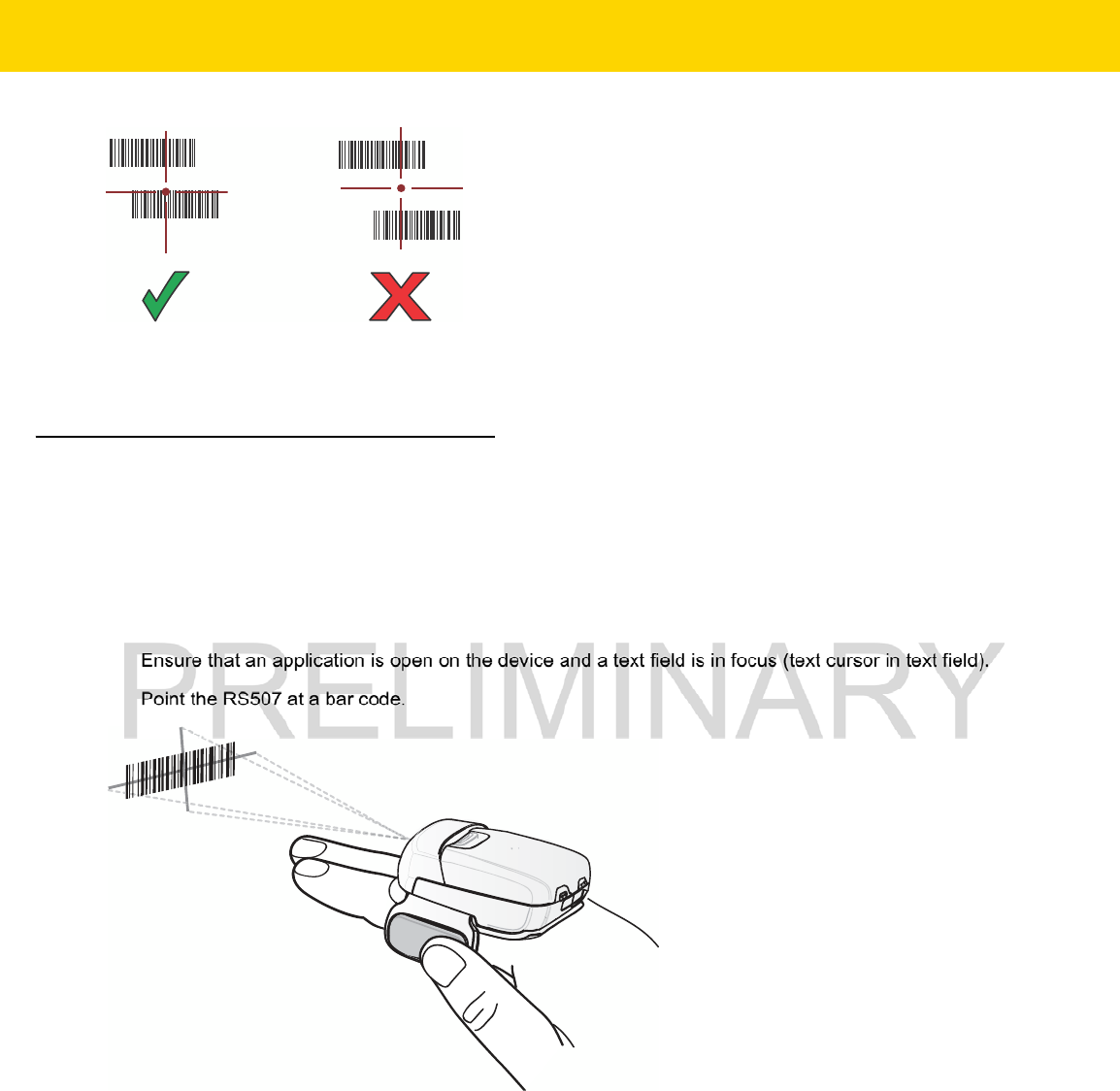
Data Capture 3 - 5
Figure 3-5 Pick List Mode with Multiple Bar Codes in Aiming Pattern
4. The captured data appears in the text field.
Bar Code Capture with RS507 Hands-Free Imager
To read a bar code, a scan-enabled application is required. The WT6000 contains the DataWedge application that
allows the user to enable the scanner to decode bar code data and display the bar code content. See DataWedge
on page 5-8 for more information on launching DataWedge.
Pair the RS507 with the WT6000. See Pairing Using Simple Serial Interface on page 3-7 or Pairing Using
Bluetooth Human Interface Device on page 3-8 for more information.
1. Ensure that an application is open on the device and a text field is in focus (text cursor in text field).
2. Point the RS507 at a bar code.
Figure 3-6 Bar Code Scanning with RS507
3. Press and hold the trigger.
The red laser aiming pattern turns on to assist in aiming. Ensure the bar code is within the area formed by the
cross-hairs in the aiming pattern. The aiming dot is used for increased visibility in bright lighting conditions.
The RS507 LEDs light green, a beep sounds to indicate the bar code was decoded successfully. Note that
when the RS507 is in Pick List Mode, the RS507 does not decode the bar code until the center of the crosshair
touches the bar code.
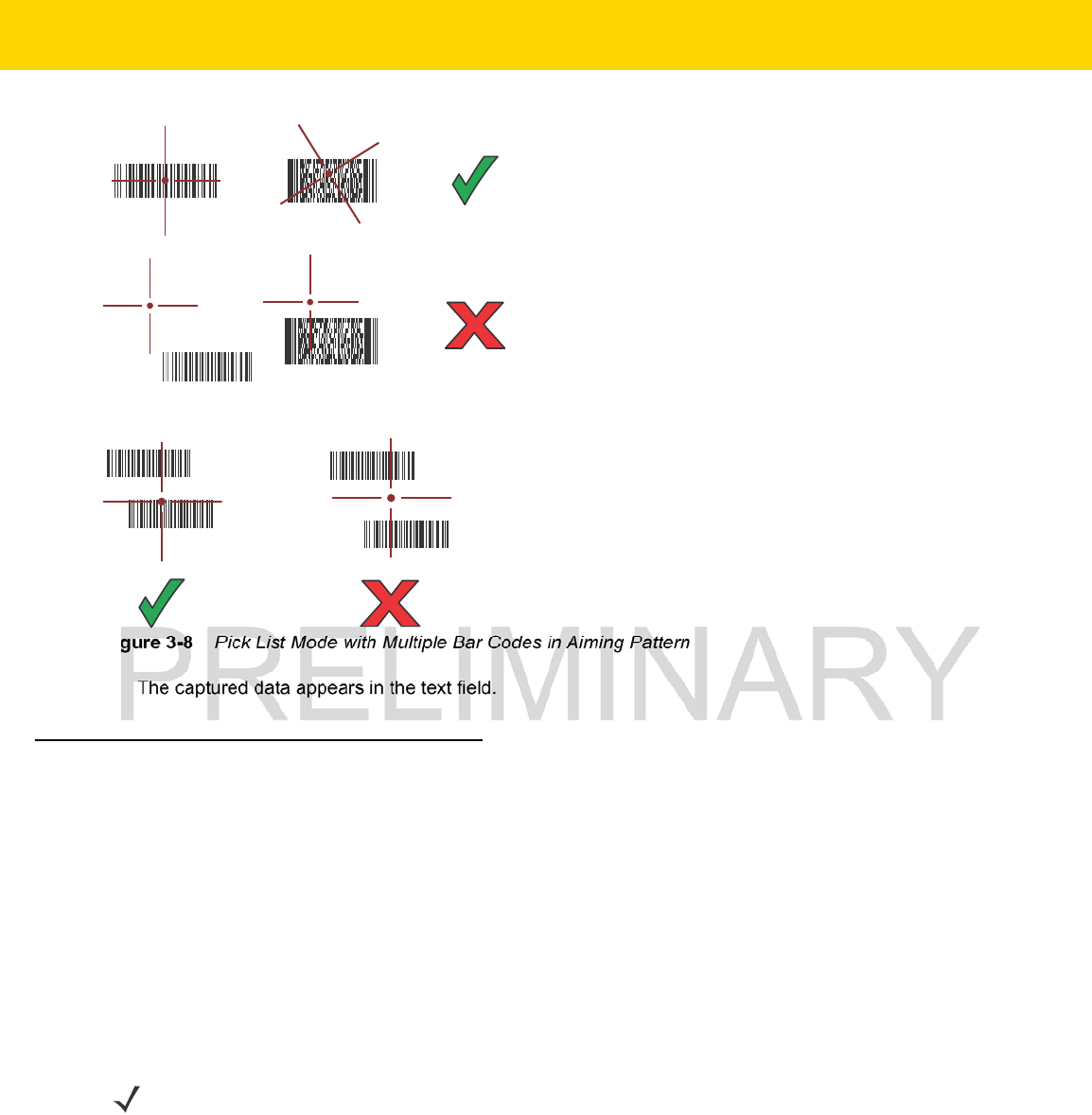
3 - 6 WT6000 User Guide
Figure 3-7 Aiming Pattern
Figure 3-8 Pick List Mode with Multiple Bar Codes in Aiming Pattern
4. The captured data appears in the text field.
Pairing the RS507/RS6000 Hands-Free Imager
To connect the RS507 or RS6000 imagers to the WT6000, use one of the following methods:
•
Near Field Communication (NFC)
•
Simple Serial Interface (SSI)
•
Bluetooth Human Interface Device (HID) Mode.
Pairing Using Near Field Communication
The WT6000 provides the ability to pair the RS6000 using NFC.
1. Align the NFC icon on the RS6000 with the NFC icon on the WT6000.
NOTE
RS6000 only.
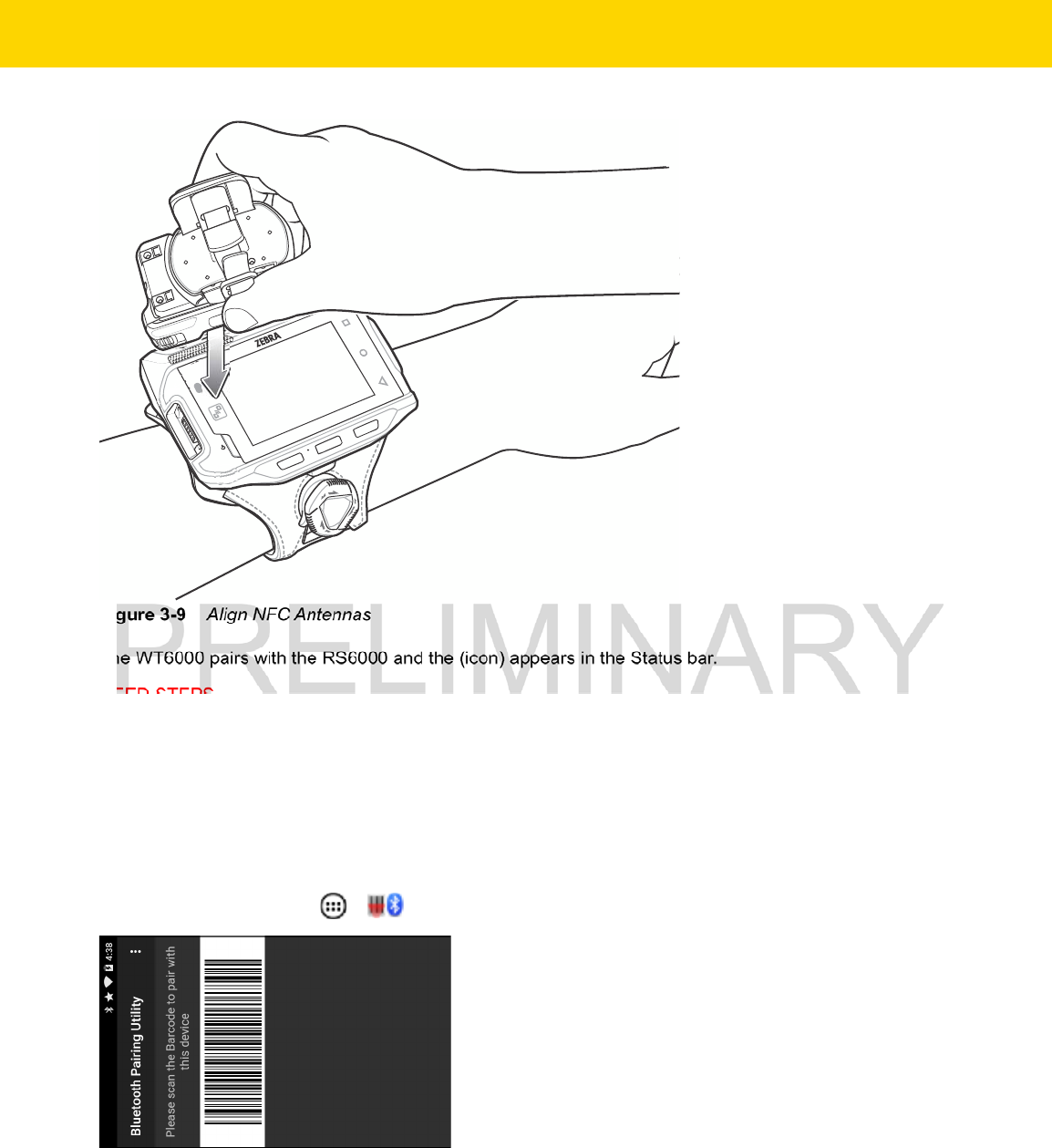
Data Capture 3 - 7
Figure 3-9 Align NFC Antennas
The WT6000 pairs with the RS6000 and the (icon) appears in the Status bar.
NEED STEPS
Pairing Using Simple Serial Interface
To pair the RS507/RS6000 with the WT6000 using SSI:
1. Ensure that the two devices are within 10 meters (32.8 feet) of one another.
2. Install the battery into the RS6000.
3. On the WT6000, touch > .
Figure 3-10 Bluetooth Pairing Utility
4. Using the RS507/RS6000, scan the bar code on the screen.
The RS507/RS6000 emits a high/low/high/low beeps. The Scan LED flashes green indicating that the
RS507/RS6000 is attempting to establish connection with the WT6000. When connection is established, the
Scan LED turns off and the RS6000 emits one string of low/high beeps.
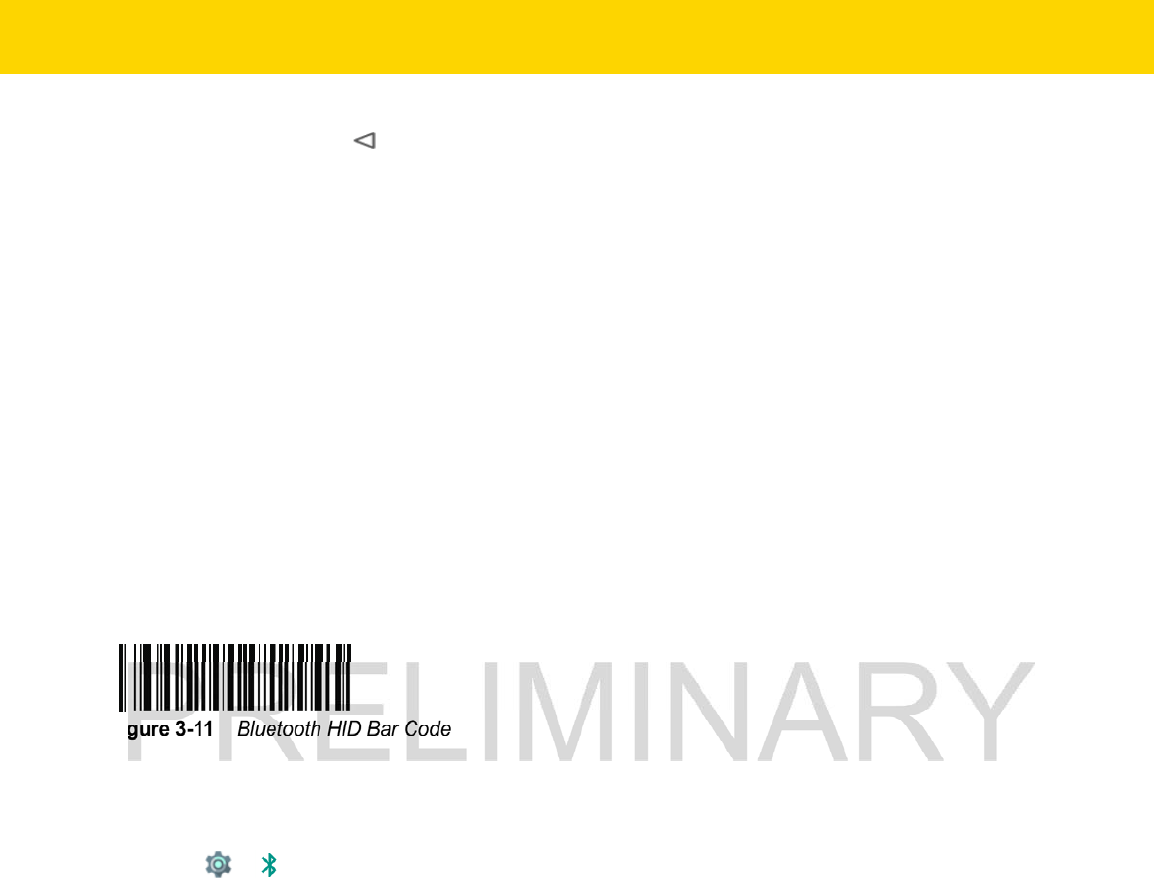
3 - 8 WT6000 User Guide
5. On the WT6000, touch .
Pairing Using Bluetooth Human Interface Device
To pair the RS507/RS6000 with the WT6000 using HID:
1. Ensure that Bluetooth is enabled on both devices.
2. Ensure that the Bluetooth device to discover is in discoverable mode.
3. Ensure that the two devices are within 10 meters (32.8 feet) of one another.
4. Place the RS507/RS6000 in Human Interface Device (HID) mode. If the RS507/RS6000 is already in HID
mode, skip to step 5.
a. Remove the battery from the RS507/RS6000.
b. Press and hold the Restore key.
c. Install the battery onto the RS507/RS6000.
d. Keep holding the Restore key for about five seconds until a chirp is heard and the Scan LEDs flash green.
e. Scan the bar code below to place the RS507/RS6000 in HID mode.
Figure 3-11 Bluetooth HID Bar Code
5. Remove the battery from the RS507/RS6000.
6. Re-install the battery into the RS507/RS6000.
7. Touch > Bluetooth.
8. Touch SCAN FOR DEVICES. The device begins searching for discoverable Bluetooth devices in the area and
displays them under AVAILABLE DEVICES.
9. Scroll through the list and select RS507/RS6000.
The device connects to the RS507/RS6000 and Connected appears below the device name. The Bluetooth
device is added to the Bluetooth devices list and a trusted (“paired”) connection is established.

CHAPTER 4 WIRELESS
Wireless Local Area Networks
Wireless local area networks (WLANs) allow the WT6000 to communicate wirelessly inside a building. Before
using the WT6000 on a WLAN, the facility must be set up with the required hardware to run the WLAN (sometimes
known as infrastructure). The infrastructure and the WT6000 must both be properly configured to enable this
communication.
Refer to the documentation provided with the infrastructure (access points (APs), access ports, switches, Radius
servers, etc.) for instructions on how to set up the infrastructure.
Once the infrastructure is set up to enforce the chosen WLAN security scheme, use the Wireless & networks
settings configure the WT6000 to match the security scheme.
The WT6000 supports the following WLAN security options:
•
Open
•
Wireless Equivalent Privacy (WEP).
•
Wi-Fi Protected Access (WPA/WPA2) Personal (PSK).
•
Extensible Authentication Protocol (EAP).
•Protected Extensible Authentication Protocol (PEAP) - with MSCHAPV2 and GTC authentication.
•Transport Layer Security (TLS)
•TTLS - with Password Authentication Protocol (PAP), MSCHAP and MSCHAPv2 authentication.
•LEAP
•FAST - with MSCHAPV2 and GTC authentication.
The Status bar displays icons that indicate Wi-Fi network availability and Wi-Fi status. See Status Bar on page 2-2
for more information.
NOTE
Turn off Wi-Fi when not using it, to extend the life of the battery.
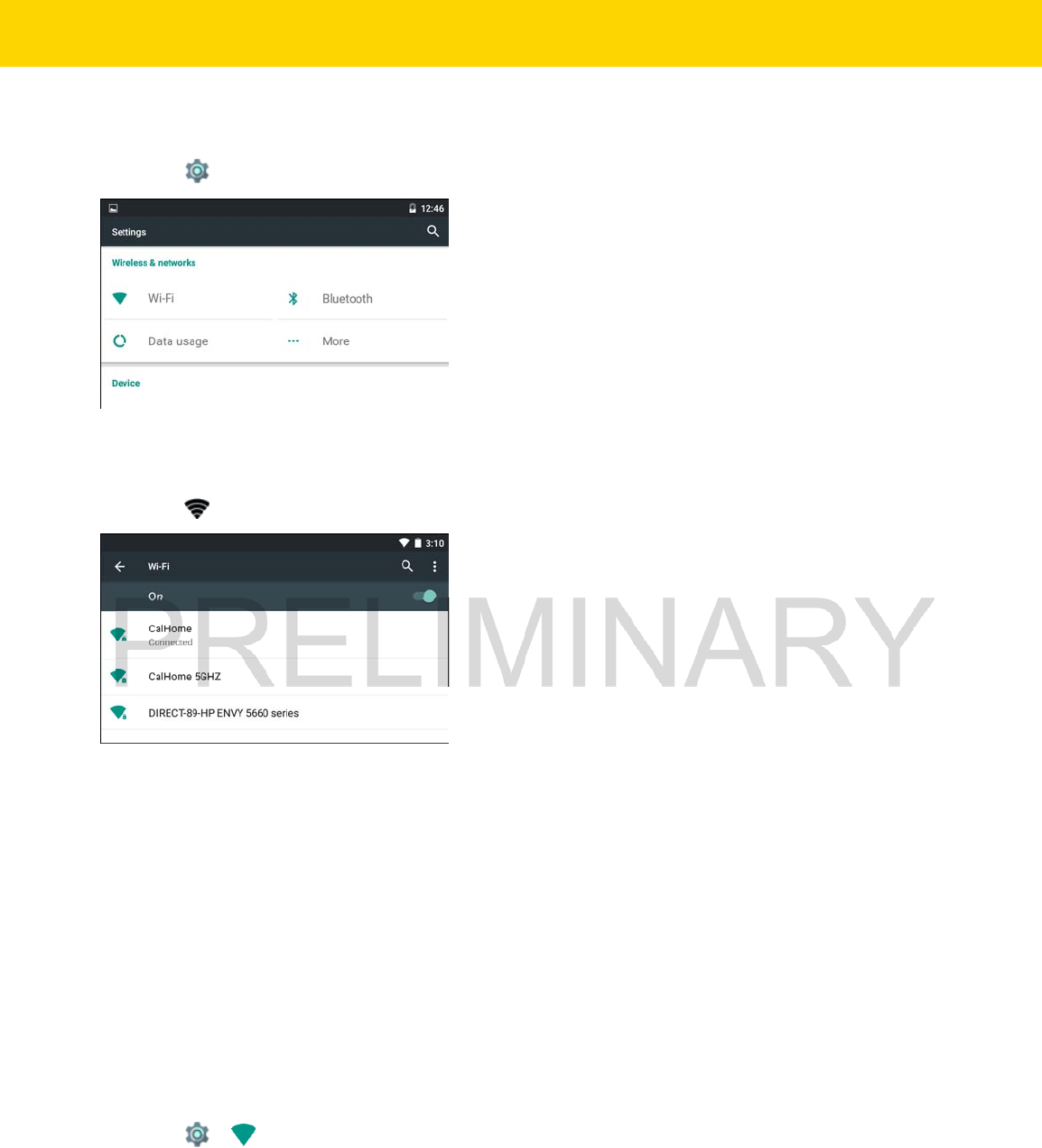
4 - 2 WT6000 User Guide
Scan and Connect to a Wi-Fi Network
1. Touch .
Figure 4-1 Settings Screen
2. Slide the Wi-Fi switch to the ON position.
3. Touch Wi-Fi. The WT6000 searches for WLANs in the area and lists them.
Figure 4-2 Wi-Fi Screen
4. Scroll through the list and select the desired WLAN network.
5. For open networks, touch profile once or press and hold and then select Connect to network or for secure
networks enter the required password or other credentials then touch Connect. See the system administrator
for more information.
6. The WT6000 obtains a network address and other required information from the network using the dynamic
host configuration protocol (DHCP) protocol. To configure the TC8000 with a fixed internet protocol (IP)
address, See Configuring the Device to Use a Static IP Address on page 4-5.
7. In the Wi-Fi setting field, Connected appears indicating that the WT6000 is connected to the WLAN.
Configuring a Wi-Fi Network
To set up a Wi-Fi network:
1. Touch > Wi-Fi.
2. Slide the switch to the ON position.
3. The device searches for WLANs in the area and lists them on the screen.
4. Scroll through the list and select the desired WLAN network.
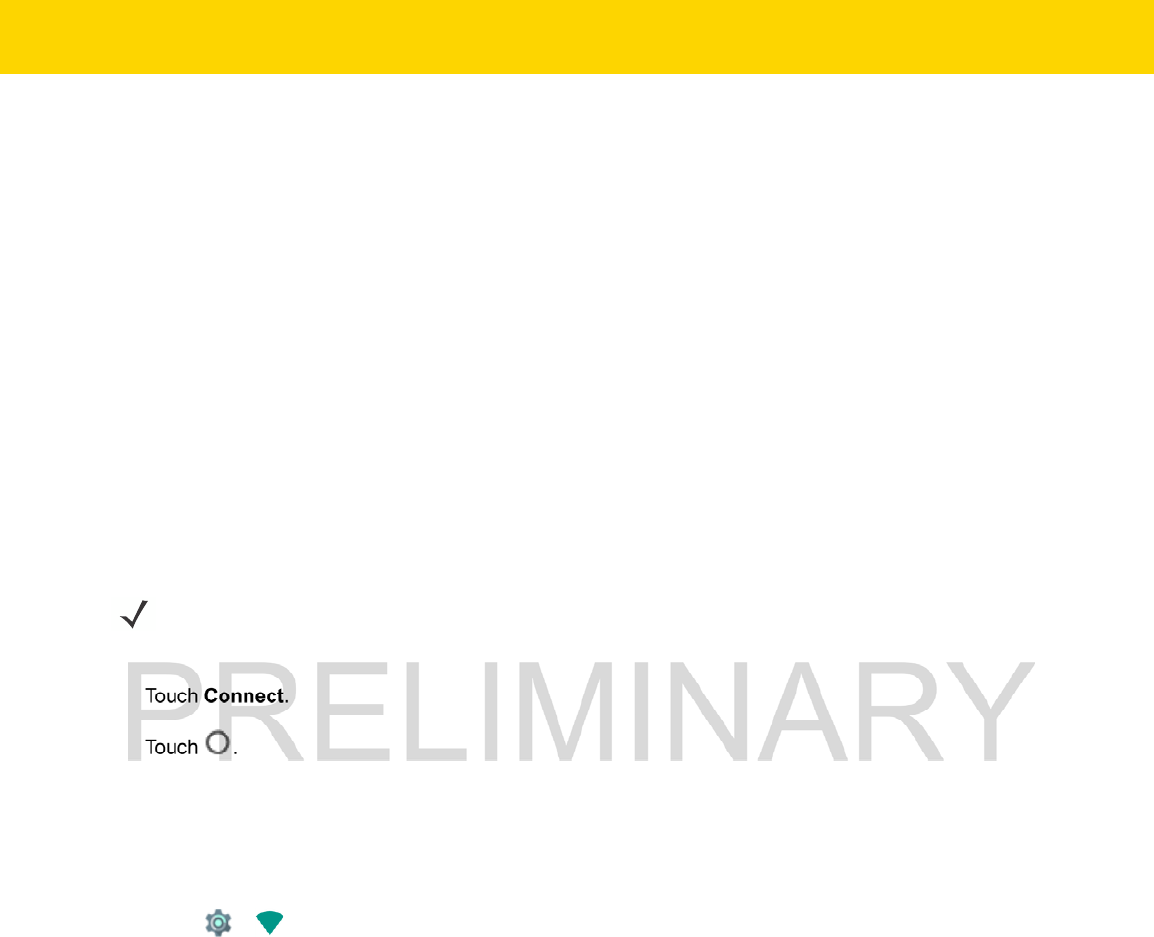
Wireless 4 - 3
5. Touch the desired network. If the network security is Open, the device automatically connects to the network.
For all other network security a dialog box appears.
6. If the network security is WEP or WPA/WPS2 PSK, enter the required password and then touch Connect.
7. If the network security is 802.1x EAP:
•
Touch the EAP method drop-down list and select PEAP, TLS, TTLS, LEAP or FAST.
•
Touch the Phase 2 authentication drop-down list and select an authentication method.
•
If required, touch CA certificate and select a Certification Authority (CA) certificate. Note: Certificates are
installed using the Security settings.
•
If required, touch User certificate and select a user certificate. Note: User certificates are installed using
the Location & security settings.
•
If required, in the Identity text box, enter the username credentials.
•
If desired, in the Anonymous identity text box, enter an anonymous identity username.
•
If required, in the Password text box, enter the password for then given identity.
8. Touch Connect.
9. Touch .
Manually Adding a Wi-Fi Network
Manually add a Wi-Fi network if the network does not broadcast its name (SSID) or to add a Wi-Fi network when
out of range.
1. Touch > Wi-Fi.
2. Slide the Wi-Fi switch to the On position.
3. Touch (three dots) > Add network.
4. In the Enter SSID text box, enter the name of the Wi-Fi network.
5. In the Security drop-down list, select the type of security. Options:
•
None
•
WEP
•
WPA/WPA2 PSK
•
802.1x EAP.
6. If the network security is None, touch Save.
7. If the network security is WEP or WPA/WPA2 PSK, enter the required password and then touch Save.
8. If the network security is 802.1x EAP:
•
Touch the EAP method drop-down list and select PEAP, TLS, TTLS, LEAP or FAST.
NOTE
By default, the network Proxy is set to None and the IP settings is set to DHCP. See Configuring for
a Proxy Server on page 4-4 for setting connection to a proxy server and see Configuring the Device
to Use a Static IP Address on page 4-5 for setting the device to use a static IP address.
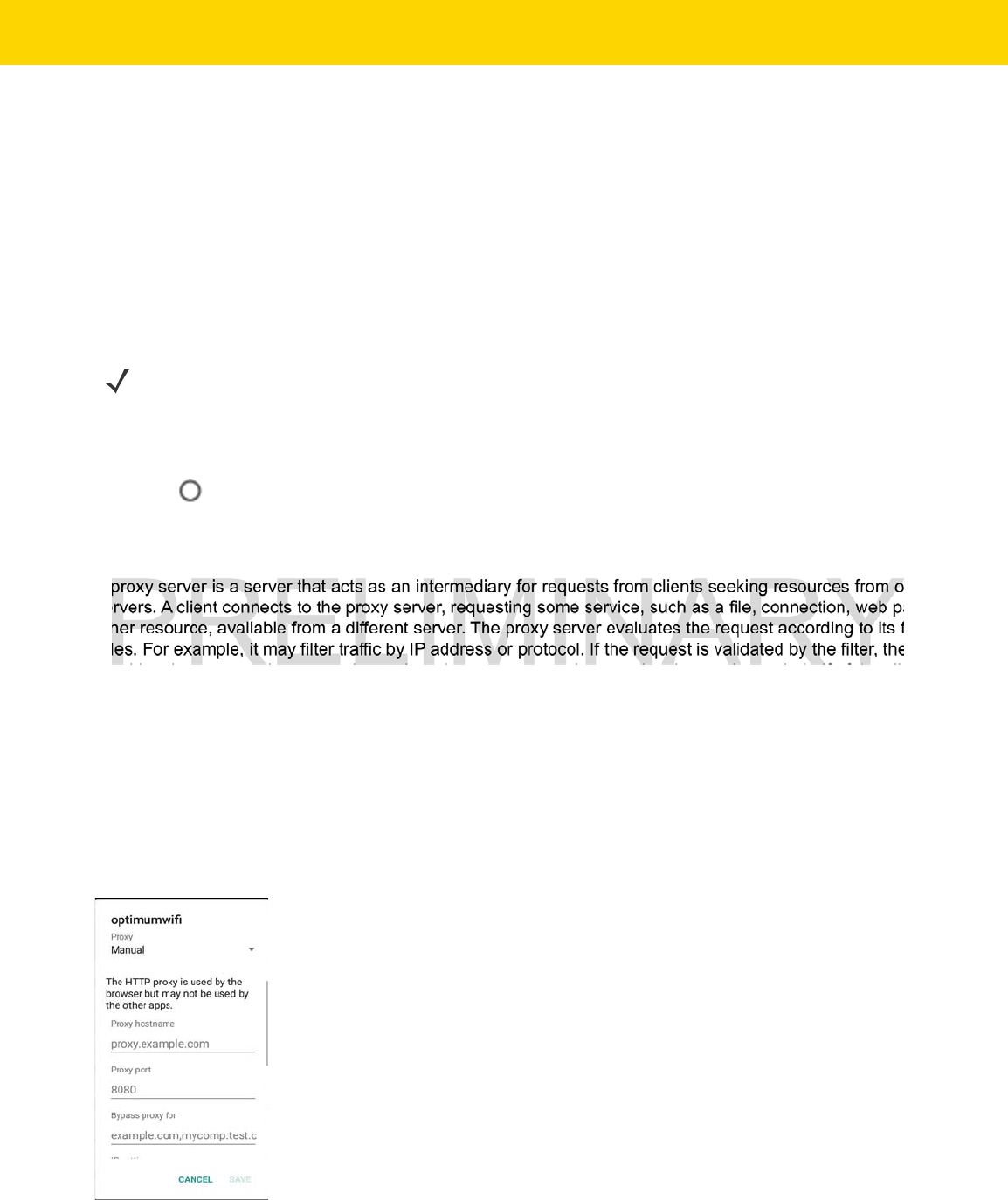
4 - 4 WT6000 User Guide
•
Touch the Phase 2 authentication drop-down list and select an authentication method.
•
If required, touch CA certificate and select a Certification Authority (CA) certificate. Note: Certificates are
installed using the Security settings.
•
If required, touch User certificate and select a user certificate. Note: User certificates are installed using
the Security settings.
•
If required, in the Identity text box, enter the username credentials.
•
If desired, in the Anonymous identity text box, enter an anonymous identity username.
•
If required, in the Password text box, enter the password for then given identity.
1. Touch Connect.
2. Touch .
Configuring for a Proxy Server
A proxy server is a server that acts as an intermediary for requests from clients seeking resources from other
servers. A client connects to the proxy server, requesting some service, such as a file, connection, web page, or
other resource, available from a different server. The proxy server evaluates the request according to its filtering
rules. For example, it may filter traffic by IP address or protocol. If the request is validated by the filter, the proxy
provides the resource by connecting to the relevant server and requesting the service on behalf of the client.
It is important for enterprise customers to be able to set up secure computing environments within their companies,
and proxy configuration is an essential part of doing that. Proxy configuration acts as a security barrier ensuring
that the proxy server monitors all traffic between the Internet and the intranet. This is normally an integral part of
security enforcement in corporate firewalls within intranets.
1. In the Wi-Fi list, touch a network.
2. Touch Show advanced options checkbox.
3. Touch Proxy settings and select Manual.
Figure 4-3 Proxy Settings
By default, the network Proxy is set to None and the IP settings is set to DHCP. See Configuring for a
Proxy Server on page 4-4 for setting connection to a proxy server and see Configuring the Device to
Use a Static IP Address on page 4-5 for setting the device to use a static IP address.
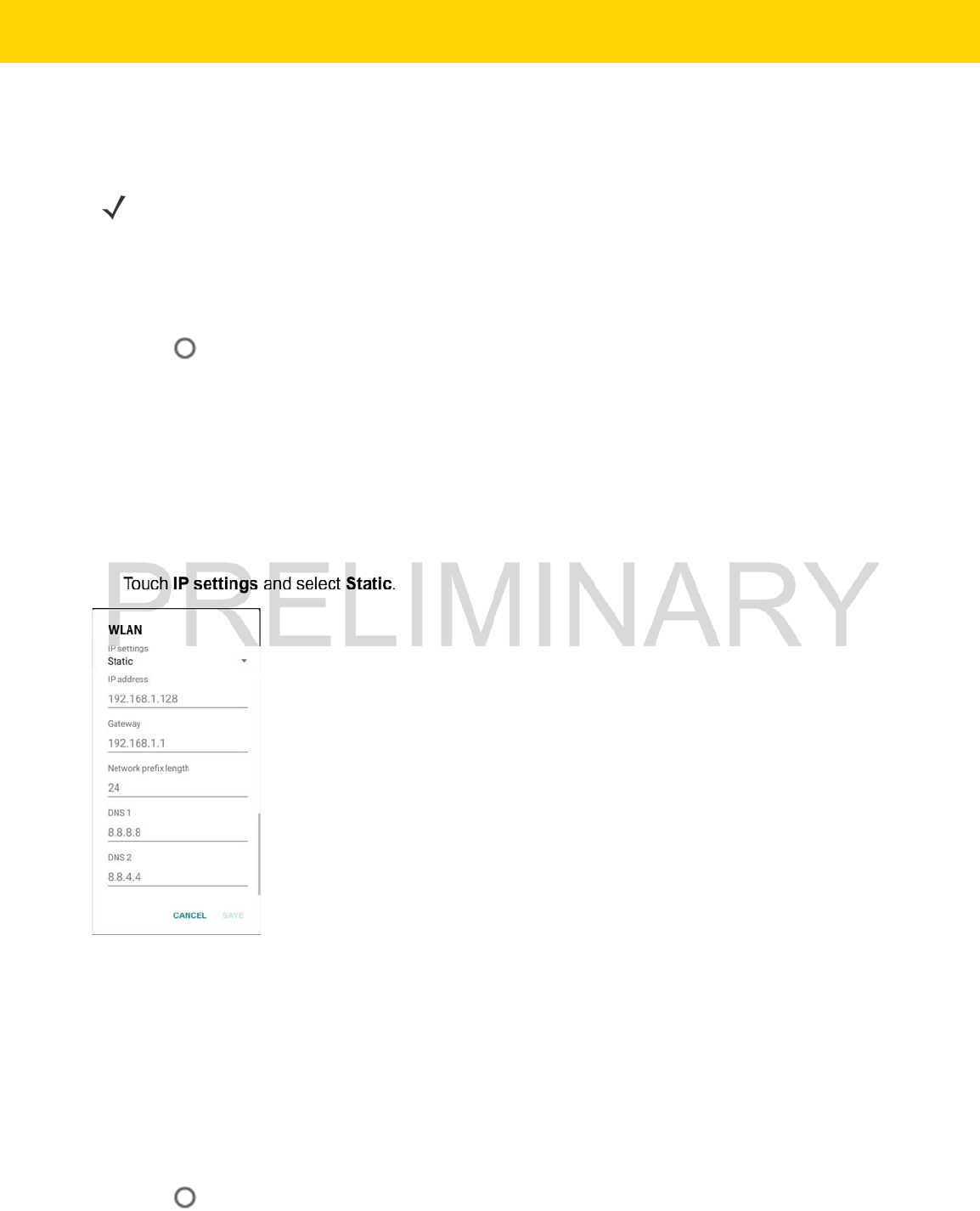
Wireless 4 - 5
4. In the Proxy hostname text box, enter the address of the proxy server.
5. In the Proxy port text box, enter the port number for the proxy server.
6. In the Bypass proxy for text box, enter addresses for web sites that do not require to go through the proxy
server. Use the separator “|” between addresses.
7. Touch Connect.
8. Touch .
Configuring the Device to Use a Static IP Address
By default, the device is configured to use Dynamic Host Configuration Protocol (DHCP) to assign an Internet
protocol (IP) address when connecting to a wireless network. To configure the device to connect to a network using
a static IP address:
1. In the Wi-Fi list, touch a network.
2. Touch Show advanced options checkbox.
3. Touch IP settings and select Static.
Figure 4-4 Static IP Settings
4. In the IP address text box, enter an IP address for the device.
5. If required, in the Gateway text box, enter a gateway address for the device.
6. If required, in the Network prefix length text box, enter a the prefix length.
7. If required, in the DNS 1 text box, enter a Domain Name System (DNS) address.
8. If required, in the DNS 2 text box, enter a DNS address.
9. Touch Connect.
10. Touch .
NOTE
When entering proxy addresses the Bypass proxy for field, do not use spaces or carriage returns between
addresses.
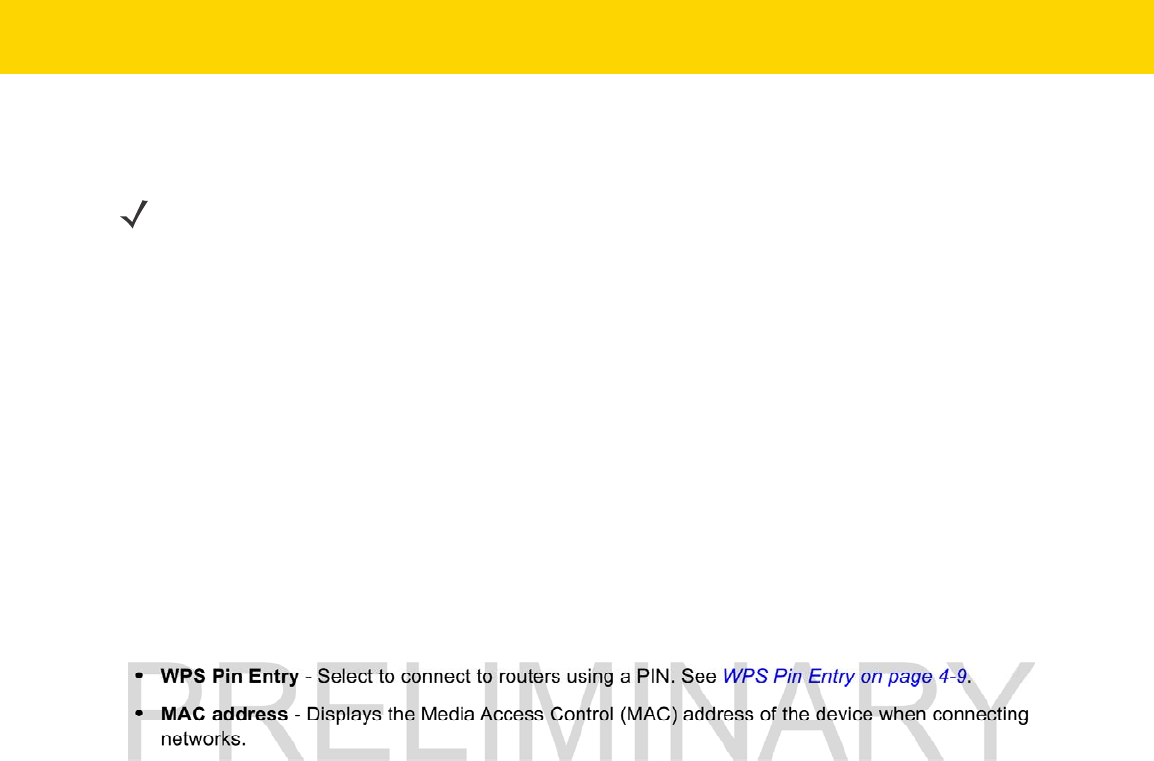
4 - 6 WT6000 User Guide
Advanced Wi-Fi Settings
•
Network notification - When enabled, notifies the user when an open network is available.
•
Scanning always available - Select to let Google’s location service and other applications scan for
networks, even when Wi-Fi is off. Default - disabled.
•
Keep Wi-Fi on during sleep - Opens a menu to set whether and when the Wi-Fi radio turns off.
• Always On - The radio stays on when the device enters suspend mode.
• Only when plugged in - The radio stays on while the device is connected to external power.
• Never - The radio turns off when the device enters suspend mode (default).
•
Wi-Fi frequency band - Options: Automatic (default), 5 GHz only or 2.4 GHz only.
•
Install Certificates – Touch to install certificates.
•
Wi-Fi Direct - Select to connect to another device using Wi-Fi Direct.
•
WPS Push Button - Select to connect to routers that have WPS Push buttons. See WPS Push Button on
page 4-8.
•
WPS Pin Entry - Select to connect to routers using a PIN. See WPS Pin Entry on page 4-9.
•
MAC address - Displays the Media Access Control (MAC) address of the device when connecting to Wi-Fi
networks.
•
IP address - Displays the IP address of the device.
Additional Settings
•
Regulatory
• Country selection - Displays the acquired country code if Auto is selected else displays the selected
country code. Default: Auto.
• Region code - Displays the configured region code for the device.
•
Band and Channel Selection
• Wi-Fi frequency band - Use to select the frequency band. Options: Auto (default), 5 GHz only or 2.4
GHz only.
• Available channels (2.4 GHz) - Use to select specific channels. Touch to display the Available channels
menu. Select specific channels. Touch OK.
• Available channels (5 GHz) - Use to select specific channels. Touch to display the Available channels
menu. Select specific channels. Touch OK.
•
Logging
• Advanced Logging – Touch to enable advanced logging.
• Wireless logs - Use to capture Wi-Fi log files.
•Fusion Logger - Touch to open the Fusion Logger application. This application maintains a history of
high level WLAN events which helps to understand the status of connectivity.
NOTE
Advanced Wi-Fi settings are for the device not for a specific wireless network.
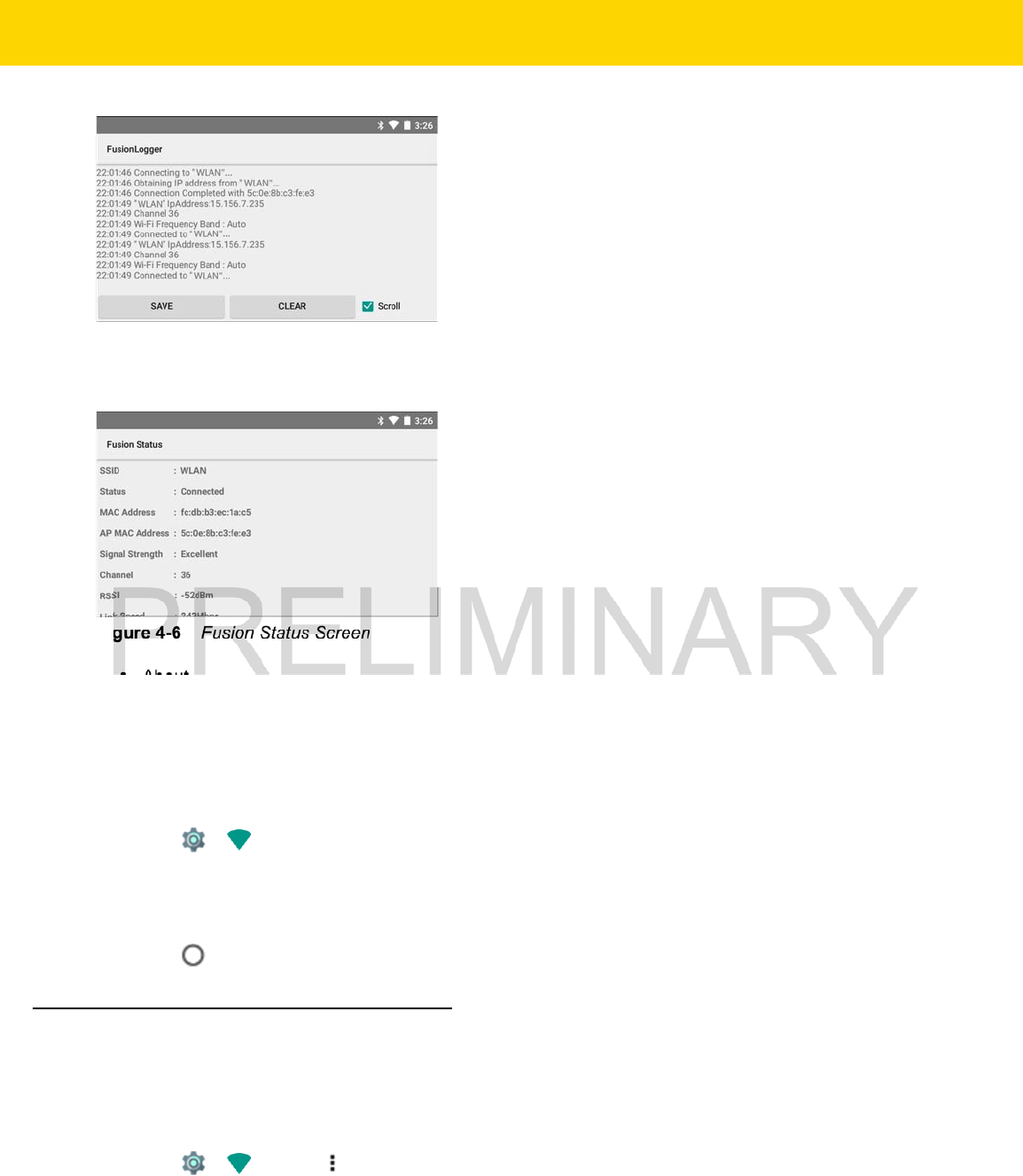
Wireless 4 - 7
Figure 4-5 Fusion Logger Screen
•Fusion Status - Touch to display live status of WLAN state. Also provides information of device and
connected profile.
Figure 4-6 Fusion Status Screen
•
About
• Version - Displays the current Fusion information.
Remove a Wi-Fi Network
To remove a remembered or connected network:
1. Touch > Wi-Fi.
2. In the Wi-Fi networks list, touch and hold the name of the network.
3. In the menu, touch Forget network.
4. Touch .
Wi-Fi Direct
Wi-Fi Direct devices can connect to each other without having to go through an access point. Wi-Fi Direct devices
establish their own ad-hoc network when required, allowing the user to view available devices and to connect to
that device.
1. Touch > Wi-Fi > >Advanced > Wi-Fi Direct. The WT6000 begins searching for another Wi-Fi
Direct device.
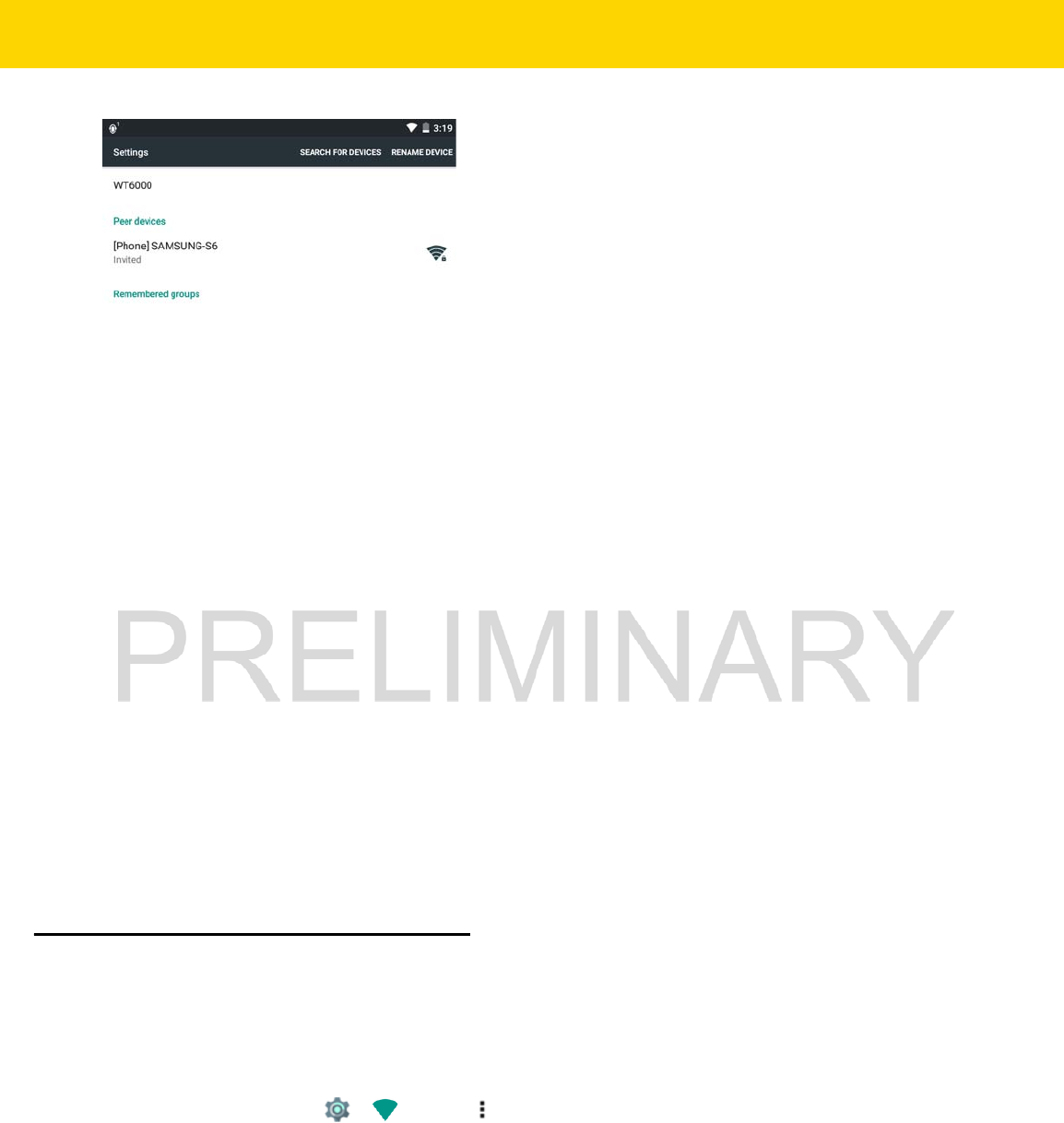
4 - 8 WT6000 User Guide
Figure 4-7 Wi-Fi Direct Screen
2. Under Peer Devices, touch the other device name.
3. On the other device, select Accept.
4. Connected appears on the WT6000. On both devices, in their respective Wi-Fi Direct screens, the other device
name appears in the list.
Figure 4-8 Wi-Fi Direct Connected
WPS Push Button
Wi-Fi Protected Setup (WPS) is a feature allowing devices to easily connect to Wi-Fi access points without typing a
long password.
To use Push Button to connect to a wireless router:
1. On the WT6000, touch > Wi-Fi > > WPS Push Button. A dialog box displays.
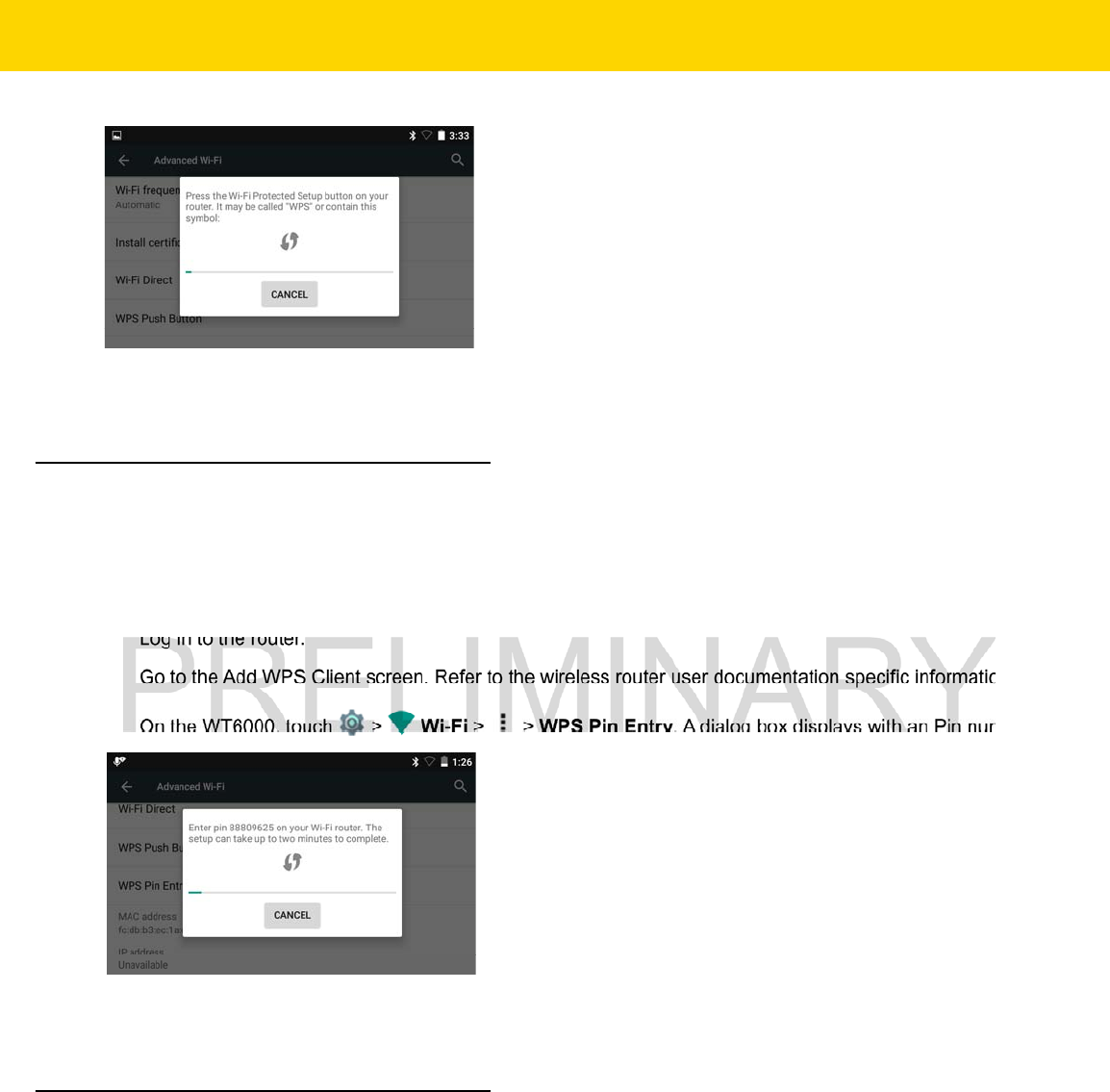
Wireless 4 - 9
Figure 4-9 Push Button Dialog Box
2. On the router, press the Wi-Fi Protected button. The WT6000 connects to the wireless router.
WPS Pin Entry
Wi-Fi Protected Setup (WPS) is a feature allowing devices to easily connect to Wi-Fi access points without typing a
long password.
To use a PIN to connect to a wireless router:
1. Log in to the router.
2. Go to the Add WPS Client screen. Refer to the wireless router user documentation specific information.
3. On the WT6000, touch > Wi-Fi > > WPS Pin Entry. A dialog box displays with an Pin number.
Figure 4-10 Pin Entry Dialog Box
4. On the router, enter the Pin number. The WT6000 connects to the wireless router.
Wi-Fi Advanced Features
Some additional Wi-Fi settings cannot be accessed from the User Interface. They can be configured by using Wi-Fi
(CSP). Refer to EMDK documentation for the details on the Wi-Fi settings configuration using the Wi-Fi CSP.
•
Auto Time Config - Using this feature, the device can sync up its time with Zebra WLAN infrastructure. This
feature works only when the device is connected to Zebra WLAN infrastructure and the feature is enabled on
the WLAN infrastructure side. Default: disabled.
•
PMKID Caching - Allows the device to skip 802.1x authentication during roaming if it had previously
connected to that AP with a full 802.1x authentication. Default: disabled. Note: disable OKC when enabling
PMKID Caching.
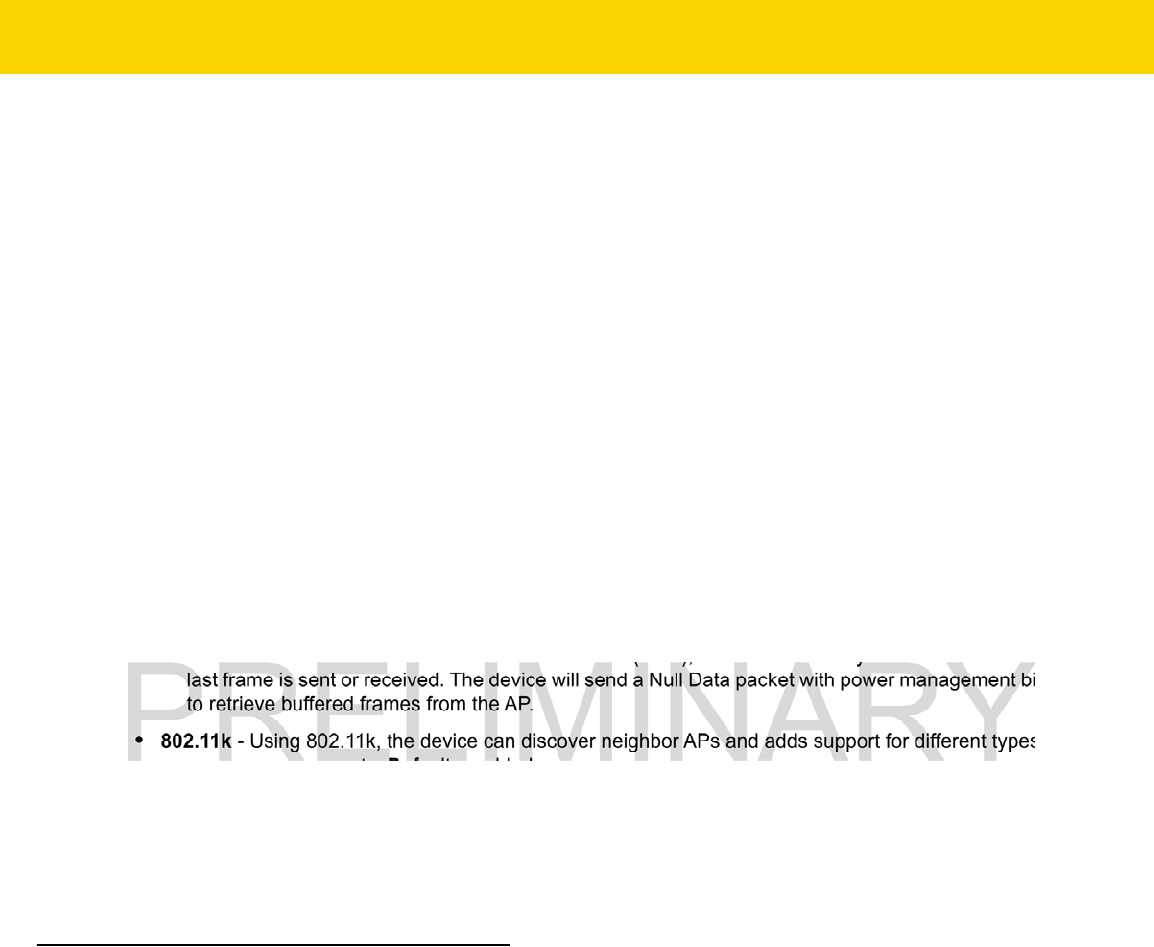
4 - 10 WT6000 User Guide
•
Opportunistic Key Caching - Use this feature to skip 802.1x authentication during roaming. The device will
go for full 802.1x authentication for the first time it connects to the network. For subsequent roaming, the
device skips 802.1x authentication. Default: enabled.
•
Cisco Centralized Key Management - Allows the device to skip 802.1x and key-handshake phases during
roaming. This feature is available only when the device is connected to a Cisco infrastructure that supports
Cisco Centralized Key Management (CCKM). Default: enabled.
•
Fast Transition - Fast Transition (FT) is the fast roaming standard, 802.11r. With this feature, the device can
skip 802.1x and key-handshake phases during roam. Default: enabled.
•
Fast Transition Resource Information Container - Allows the device to request TSPEC as part of
reassociation frame exchange. This helps to avoid sending a separate resource request after roaming is
completed. Default: disabled.
•
Power Save - The device can be configured to work in different power save modes:
• Active - Keeps the WLAN radio always in active mode (i.e. power save mode disabled).
• Power save using WMM-PS - This is the default power save mode. Device uses WMM-PS power save
method if the AP is configured to use this. If the AP is not supporting WMM-PS, the device will use PS-Poll
power save method.
• Power save using PS-Poll - In this method, the device will use PS-Poll frames to retrieve buffered frames
from the AP.
• Null Data Power Save - In Null Data Power Save (NDP), the device will stay awake for 100 ms after the
last frame is sent or received. The device will send a Null Data packet with power management bit cleared
to retrieve buffered frames from the AP.
•
802.11k - Using 802.11k, the device can discover neighbor APs and adds support for different types of radio
resource measurements. Default: enabled.
•
Band Preference - The device can be configured to prefer one band over another. By default, device prefers
5 GHz frequency band over 2.4 GHz.
•
Subnet Roaming - When the device roams between different sub networks, if it detects that it is roaming to
a different subnet, the device will request a fresh IP address. Default: disabled.
Zebra Mobility Extensions
Zebra Mobility Extensions make use 802.11 specifications and Zebra proprietary extensions to achieve the highest
level of performance, efficiency and reliability. The WT6000 adds support for the following Zebra Mobility
Extensions.
•
Coverage Hole Detection - The WT6000 includes enhancements to the IEEE 802.11k standard. These
improvements will report gaps in signal coverage to the Zebra wireless LAN infrastructure. Network
administrators can detect and mitigate coverage gaps present in the network for greater reliability. Default:
enabled.
•
Aggregated Fast Transition - Aggregated FT improves on IEEE 802.11r, Over-the-DS fast roaming. In
conjunction with Zebra wireless LAN infrastructure, the WT6000 will achieve more reliable and consistent
fast roaming. Default: enabled.
•
Scan Assist - The WT6000 monitors neighbor access points and retrieves roaming related information from
the Zebra wireless LAN infrastructure without doing scans. Using this Scan Assist feature, the WT6000
improves roaming. Default: enabled.
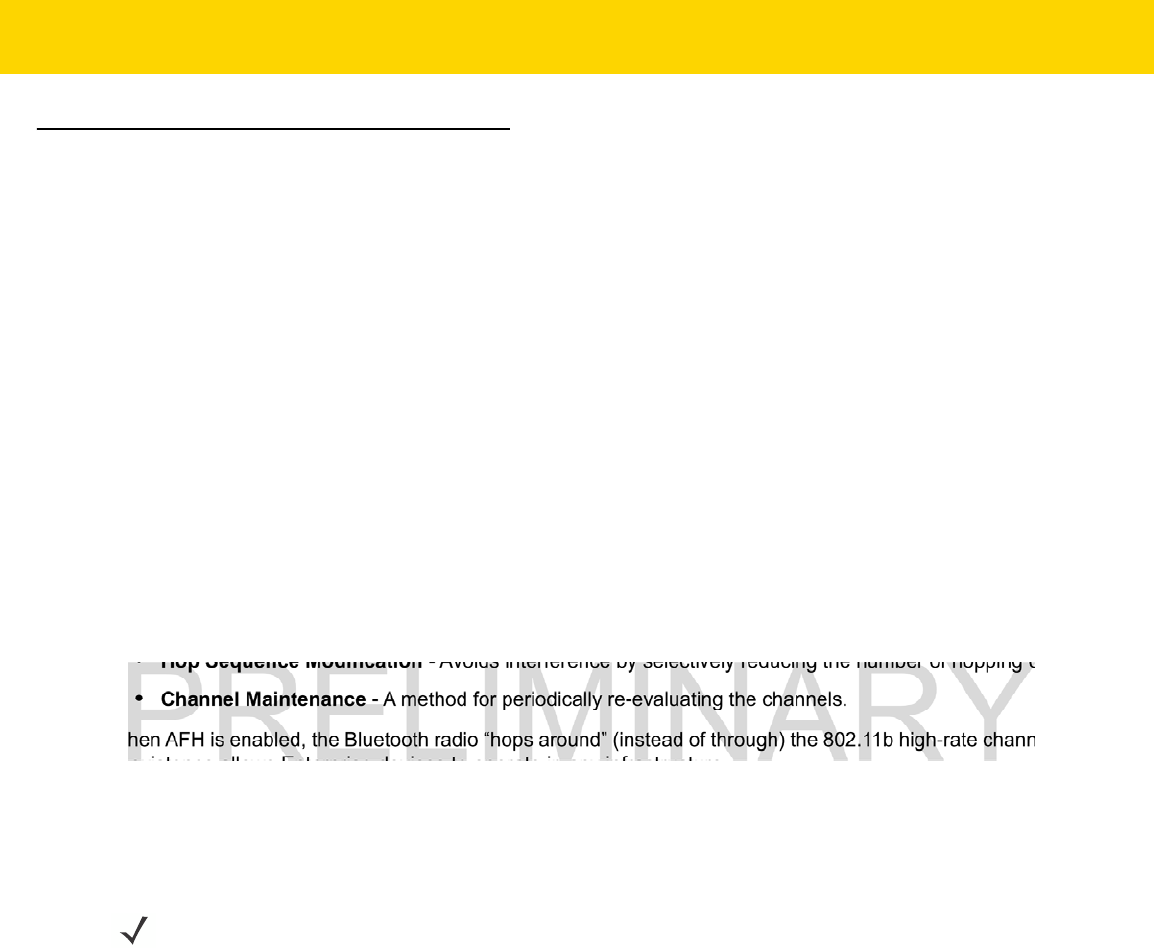
Wireless 4 - 11
Bluetooth
Bluetooth-equipped devices can communicate without wires, using frequency-hopping spread spectrum (FHSS)
radio frequency (RF) to transmit and receive data in the 2.4 GHz Industry Scientific and Medical (ISM) band
(802.15.1). Bluetooth wireless technology is specifically designed for short-range (10 meters (32.8 feet))
communication and low power consumption.
Devices with Bluetooth capabilities can exchange information (e.g., files, appointments, and tasks) with other
Bluetooth enabled devices such as printers, access points, and other mobile devices.
Adaptive Frequency Hopping
Adaptive Frequency Hopping (AFH) is a method of avoiding fixed frequency interferers, and can be used with
Bluetooth voice. All devices in the piconet (Bluetooth network) must be AFH-capable in order for AFH to work.
There is no AFH when connecting and discovering devices. Avoid making Bluetooth connections and discoveries
during critical 802.11b communications. AFH for Bluetooth consists of four main sections:
•
Channel Classification - A method of detecting an interference on a channel-by-channel basis, or
pre-defined channel mask.
•
Link Management - Coordinates and distributes the AFH information to the rest of the Bluetooth network.
•
Hop Sequence Modification - Avoids interference by selectively reducing the number of hopping channels.
•
Channel Maintenance - A method for periodically re-evaluating the channels.
When AFH is enabled, the Bluetooth radio “hops around” (instead of through) the 802.11b high-rate channels. AFH
coexistence allows Enterprise devices to operate in any infrastructure.
The Bluetooth radio in this device operates as a Class 2 device power class. The maximum output power is 2.5
mW and the expected range is 10 meters (32.8 ft.). A definition of ranges based on power class is difficult to obtain
due to power and device differences, and whether one measures open space or closed office space.
Security
The current Bluetooth specification defines security at the link level. Application-level security is not specified. This
allows application developers to define security mechanisms tailored to their specific need. Link-level security
occurs between devices, not users, while application-level security can be implemented on a per-user basis. The
Bluetooth specification defines security algorithms and procedures required to authenticate devices, and if needed,
encrypt the data flowing on the link between the devices. Device authentication is a mandatory feature of Bluetooth
while link encryption is optional.
Pairing of Bluetooth devices is accomplished by creating an initialization key used to authenticate the devices and
create a link key for them. Entering a common personal identification number (PIN) in the devices being paired
generates the initialization key. The PIN is never sent over the air. By default, the Bluetooth stack responds with no
key when a key is requested (it is up to user to respond to the key request event). Authentication of Bluetooth
devices is based-upon a challenge-response transaction. Bluetooth allows for a PIN or passkey used to create
other 128-bit keys used for security and encryption. The encryption key is derived from the link key used to
authenticate the pairing devices. Also worthy of note is the limited range and fast frequency hopping of the
Bluetooth radios that makes long-distance eavesdropping difficult.
Recommendations are:
NOTE
It is not recommended to perform Bluetooth wireless technology inquiry when high rate 802.11b
operation is required.
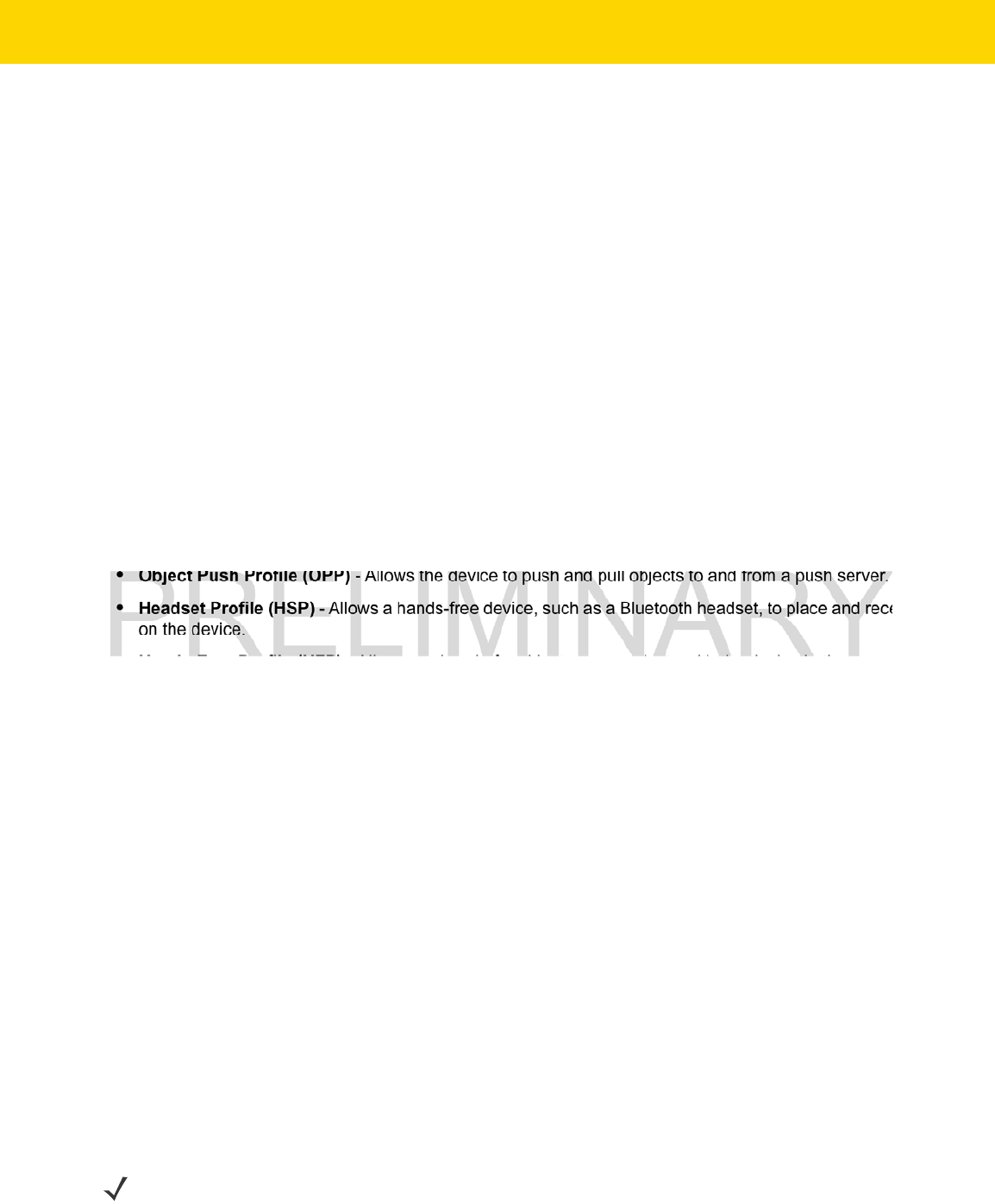
4 - 12 WT6000 User Guide
•
Perform pairing in a secure environment
•
Keep PIN codes private and do not store the PIN codes in the device
•
Implement application-level security.
Bluetooth Profiles
The device supports the following Bluetooth services:
•
Service Discovery Protocol (SDP) - Handles the search for known and specific services as well as general
services.
•
Serial Port Profile (SPP) - Allows use of RFCOMM protocol to emulate serial cable connection between two
Bluetooth peer devices. For example, connecting the device to a printer.
•
Advanced Audio Distribution Profile (A2DP) - Allows the device to stream stereo-quality audio to a
wireless headset or wireless stereo speakers.
•
Audio/Video Remote Control Profile (AVRCP) - Allows the device to control A/V equipment to which a user
has access. It may be used in concert with A2DP.
•
Human Interface Device Profile (HID) - Allows Bluetooth keyboards, pointing devices, gaming devices and
remote monitoring devices to connect to the device.
•
Object Push Profile (OPP) - Allows the device to push and pull objects to and from a push server.
•
Headset Profile (HSP) - Allows a hands-free device, such as a Bluetooth headset, to place and receive calls
on the device.
•
Hands-Free Profile (HFP) - Allows car hands-free kits to communicate with the device in the car.
•
Personal Area Network (PAN) - Allows the use of Bluetooth Network Encapsulation Protocol to provide L3
networking capabilities over a Bluetooth link. Only PANU role is supported.
•
Out of Band (OOB) - Allows exchange of information used in the pairing process. Pairing is completed using
the Bluetooth radio, but requires information from the OOB mechanism. Using OOB with NFC enables
pairing when devices simply get close, rather than requiring a lengthy discovery process.
Bluetooth Power States
The Bluetooth radio is off by default.
•
Suspend - When the WT6000 goes into suspend mode, the Bluetooth radio stays on.
•
Airplane Mode - When the WT6000 is placed in Airplane Mode, the Bluetooth radio turns off. When Airplane
mode is disabled, the Bluetooth radio returns to the prior state. When in Airplane Mode, the Bluetooth radio
can be turned back on if desired.
Bluetooth Radio Power
Turn off the Bluetooth radio to save power or if entering an area with radio restrictions (e.g., an airplane). When the
radio is off, other Bluetooth devices cannot see or connect to the device. Turn on the Bluetooth radio to exchange
information with other Bluetooth devices (within range). Communicate only with Bluetooth radios in close proximity.
NOTE
To achieve the best battery life turn off radios when not in use.
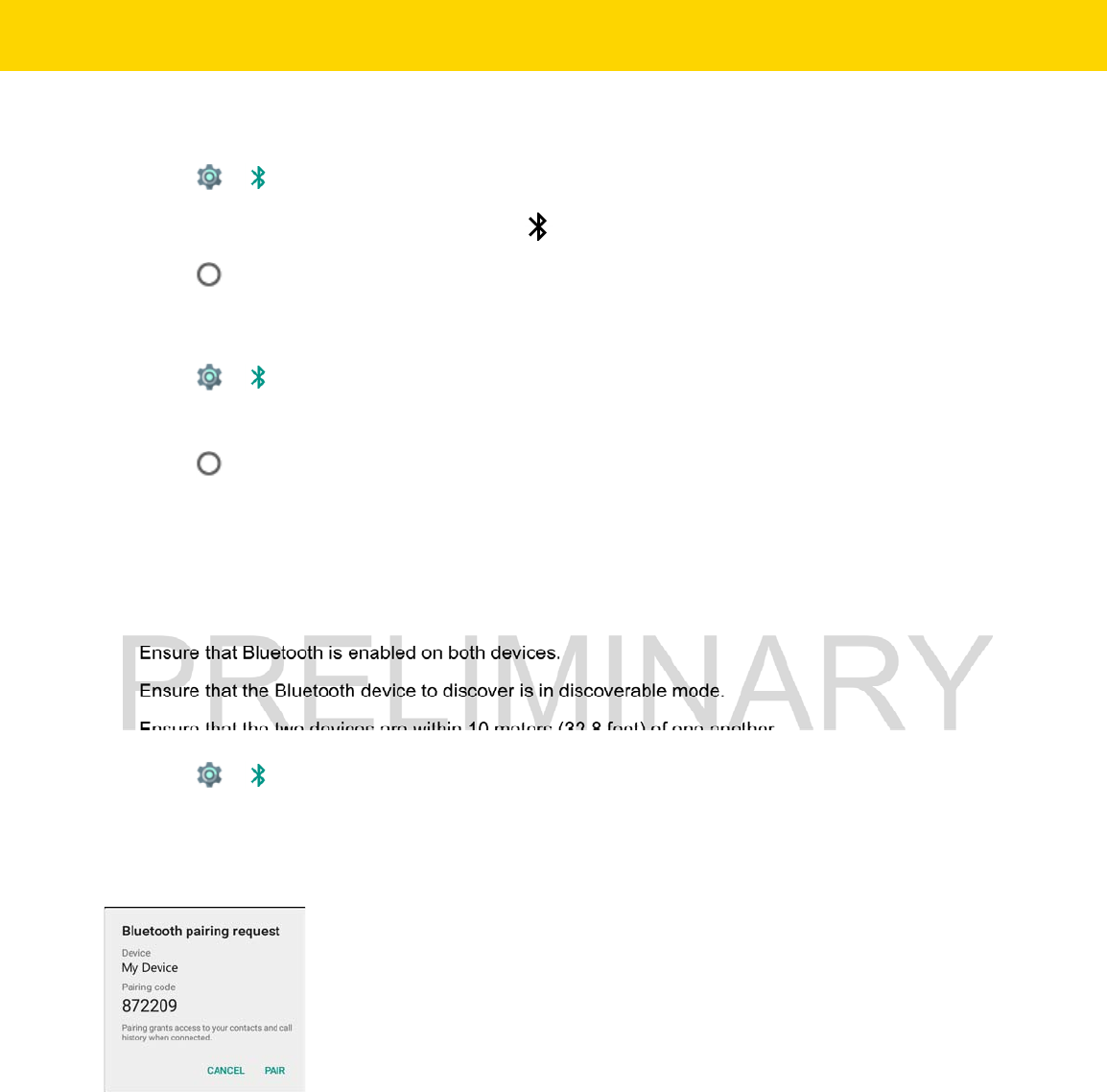
Wireless 4 - 13
Enabling Bluetooth
1. Touch > Bluetooth.
2. Slide the switch to the right. ON appears and appears in the Status bar.
3. Touch .
Disabling Bluetooth
1. Touch > Bluetooth.
2. Slide the switch to the left. OFF appears.
3. Touch .
Discovering Bluetooth Device(s)
The WT6000 can receive information from discovered devices without pairing. However, once paired, the WT6000
and a paired device exchange information automatically when the Bluetooth radio is on. To find Bluetooth devices
in the area:
1. Ensure that Bluetooth is enabled on both devices.
2. Ensure that the Bluetooth device to discover is in discoverable mode.
3. Ensure that the two devices are within 10 meters (32.8 feet) of one another.
4. Touch > Bluetooth.
5. The WT6000 begins searching for discoverable Bluetooth devices in the area and displays them under
Available devices.
6. Scroll through the list and select a device. The Bluetooth pairing request dialog box appears.
Figure 4-11 Bluetooth Pairing - Smart Pairing
7. Enter a PIN in the text box and touch OK. Enter the same PIN on the other device.
8. For Simple Pairing, touch Pair on both devices.
9. The Bluetooth device is added to the Paired devices list and a trusted (“paired”) connection is established.
Changing the Bluetooth Name
By default, the WT6000 has a generic Bluetooth name that is visible to other devices when connected.
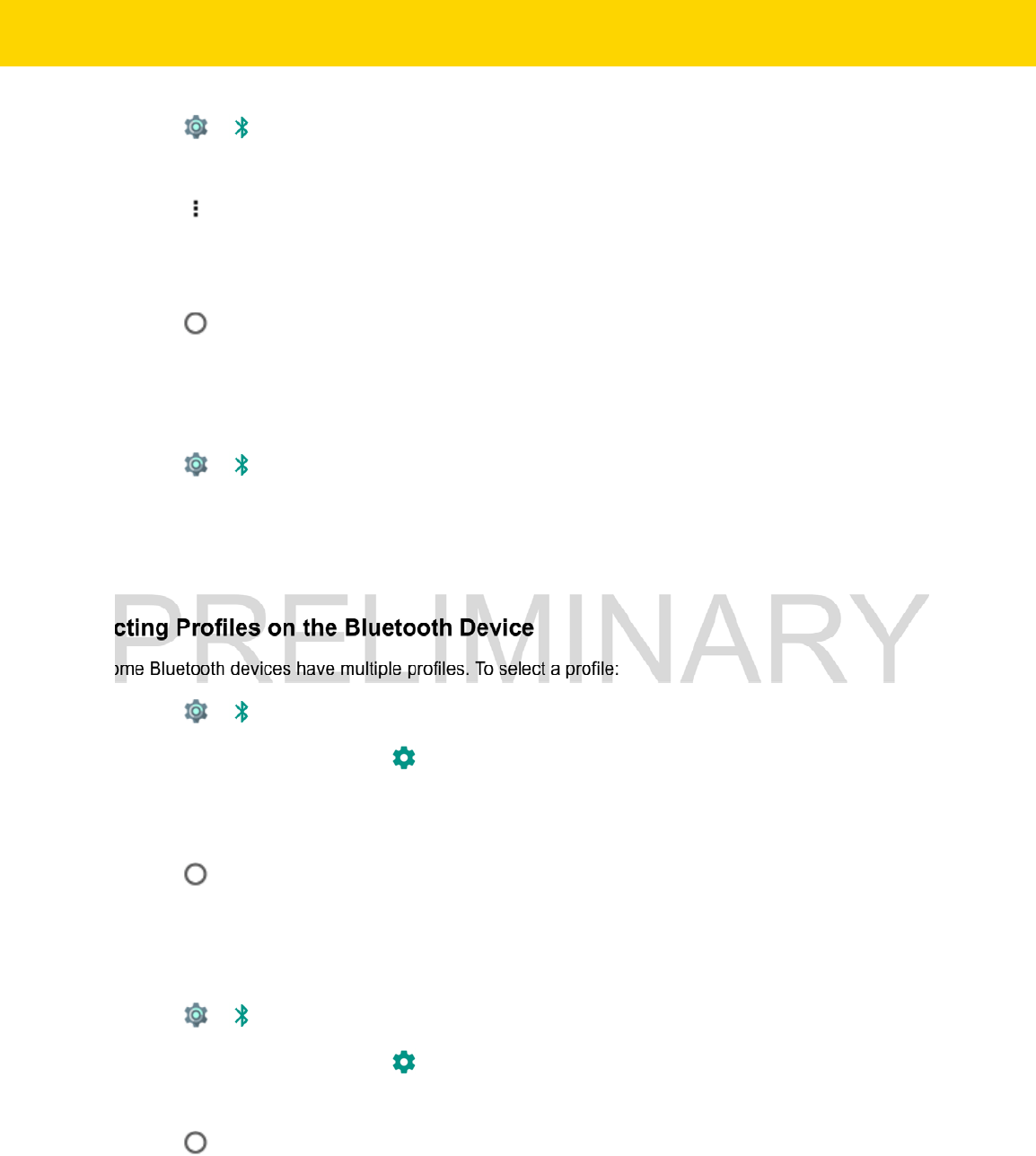
4 - 14 WT6000 User Guide
1. Touch > Bluetooth.
2. If Bluetooth is not on, slide the switch to the ON position.
3. Touch .
4. Touch Rename this device.
5. Enter a name and touch Rename.
6. Touch .
Connecting to a Bluetooth Device
Once paired, connect to a Bluetooth device.
1. Touch > Bluetooth.
2. If Bluetooth is not on, slide the switch to the ON position.
3. In the Paired devices list, touch and hold on a unconnected Bluetooth device until a menu appears.
4. Touch Connect. When connected, the device is displayed as connected in the list.
Selecting Profiles on the Bluetooth Device
Some Bluetooth devices have multiple profiles. To select a profile:
1. Touch > Bluetooth.
2. In the Paired devices list, touch next to the device name.
3. Under Use for, check or uncheck a profile to allow the device to use that profile.
4. Touch OK.
5. Touch .
Unpairing a Bluetooth Device
To unpair a Bluetooth device and erase all pairing information:
1. Touch > Bluetooth.
2. In the Paired devices list, touch next to the device name.
3. Touch FORGET.
4. Touch .
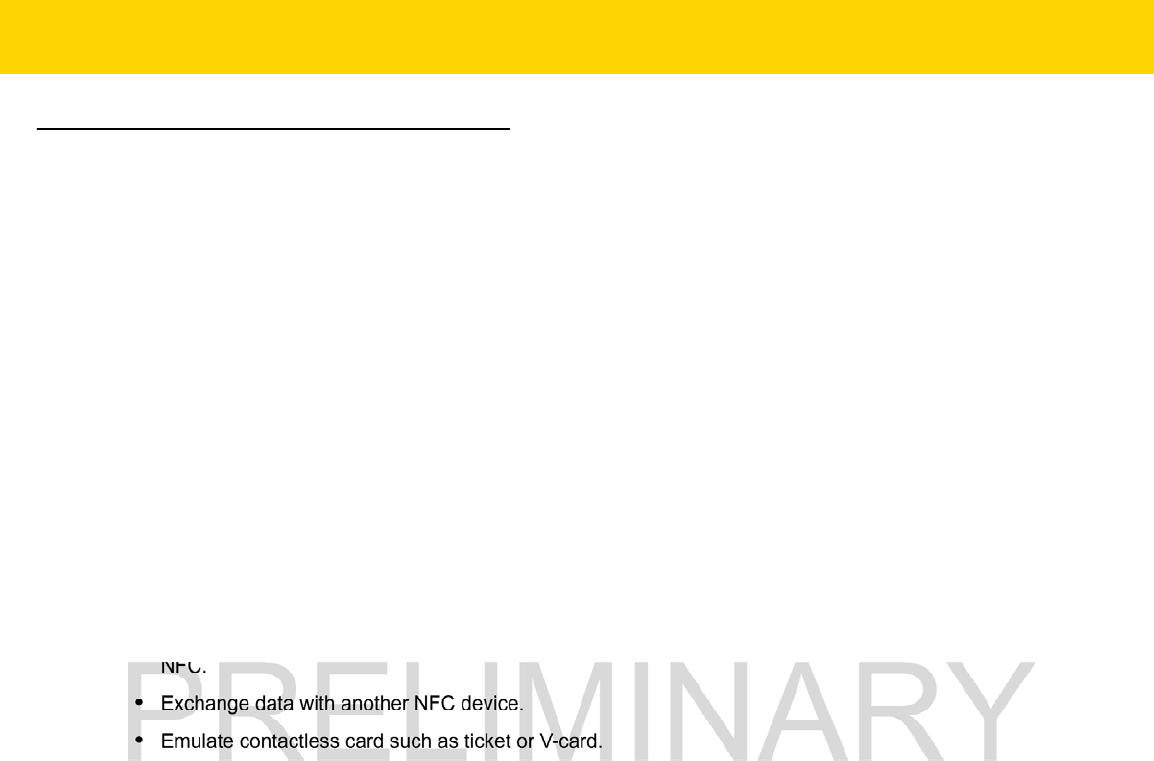
Wireless 4 - 15
Near Field Communications
NFC/HF RFID is a short-range wireless connectivity technology standard that enables secure transaction between
a reader and a contactless smart card. The technology is based on ISO/IEC 14443 type A and B (proximity), Felica
and ISO/IEC 15693 (vicinity) standards, using the HF 13.56 MHz unlicensed band. The WT6000 supports three
operating modes:
•
Reader mode
•
Peer-to-Peer communication
•
Card Emulation mode.
Using NFC, the WT6000 can:
•
Read contactless cards such as contactless tickets, NFC labels, HF tokens or standard smart cards.
•
Read and write information to contactless cards such as SmartPosters and tickets, as well as devices with
NFC interface such as vending machines.
•
Read information from supported medical sensors.
•
Pair with supported Bluetooth devices such as printers and headsets. See Pairing Using Near Field
Communication on page 3-6 for instruction on pairing the RS6000 Ring Scanner with the WT6000 using
NFC.
•
Exchange data with another NFC device.
•
Emulate contactless card such as ticket or V-card.
The WT6000 NFC antenna is uniquely positioned to read NFC cards from the front of the device.
Reading NFC Cards
1. Make sure both NFC and Android Beam turned on.
a. Touch Settings > More.
b. Ensure that the NFC switch is in the on (green) position.
c. Touch Android Beam.
d. Slide the switch to the on (green) position.
e. Touch Home.
2. Launch an NFC enabled application.
3. Hold device as shown.
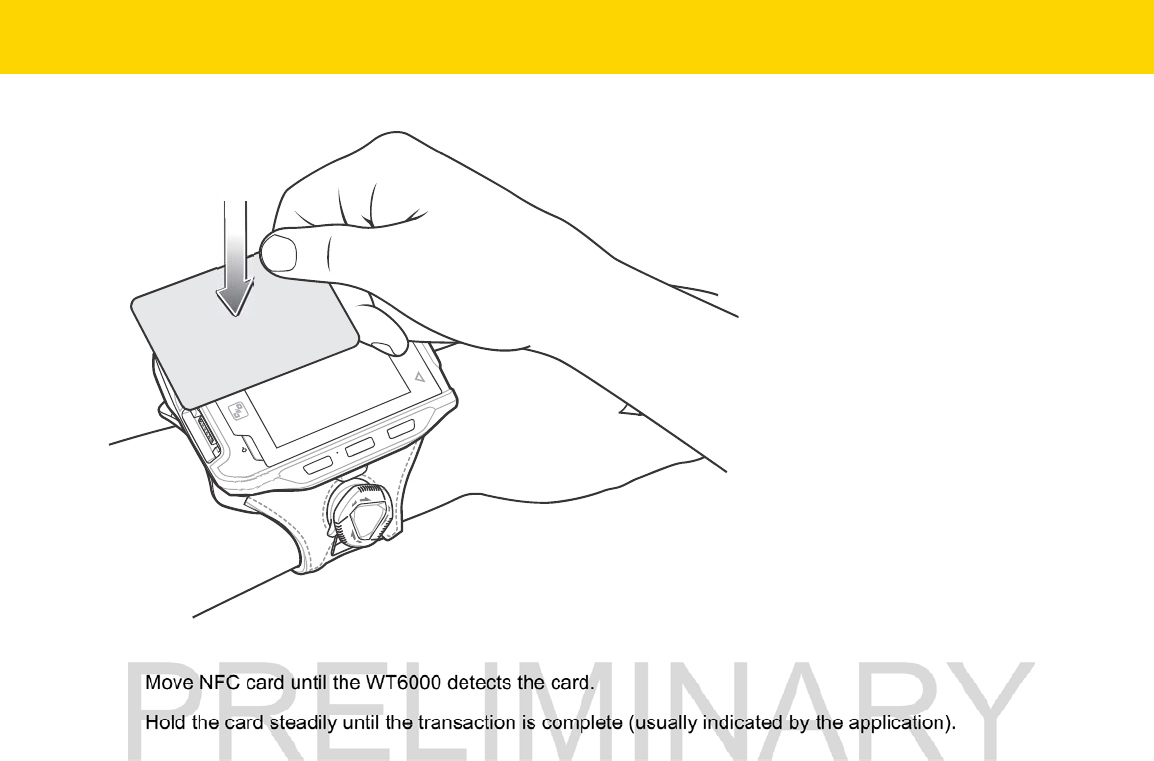
4 - 16 WT6000 User Guide
Figure 4-12 Reading NFC Card
4. Move NFC card until the WT6000 detects the card.
5. Hold the card steadily until the transaction is complete (usually indicated by the application).
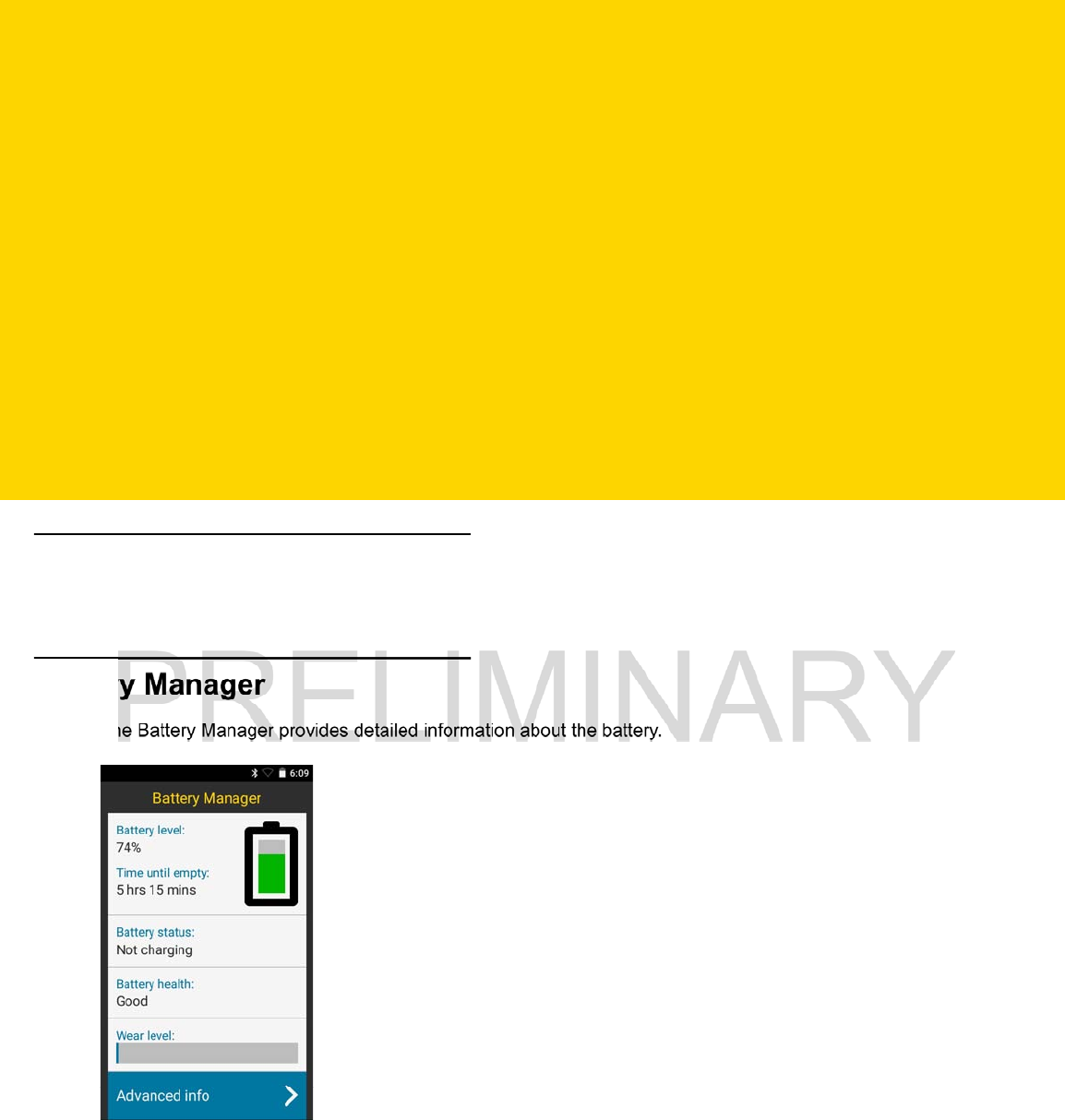
CHAPTER 5 APPLICATIONS
Introduction
This chapter describes the applications installed on the device.
Battery Manager
The Battery Manager provides detailed information about the battery.
Figure 5-1 Battery Manager Screen
Battery level - Indicate the current battery charge level.
Time until empty - Indicates the amount of time before the battery is depleted. Displays when the WT6000 is not
on AC power.
Time until full - Indicates the amount of time until the battery is fully charged. Displays when the WT6000 is on AC
power.

5 - 2 WT6000 User Guide
•
Battery status
• Not charging - Indicates that the WT6000 is not connected to AC power.
• Charging over AC - Indicates that the WT6000 is connected to AC power and charging.
•
Battery health - Indicates the health of the battery.
•
Wear level - NEED INFO
•
Advanced info - Tap to view additional battery information.
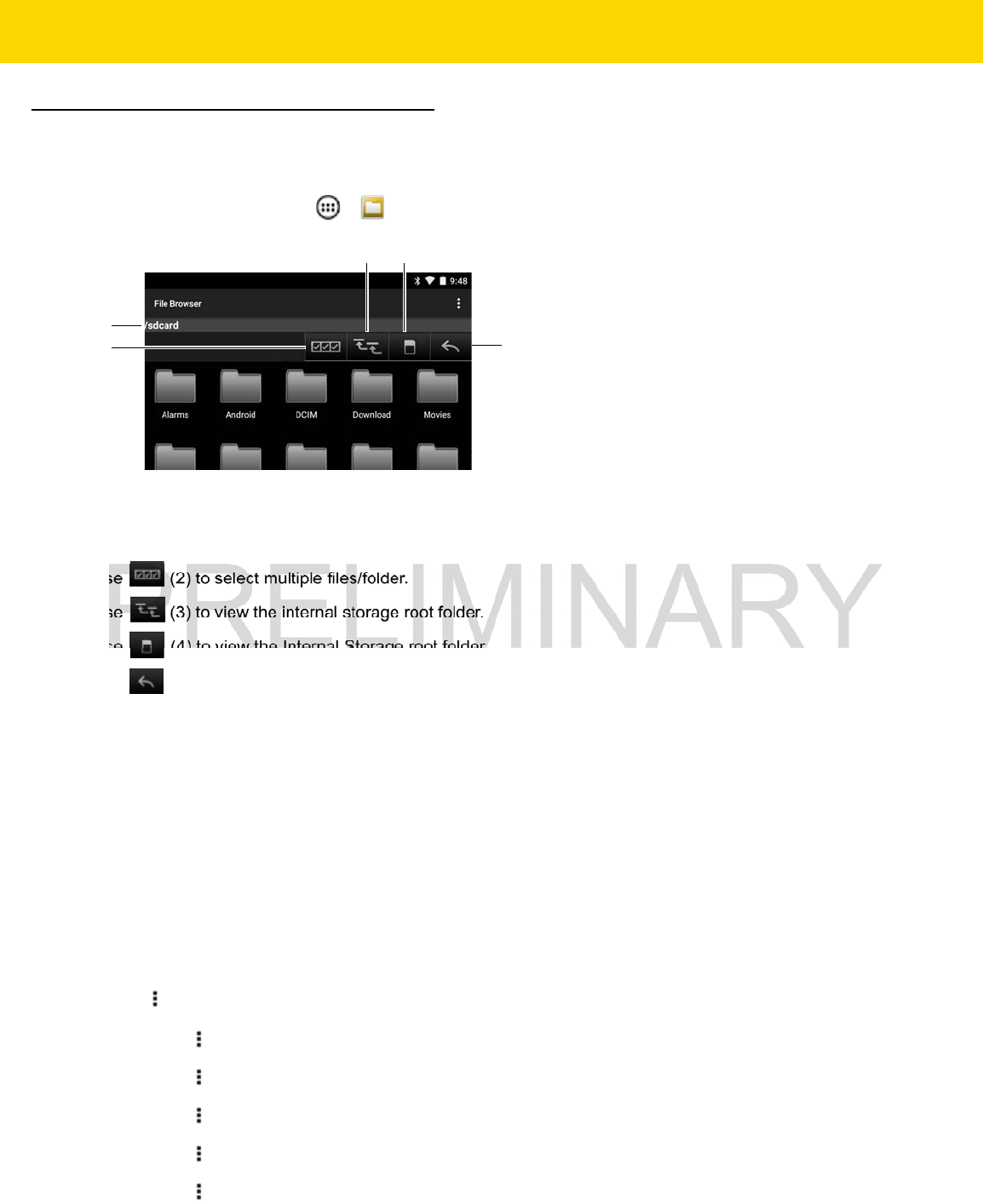
Applications 5 - 3
File Browser
Use the File Browser application to view and mange files on the device.
To open File Browser, touch > .
Figure 5-2 File Browser Screen
The address bar (1) indicates the current folder path. Touch the current folder path to manually enter a path and
folder name.
Use (2) to select multiple files/folder.
Use (3) to view the internal storage root folder.
Use (4) to view the Internal Storage root folder.
Use (5) to view the previous folder or to exit the application.
Touch and hold an item to perform an operation on that item. Select one of the options from the File Operations
menu:
•
Information - View detailed information about the file or folder.
•
Move - Move the file or folder to a new location.
•
Copy - Copy the select file.
•
Delete - Delete the selected file.
•
Rename - Rename the select file.
•
Open as - Open the selected file as a specific file type.
•
Share - Share the file with other devices.
Touch to open additional functionality:
•
Touch > New Folder to create a new folder in the current folder.
•
Touch > Search to search for a file or folder.
•
Touch > Sort to sort the list by name, by type, by size or by date.
•
Touch > Refresh to re-display the contents of the current folder.
•
Touch > List View to change the folder view from tile to list format.
1
2
3 4
5

5 - 4 WT6000 User Guide
•
Touch > Change Size to change the size of the icons: Large, Normal or Small.
•
Touch > About File Browser to view the application version information.
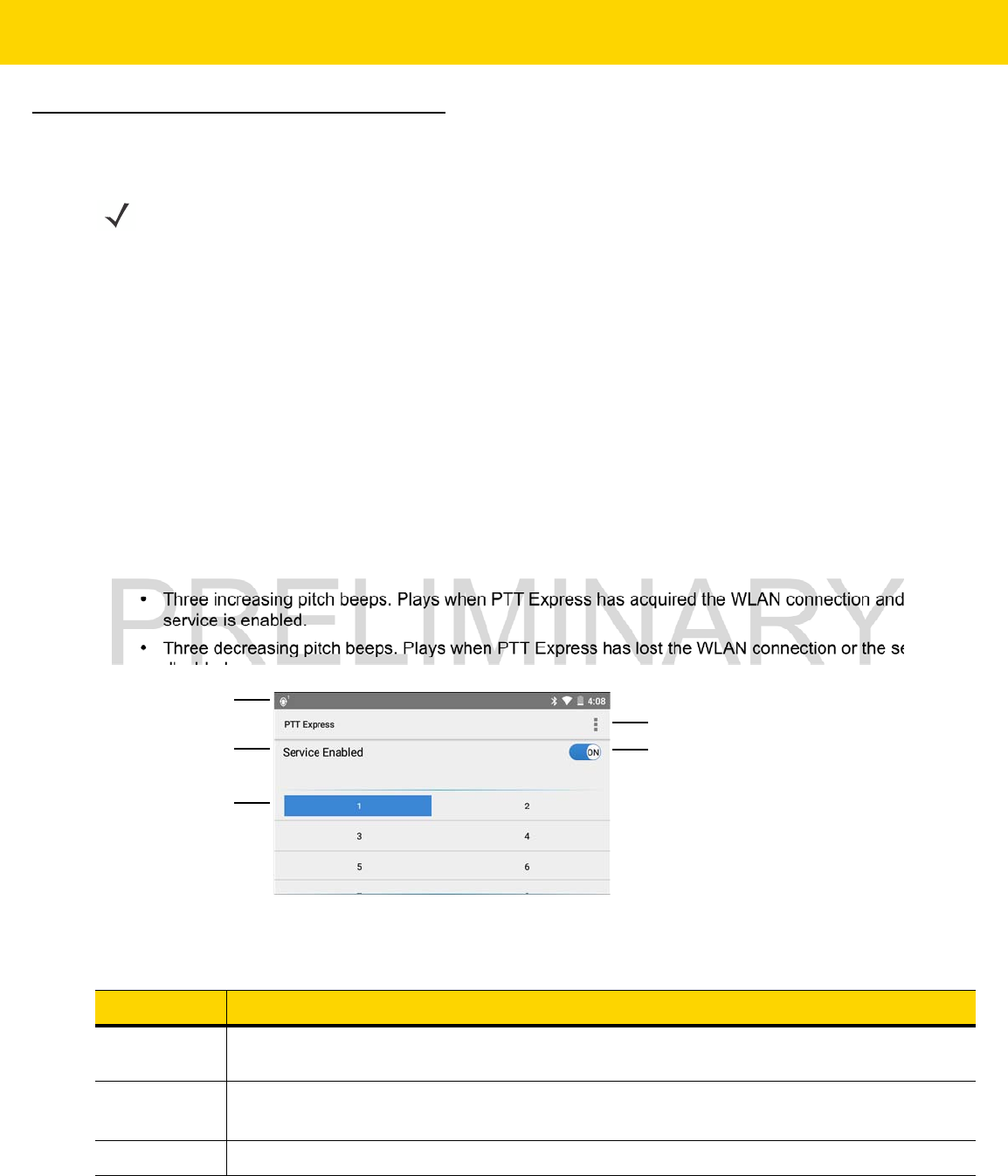
Applications 5 - 5
PTT Express Voice Client
•
Group Call: Press and hold the PTT (Talk) button to start communicating with other voice client users.
PTT Audible Indicators
The following tones provide helpful cues when using the voice client.
•
Talk Tone: Double chirp. Plays when the Talk button is depressed. This is a prompt for the user to start
talking.
•
Access Tone: Single beep. Plays when another user just finished a broadcast or response. The user is now
able to initiate a Group Broadcast or Private Response.
•
Busy Tone: Continuous tone. Plays when the Talk button is depressed and another user is already
communicating on the same talkgroup. Plays after the maximum allowed talk time is reached (60 seconds).
•
Network Tone:
•Three increasing pitch beeps. Plays when PTT Express has acquired the WLAN connection and the
service is enabled.
•Three decreasing pitch beeps. Plays when PTT Express has lost the WLAN connection or the service is
disabled.
Figure 5-3 PTT Express Default User Interface
NOTE
PTT Express Voice Client creates Push-To-Talk (PTT) communication capability between disparate enterprise
devices. Leveraging existing Wireless Local Area Network (WLAN) infrastructure, PTT Express delivers simple
PTT communication without the need of a voice communication server.
Table 5-1 PTT Express Default User Interface Descriptions
Item Description
Notification
Icon
Indicates the current state of the PTT Express client.
Service
Indication
Indicates the status of the PTT Express client. Options: Service Enabled, Service Disabled
or Service Unavailable.
Talk Groups Lists all 32 Talk Groups available for PTT communication.
Settings
Enable/Disable Switch
Notification Icon
Service Indication
Talk Groups
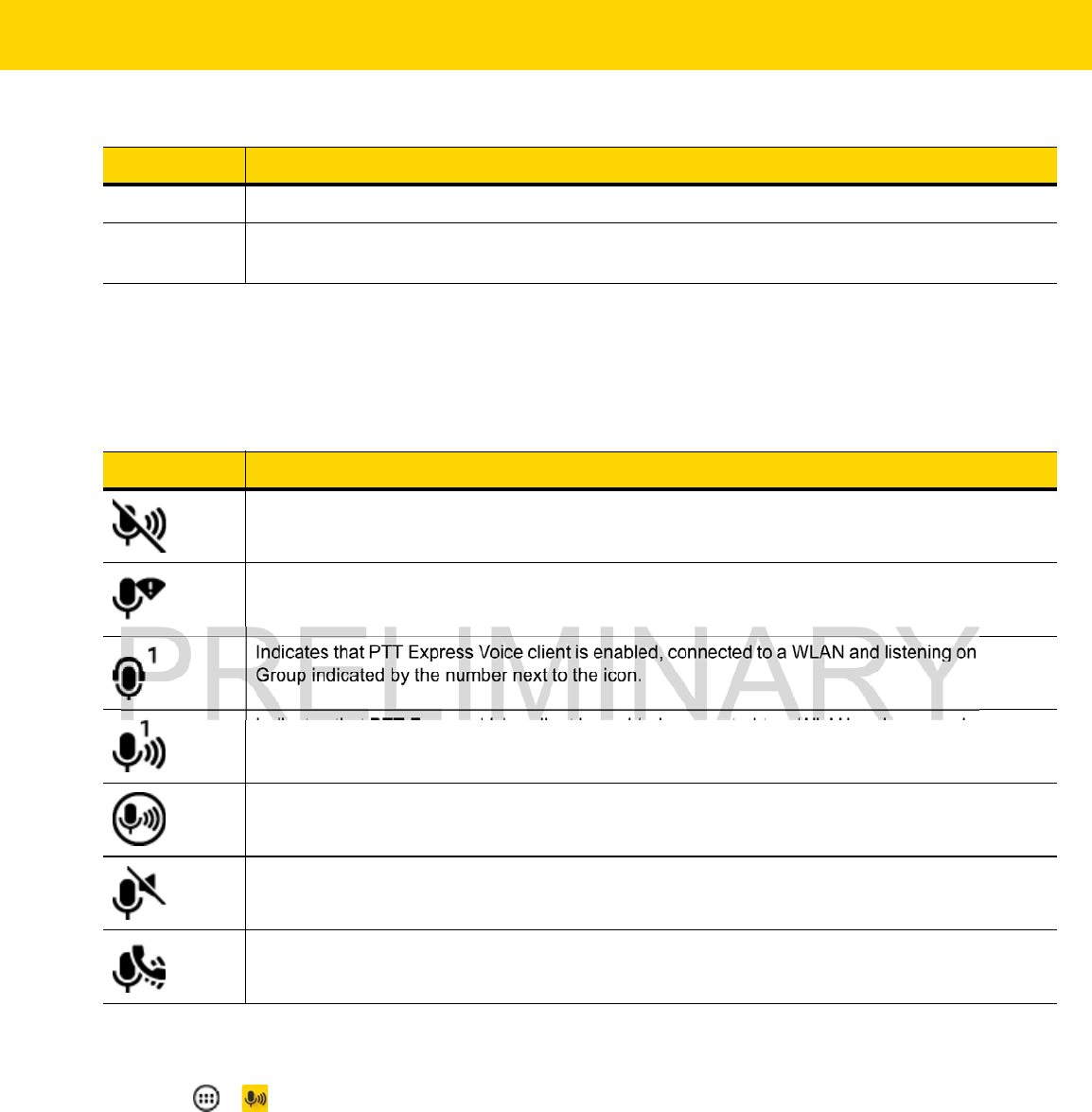
5 - 6 WT6000 User Guide
Notification Icons
Indicates the current state of the PTT Express Voice client.
Enabling PTT Communication
1. Touch > .
2. Slide the Enable/Disable Switch to the ON position. The button changes to an ON button.
Selecting a Talk Group
One of 32 Talk Groups can be selected by PTT Express users. However, only one talk group may be enabled at a
time on the device. Touch one of the 32 Talk Groups. The selected Talk Group is highlighted.
Settings Opens the PTT Express Settings screen.
Enable/Disable
Switch
Turns the PTT service on and off.
Table 5-1 PTT Express Default User Interface Descriptions (Continued)
Item Description
Table 5-2 PTT Express Default User Interface Descriptions
Status Icon Description
Indicates that PTT Express Voice client is disabled.
Indicates that PTT Express Voice client is enabled but not connected to a WLAN.
Indicates that PTT Express Voice client is enabled, connected to a WLAN and listening on the Talk
Group indicated by the number next to the icon.
Indicates that PTT Express Voice client is enabled, connected to a WLAN and communicating on
the Talk Group indicated by the number next to the icon.
Indicates that PTT Express Voice client is enabled, connected to a WLAN and in a private
response.
Indicates that PTT Express Voice client is enabled and muted.
Indicates that the PTT Express Voice client is enabled but it is not able to communicate due to a
VoIP telephony call is in progress.
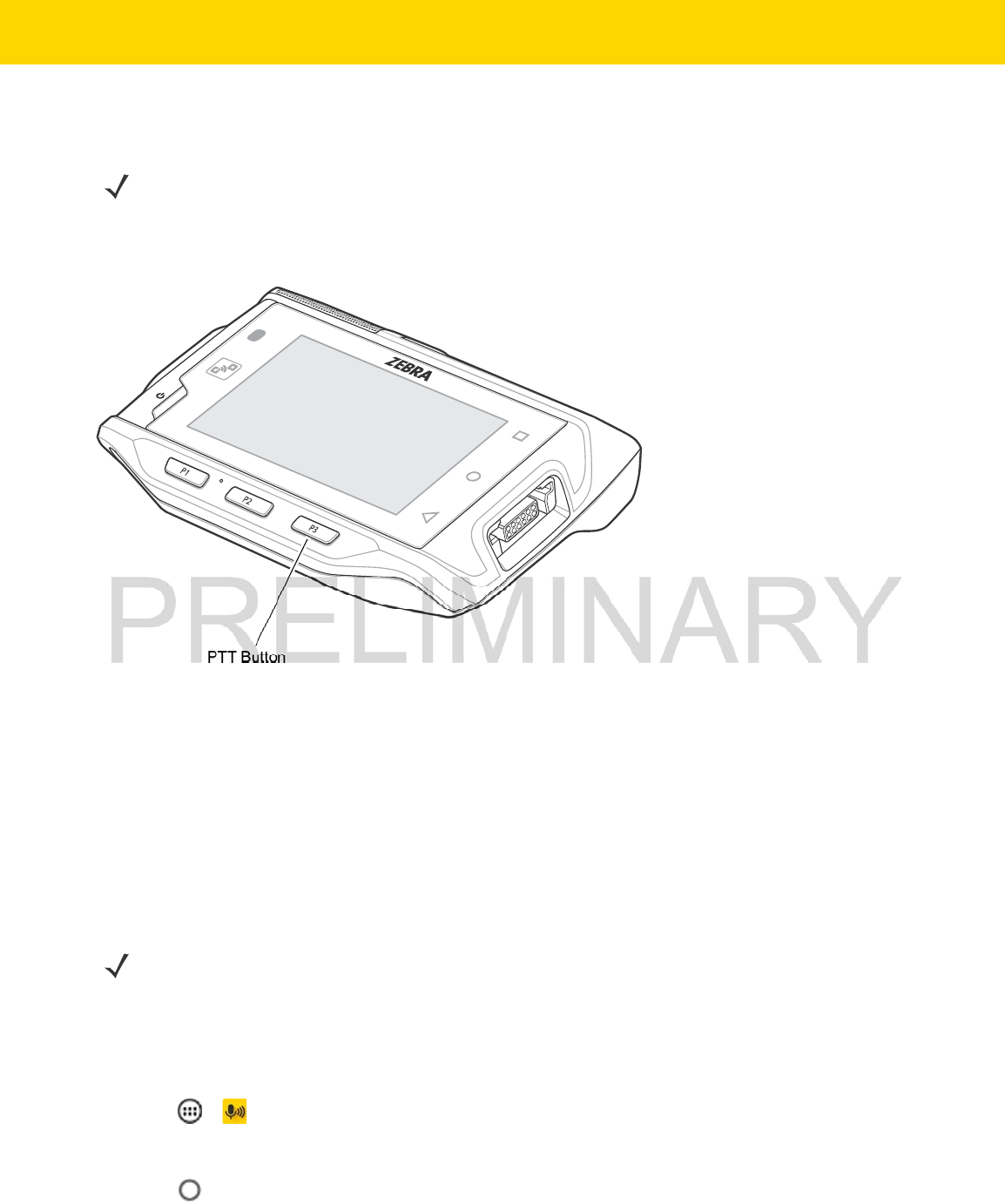
Applications 5 - 7
PTT Communication
PTT communication may be established as a Group Call. When PTT Express is enabled, the P3 button is assigned
for PTT communication.
Figure 5-4 PTT Button
Creating a Group Call
To create a group call:
1. Press and hold the PTT button and listen for the talk tone to play.
If a busy tone is heard, release the button and wait a moment before making another attempt. Ensure that PTT
Express and the WLAN are enabled.
2. Start talking after the talk tone is heard.
3. Release the button when finished talking.
Disabling PTT Express Voice Client Communication
1. Touch > .
2. Slide the Enable/Disable Switch to the OFF position. The button changes to OFF.
3. Touch .
NOTE
This section describes the default PTT Express client configuration. See the PTT Express V1.2 User
Guide for detailed information on using the client.
PTT Button
NOTE
If the user holds the button for more than 60 seconds (default), the call is dropped allowing others to make
Group calls. The user should release the button when finished talking to allow others to make calls.

5 - 8 WT6000 User Guide
DataWedge
Refer to the WT6000 Integrator Guide for detailed information on configuring DataWedge.
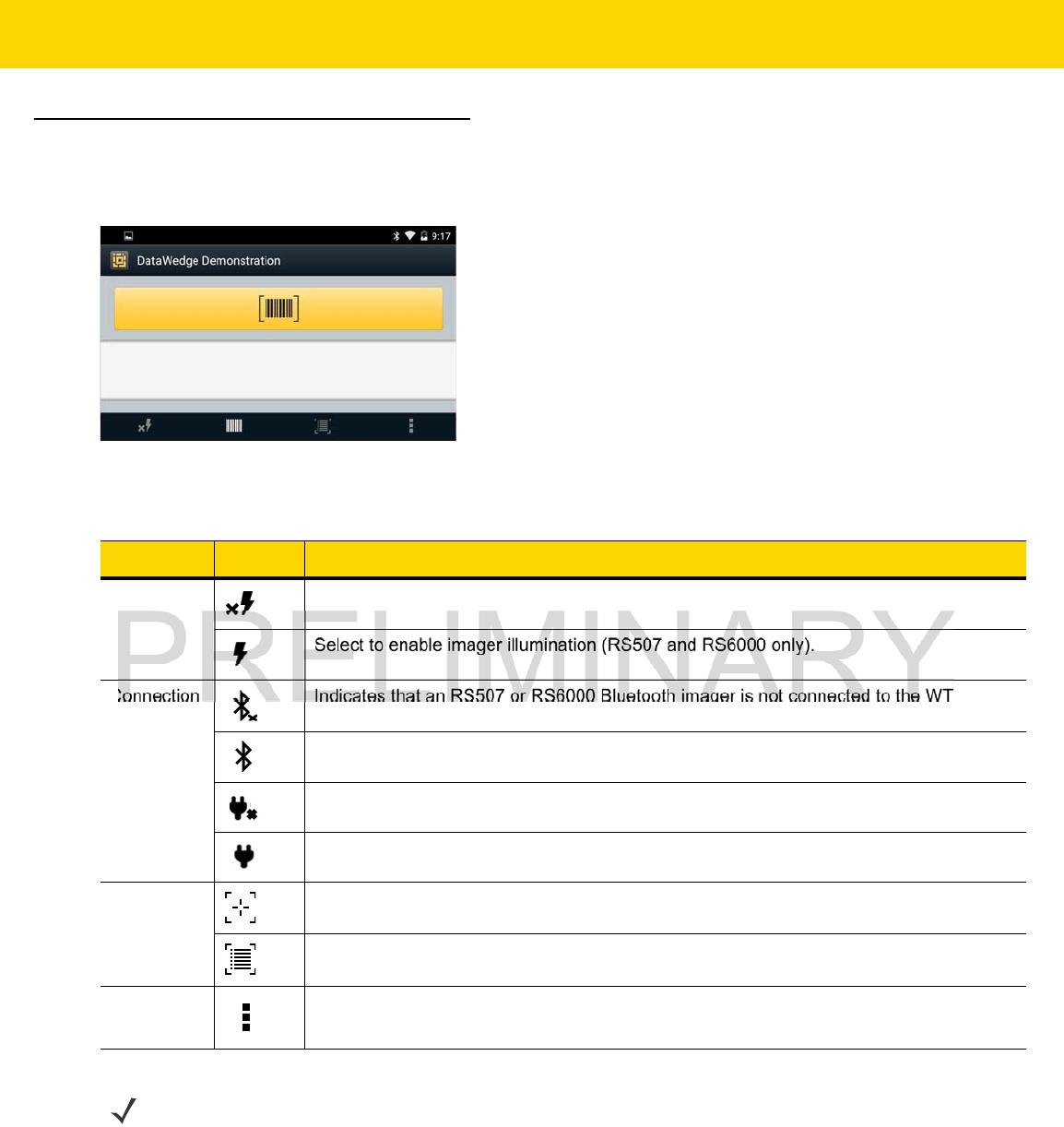
Applications 5 - 9
DataWedge Demonstration
Use DataWedge Demonstration to demonstrate data capture functionality.
Figure 5-5 DataWedge Demonstration Window
Either press the device Scan key or touch the yellow scan button in the application to enable data capture. The
captured data appears in the text field below the yellow button.
Table 5-3 DataWedge Demonstration Icons
Feature Icon Description
Illumination Select to disable imager illumination (RS507 and RS6000 only).
Select to enable imager illumination (RS507 and RS6000 only).
Connection Indicates that an RS507 or RS6000 Bluetooth imager is not connected to the WT6000.
Indicates that an RS507 or RS6000 Bluetooth imager is connected to the WT6000.
Indicates that an RS4000 laser scanner is not connected to the WT6000.
Indicates that an RS4000 laser scanner is connected to the WT6000.
Scan Mode Select to enable picklist mode (RS507 and RS6000 only).
Select to enable normal scan mode (RS507 and RS6000 only).
Menu Opens a menu to view the application information or to set the application DataWedge
profile.
NOTE
See WT6000 Integrator Guide for information on DataWedge configuration.
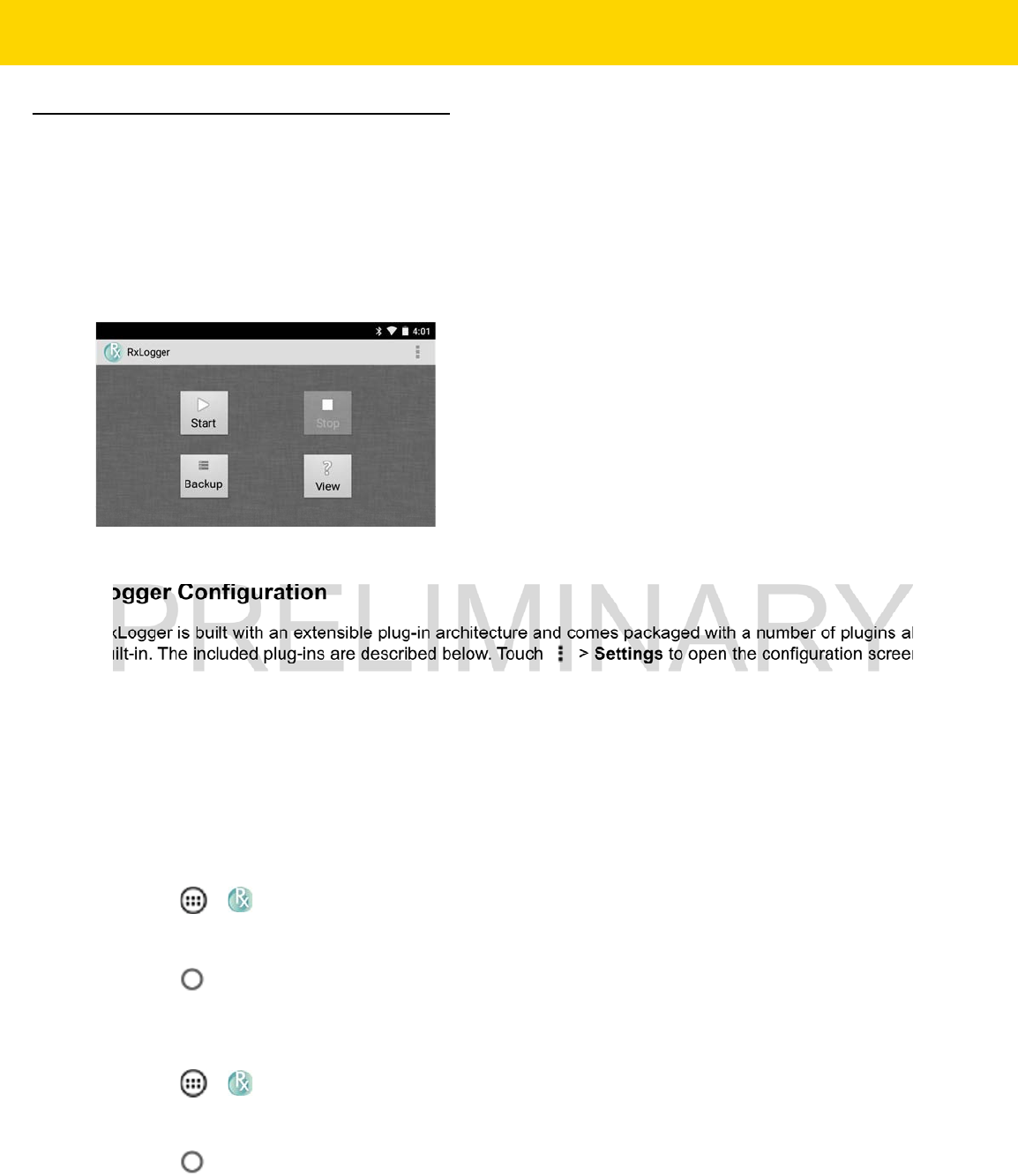
5 - 10 WT6000 User Guide
RxLogger
RxLogger is a comprehensive diagnostic tool that provides application and system metrics. It allows for custom
plug-ins to be created and work seamlessly with this tool. RxLogger is used to diagnose device and application
issues. Its information tracking includes the following: CPU load, memory load, memory snapshots, battery
consumption, power states, wireless logging, cellular logging, TCP dumps, Bluetooth logging, GPS logging, logcat,
FTP push/pull, ANR dumps, etc. All logs and files generated are saved onto flash storage on the device (internal or
external).
Figure 5-6 RxLogger
RxLogger Configuration
RxLogger is built with an extensible plug-in architecture and comes packaged with a number of plugins already
built-in. The included plug-ins are described below. Touch > Settings to open the configuration screen.
Configuration File
RxLogger configuration can be set using an XML file. The config.xml configuration file is located on the Enterprise
storage in the RxLogger\config folder. Copy the file from the device to a host computer using a USB connection.
Edit the configuration file and the replace the .XML file on the device. There is no need to stop and restart the
RxLogger service since the file change is automatically detected.
Enabling Logging
1. Touch > .
2. Touch Start.
3. Touch .
Disabling Logging
1. Touch > .
2. Touch Stop.
3. Touch .

Applications 5 - 11
Extracting Log Files
1. Connect the device to a host computer using an USB connection.
2. Using a file explorer, navigate to the Internal Storage in the /RxLogger folder.
3. Copy the file from the device to the host computer.
4. Disconnect the device from the host computer.
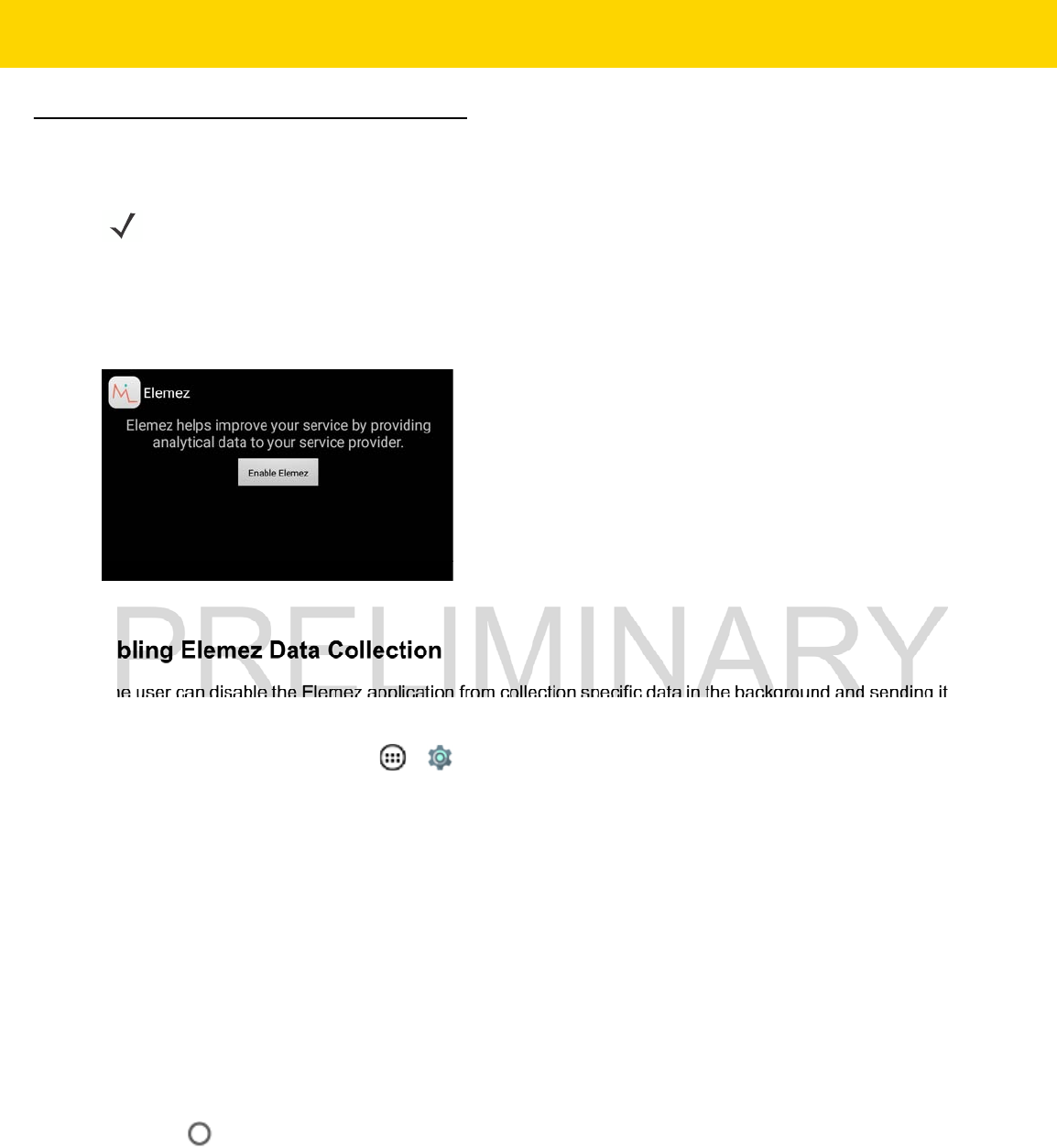
5 - 12 WT6000 User Guide
Elemez
Use Elemez to provide diagnostics information to us. Touch Submit Diagnostics button to send the data.
Figure 5-7 Elemez Application
Disabling Elemez Data Collection
The user can disable the Elemez application from collection specific data in the background and sending it to Zebra
Technologies.
1. From the Home screen, touch > > Apps.
2. Swipe left or right until the ALL tab displays.
3. Scroll through the list and touch Elemez.
4. In the App info screen, touch Uninstall updates.
5. In the Uninstall updates dialog box, touch OK.
6. Touch OK.
7. After uninstall is complete, touch OK.
8. In the All tab, scroll through the list and touch Elemez.
9. Touch Disable.
10. In the Disable built-in app? dialog box, touch OK.
11. Touch .
Enabling Elemez Data Collection
The user can re-enable the Elemez application for collection specific data in the background and sending it to
Zebra Technologies.
NOTE
Elemez collects specific device information in the background and sends this information to us to help
improve product functionality. This feature can be disabled.
See Disabling Elemez Data Collection. Ensure that the date, time and time zone are set correctly prior to
using Elemez.
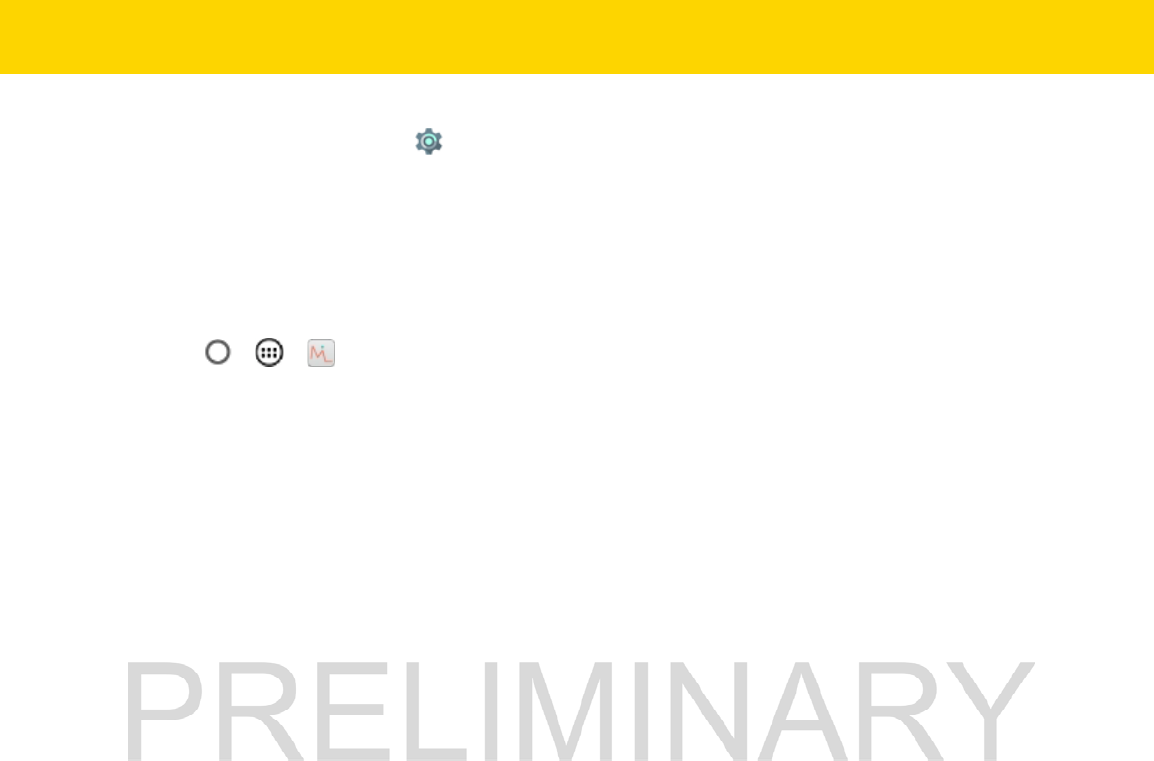
Applications 5 - 13
1. From the Home screen, touch .
2. Touch Manage Apps.
3. Swipe left or right until the ALL tab displays.
4. Scroll through the list and touch Elemez.
5. In the App info screen, touch Enable.
6. Touch > > .
7. Touch Enable Elemez.

5 - 14 WT6000 User Guide
Print Station
Use the Print Station application to print labels and receipts directly to a Zebra ZPL printer via USB, Bluetooth or
WLAN.
Features include:
•
Discovering and pairing with Zebra printers via a Bluetooth, WLAN or USB connection.
•
Retrieving and displaying a list of document templates stored on the device and on the printer.
•
Using document templates to generate on-screen prompts allowing data entry at print time.
•
Using the camera on the device to scan bar codes for data entry.
•
Supports multiple Zebra printer models using the ZPL command language.

Applications 5 - 15
Printer Setup
NEED INFO
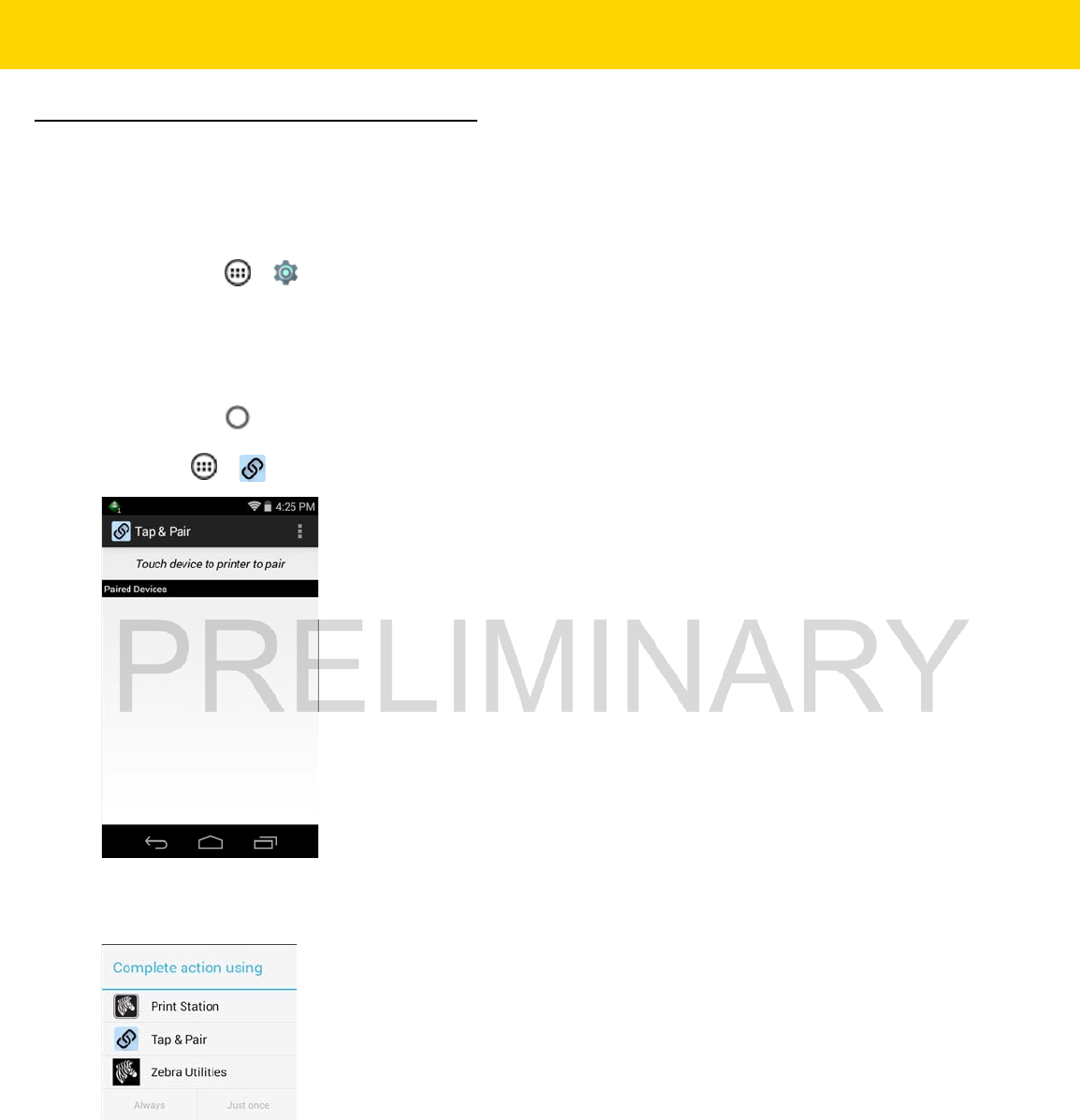
5 - 16 WT6000 User Guide
Tap & Pair
Use the Tap & Pair application to easily connect to a Zebra printer.
1. Enable Bluetooth and NFC:
a. Touch > .
b. Slide the Bluetooth switch to the ON position.
c. Touch More... .
d. Touch NFC checkbox. A blue check mark appears indicating that NFC is enabled.
e. Touch .
2. Touch > .
Figure 5-8 Tap & Pair Application
3. Touch the back of the WT6000 to the NFC logo on the Zebra printer.
Figure 5-9 Complete Action Dialog Box
4. Tap Tap & Pair and then tap Just once.
The printer displays the pair code on the display. Verify that this code matches the code shown on the
WT6000.
5. Tap PAIR.
6. Verify that the Zebra printer is in the list of paired devices.
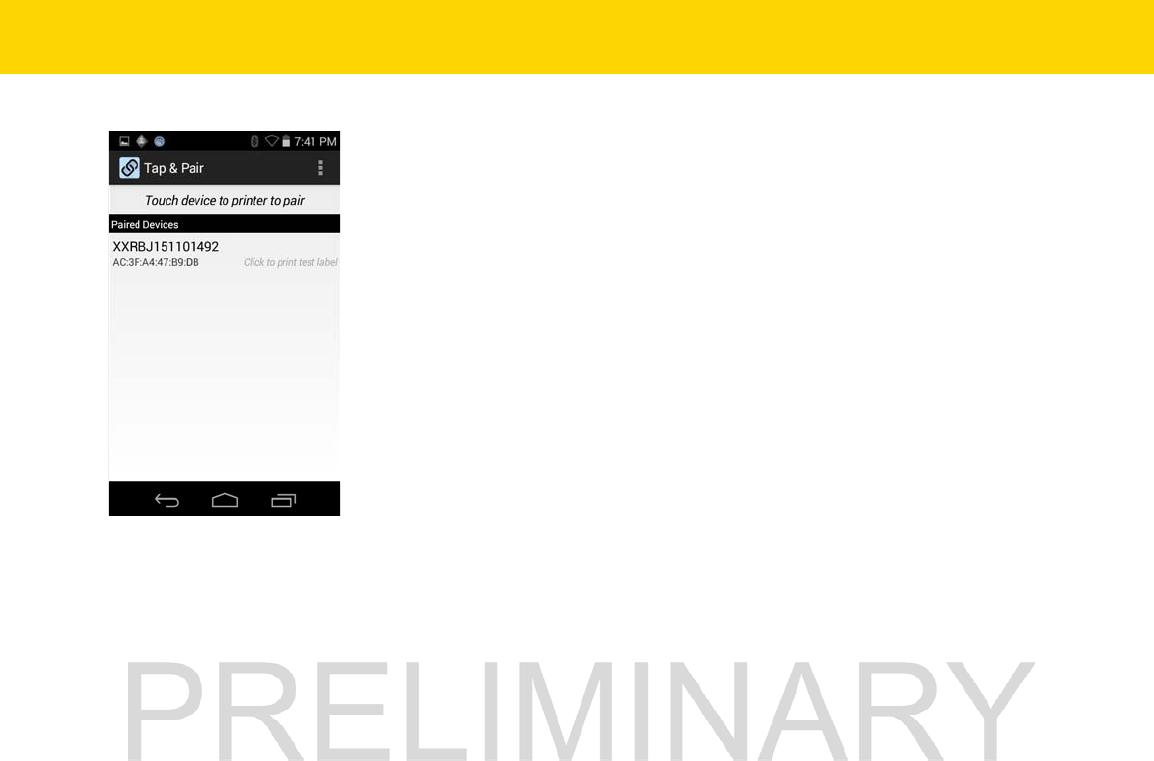
Applications 5 - 17
Figure 5-10 Paired Printer List
7. Tap the Zebra printer in the Paired Devices list to print a test page.
8. Tap OK to print the test page.

5 - 18 WT6000 User Guide
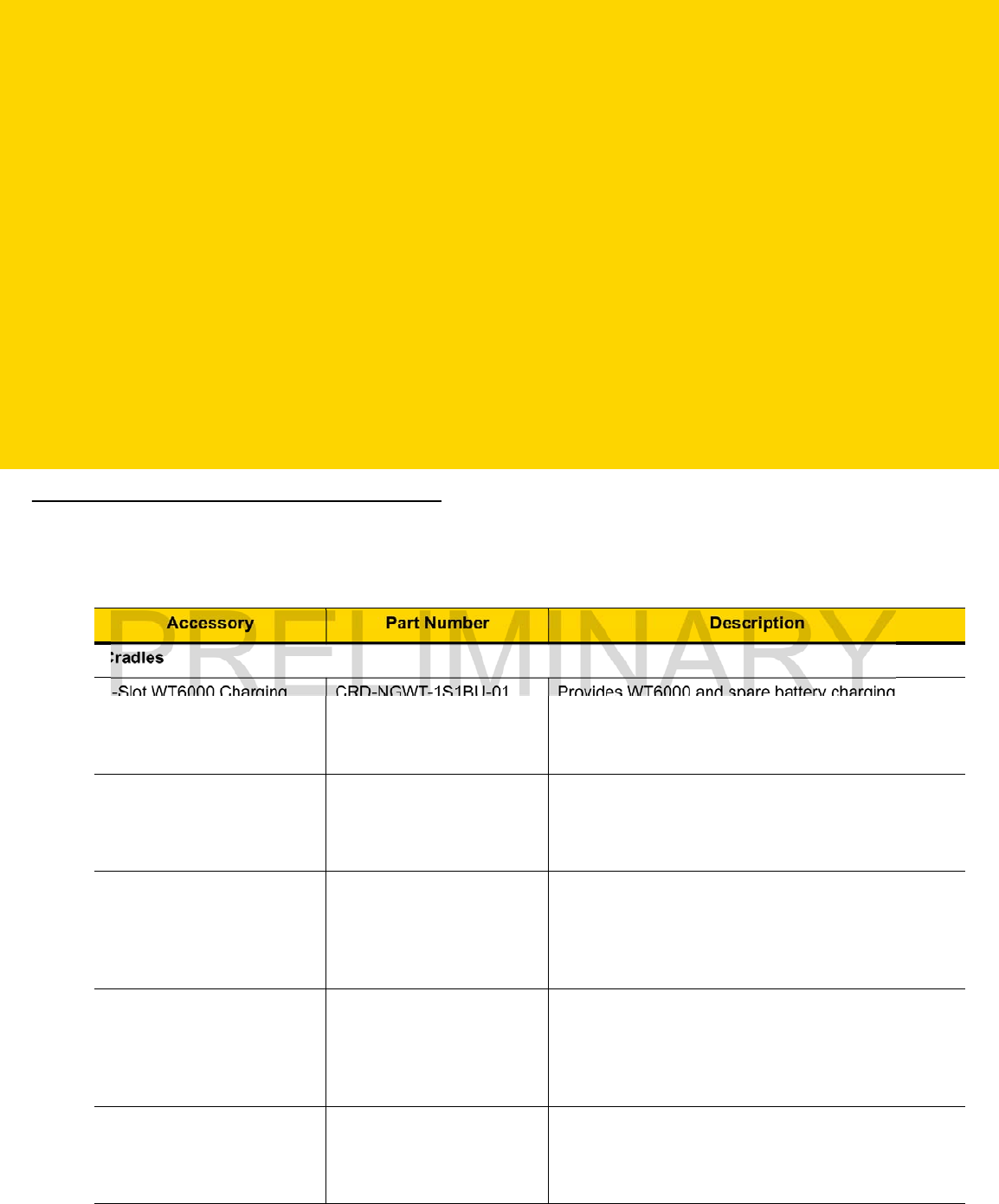
CHAPTER 6 ACCESSORIES
Accessories
Table 6-1 Accessories
Accessory Part Number Description
Cradles
1-Slot WT6000 Charging
Cradle
CRD-NGWT-1S1BU-01 Provides WT6000 and spare battery charging and
USB communication with a host computer. Use with
power supply, p/n PWRS-14000-148R and country
specific grounded AC line cord.
2-Slot WT6000/RS6000
Charging Cradle
CRD-NWTRS-2SUCH-01 Provides WT6000 and RS6000 charging and USB
communication with a host computer. Use with power
supply, p/n PWRS-14000-148R and country specific
grounded AC line cord.
5-Slot WT6000 Charge Only
Cradle
CRD-NGWT-5S5BC-01 Charges up to five WT6000 devices and five spare
batteries. Use with power supply, p/n
PWRS-14000-241R, DC line cord, p/n
50-16002-029R and country specific grounded AC
line cord.
10-Slot WT6000/RS6000
Charge Only Cradle
CRD-NWTRS-10SCH-01 Charges up to five WT6000 devices and up to five
RS6000 scanners. Use with power supply, p/n
PWRS-14000-241R, DC line cord, p/n
50-16002-029R and country specific grounded AC
line cord.
10-Slot WT6000 Charge
Only Cradle
CRD-NGWT-10SCH-01 Charges up to 10 WT6000 devices. Use with power
supply, p/n PWRS-14000-241R, DC line cord, p/n
50-16002-029R and country specific grounded AC
line cord.
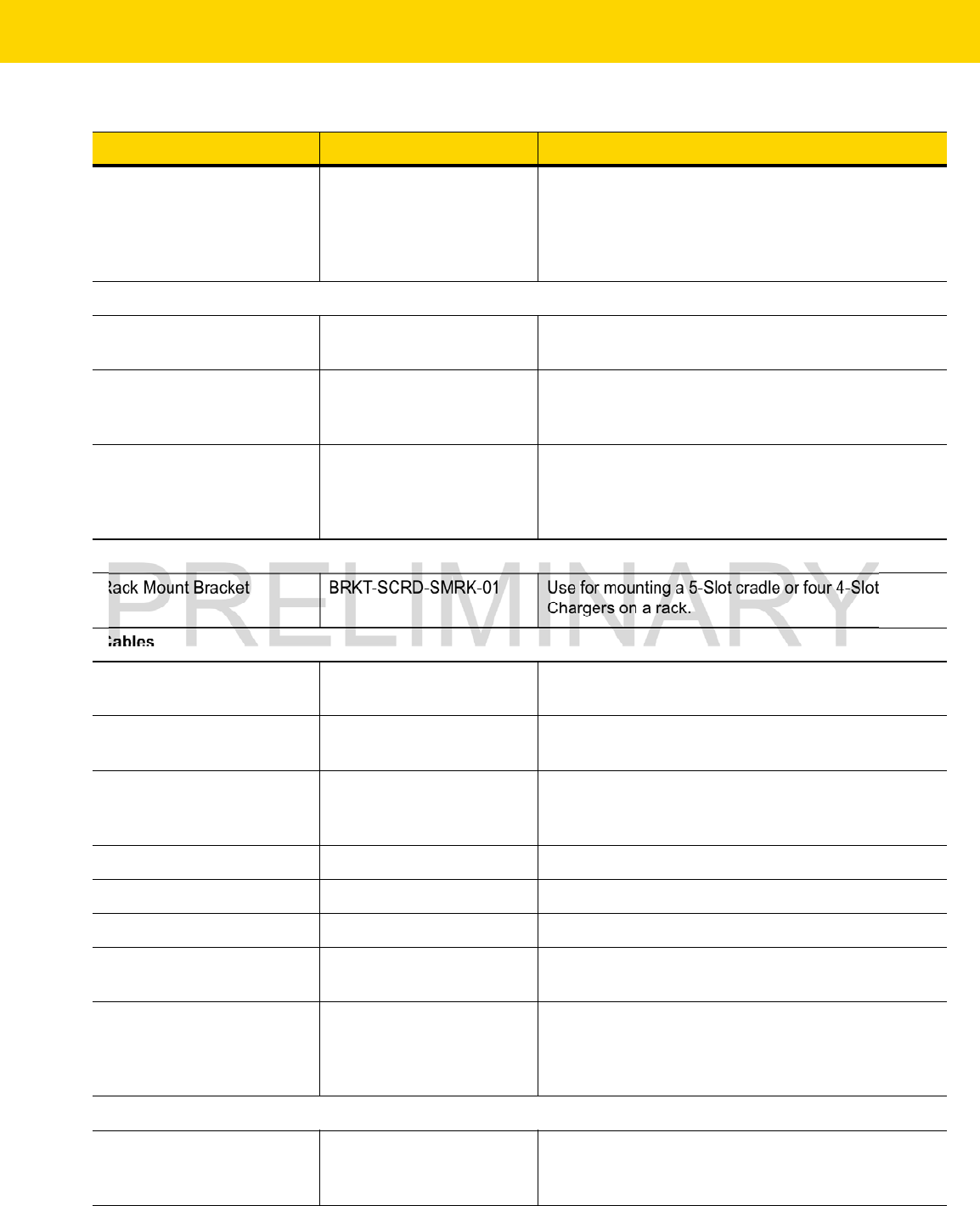
6 - 2 WT6000 User Guide
5-Slot WT6000 Ethernet
Cradle
CRD-NGWT-5S5BE-01 Charges up to five WT6000 devices and five spare
batteries and provides Ethernet communication. Use
with power supply, p/n PWRS-14000-241R, DC line
cord, p/n 50-16002-029R and country specific
grounded AC line cord.
Batteries and Chargers
Replacement Battery BTRY-NWTRS-33MA-01 Replacement battery for WT6000 and RS6000 (single
pack).
4-Slot Battery Charger SAC-NWTRS-4SCH-01 Charges up to four spare batteries. Requires power
supply, p/n PWRS-14000-148R and country specific
grounded AC line cord.
20-Slot Battery Charger SAC-NWTRS-20SCH-01 Charges up to 20 spare batteries. Use with power
supply, p/n PWRS-14000-241R, DC line cord, p/n
50-16002-029R and country specific grounded AC
line cord.
Mounting Brackets
Rack Mount Bracket BRKT-SCRD-SMRK-01 Use for mounting a 5-Slot cradle or four 4-Slot Battery
Chargers on a rack.
Cables
Headset Adapter Cable with
Quick Disconnect (Long)
CBL-NGWT-AUQDLG-01 Connects a wired headset to the WT6000 on a Hip
Mount.
Headset Adapter Cable with
Quick Disconnect (Short)
CBL-NGWT-AUQDST-01 Connects a wired headset to the WT6000 on a Wrist
Mount.
USB/Charge Cable CBL-NGWT-USBCHG-01 Provides USB communication and power to the
WT6000. Requires power supply PWRS-14000-249R
and country specific un-grounded AC line cord.
Vibrating Cable CBL-NGWT-HDVBAP-01
2-Way DC Cable 25-122026-02R
4-Way DC Cable 25-85992-01R
DC Y Cable 25-85993-01R Provides power from the PWRS-14000-241R power
supply to two 4-Slot Battery Chargers.
DC Line Cord 50-16002-029R Provides power from the power supply to the 5-Slot
Charge Only Cradle, 5-Slot Ethernet Cradle, 5-Slot
Charge Only Cradle with Battery Charge and 5-Slot
Ethernet Cradle with Battery Charger.
Power Supplies
Power Supply PWRS-14000-249R Provides power to the device using the USB and
Charging Cable. Requires country specific
un-grounded AC line cord.
Table 6-1 Accessories (Continued)
Accessory Part Number Description
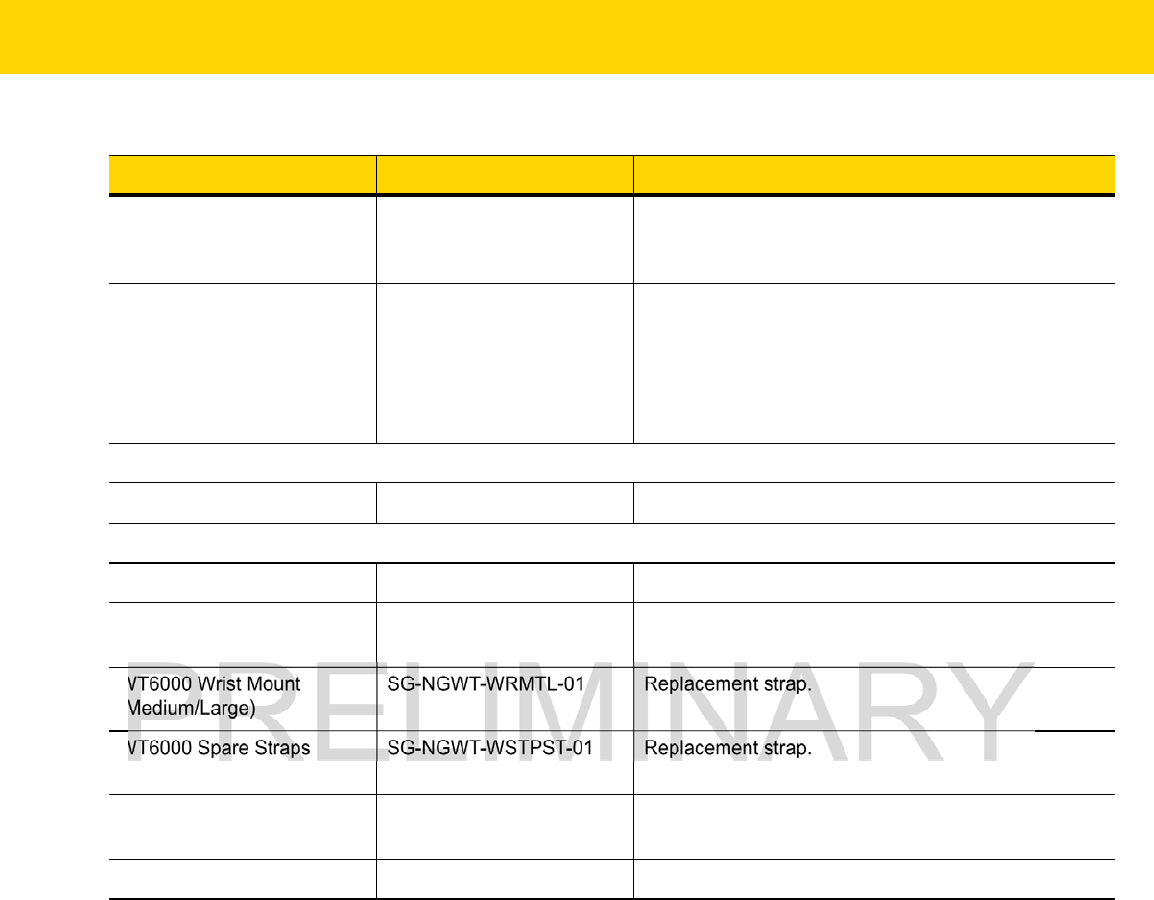
Accessories 6 - 3
Power Supply PWRS-14000-148R Provides power to the 2–Slot cradles and 4-Slot Spare
Battery Charger. Requires country specific grounded
AC line cord.
Power Supply PWRS-14000-241R Provides power to the 5-Slot Charge Only Cradle,
5-Slot Ethernet Cradle, 5-Slot Charge Only Cradle
with Battery Charger and the 5-Slot Ethernet Cradle
with Battery Charger. Requires DC Line Cord, p/n
50-16002–029R and country specific grounded AC
line cord.
Miscellaneous
Screen Protectors ??????? Provides additional protection for display (5-pack).
Soft Goods
WT6000 Hip Mount SG-NGWT-HPMNT-01 Provides mounting the WT6000 on a belt.
WT6000 Wrist Mount
(Small/Medium)
SG-NGWT-WRMTS-01 Replacement strap.
WT6000 Wrist Mount
(Medium/Large)
SG-NGWT-WRMTL-01 Replacement strap.
WT6000 Spare Straps
(Small/Medium)
SG-NGWT-WSTPST-01 Replacement strap.
WT6000 Spare Straps
(Medium/Large)
SG-NGWT-WSTPLN-01 Replacement strap.
WT6000 Spare Comfort Pad SG-NGWT-CMPD-01 Replacement Comfort Pad for the Wrist Mount.
Table 6-1 Accessories (Continued)
Accessory Part Number Description
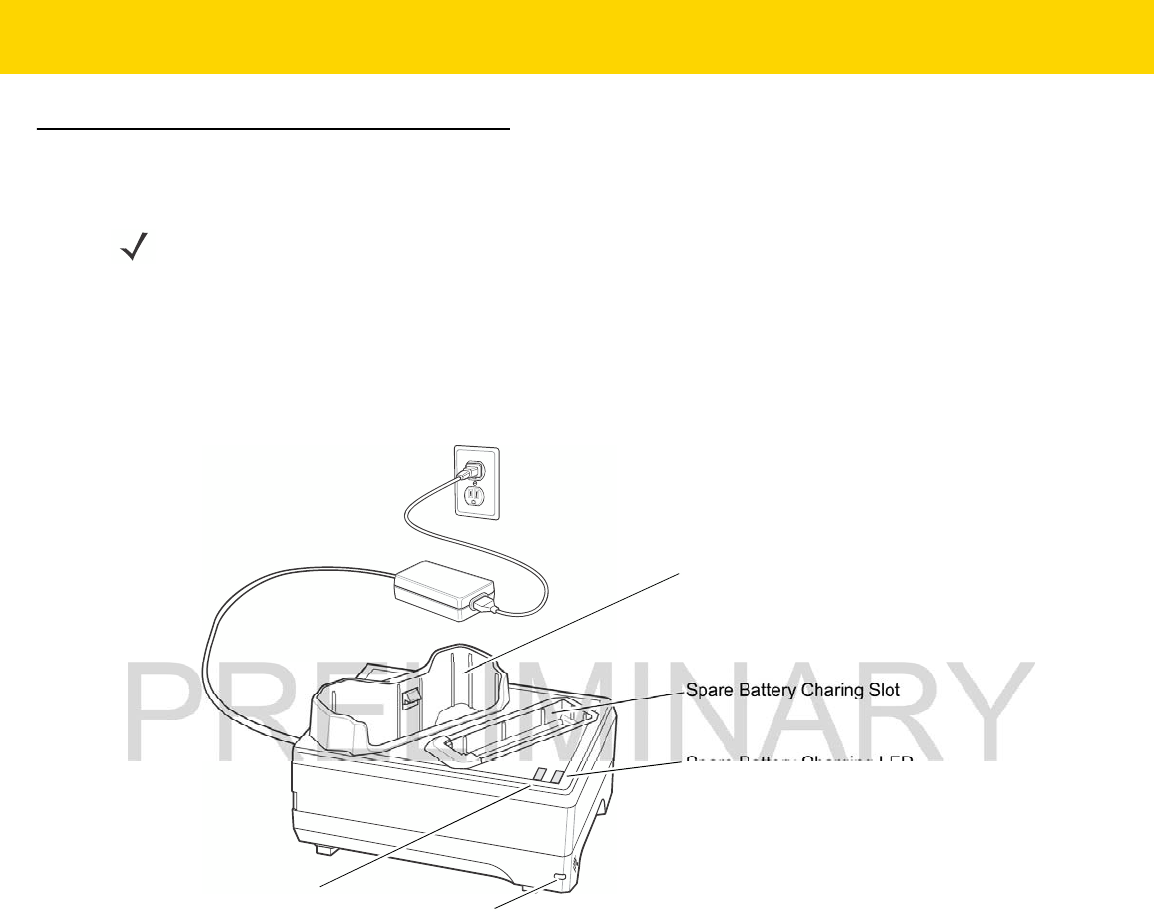
6 - 4 WT6000 User Guide
1-Slot WT6000 USB Charging Cradle
The 1-Slot WT6000 Charging Cradle:
•
provides 5.4 VDC (nominal) power for operating the WT6000
•
provides USB communication with a host computer
•
charges a spare battery.
Figure 6-1 1-Slot WT6000 Charging Cradle
Charging the Device
1. Insert either end of the WT6000 into the WT6000 charging slot.
NOTE
Ensure that you follow the guidelines for battery safety described in Battery Safety Guidelines on page 7-1.
Spare Battery Charging LED
Spare Battery Charing Slot
Power LED
WT6000 Charging Slot
WT6000 Charging LED
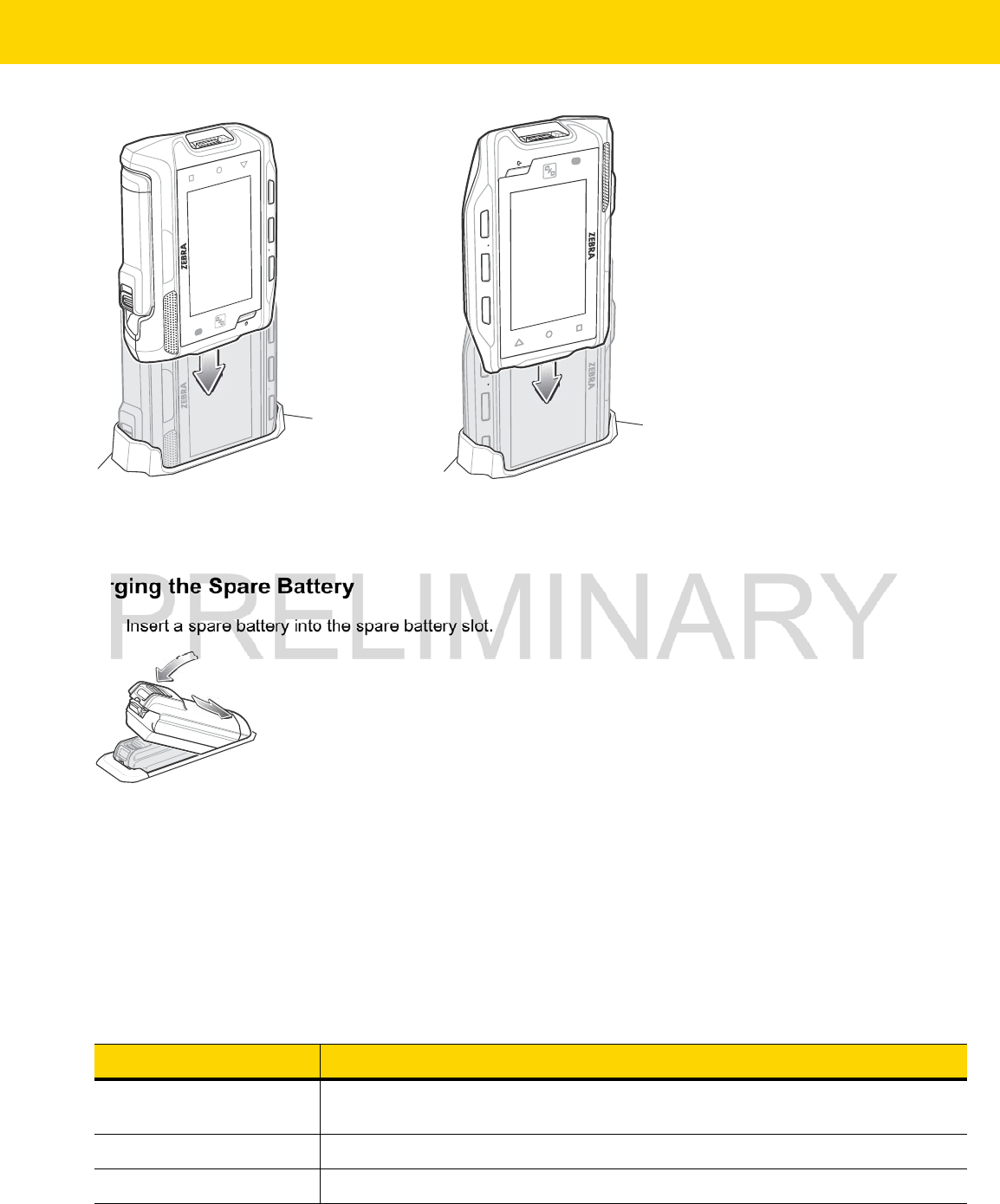
Accessories 6 - 5
Figure 6-2 Insert WT6000 into Cradle
2. Ensure the WT6000 is seated properly. The WT6000 Charge LED blinks indicating charging.
Charging the Spare Battery
1. Insert a spare battery into the spare battery slot.
Figure 6-3 Insert Battery into Cradle
2. Ensure the battery is seated properly. The Spare Battery Charging LED blinks indicating charging.
Battery Charging
The WT6000 Charging LED indicates the charging status of the battery in the WT6000 and the Spare Battery
Charging LED indicates the charging status of the spare battery. See Table 6-2 on page 6-5. The 3,350 mAh
battery fully charges in less than four hours at room temperature.
Table 6-2 Charging LED Indicators
State Indication
Off The battery is not charging. The battery is not inserted correctly in the cradle or
connected to a power source. Cradle is not powered.
Solid Amber Battery is charging.
Solid Green Battery charging is complete.
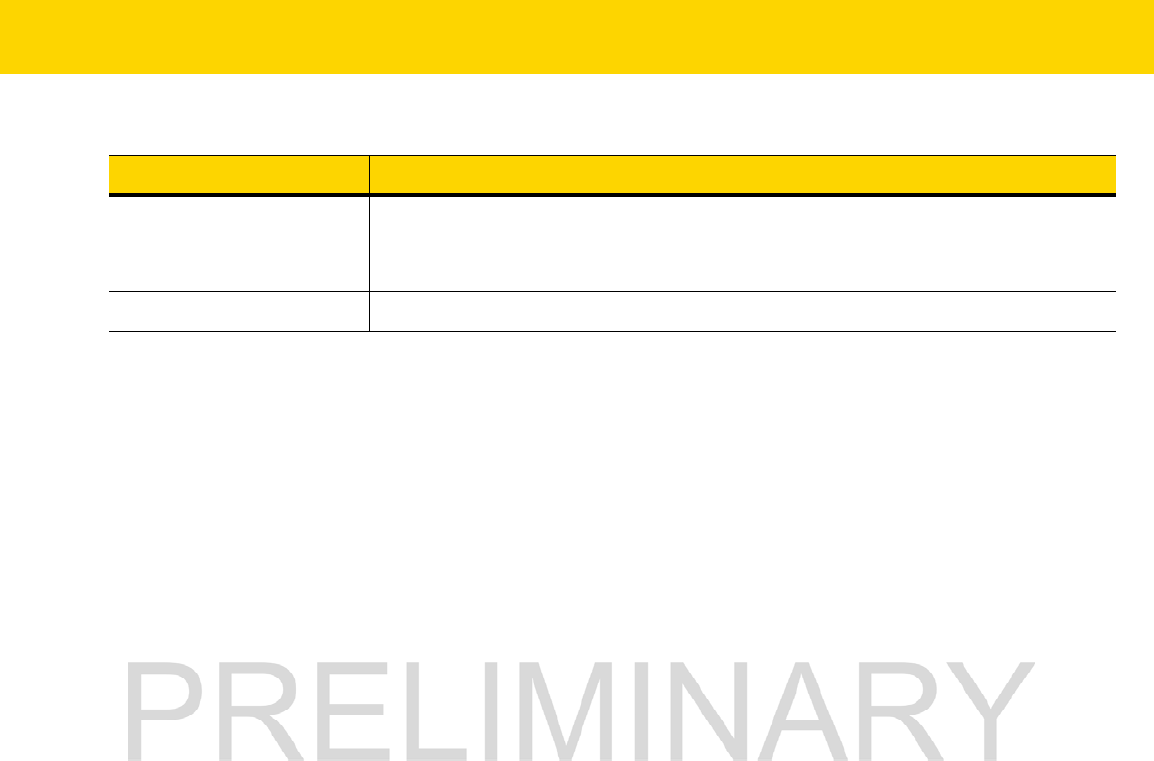
6 - 6 WT6000 User Guide
Charge batteries in temperatures from 0 °C to 40 °C (32 °F to 104 °F). The device or cradle always performs
battery charging in a safe and intelligent manner. At higher temperatures (e.g. approximately +37 °C (+98 °F)) the
device or cradle may for small periods of time alternately enable and disable battery charging to keep the battery at
acceptable temperatures. The device and cradle indicates when charging is disabled due to abnormal
temperatures via its LED.
Fast Blinking Red
(2 blinks/second)
Charging error, e.g.:
- Temperature is too low or too high.
- Charging has gone on too long without completion (typically eight hours).
Solid Red Unhealthy battery is charging or fully charged.
Table 6-2 Charging LED Indicators (Continued)
State Indication
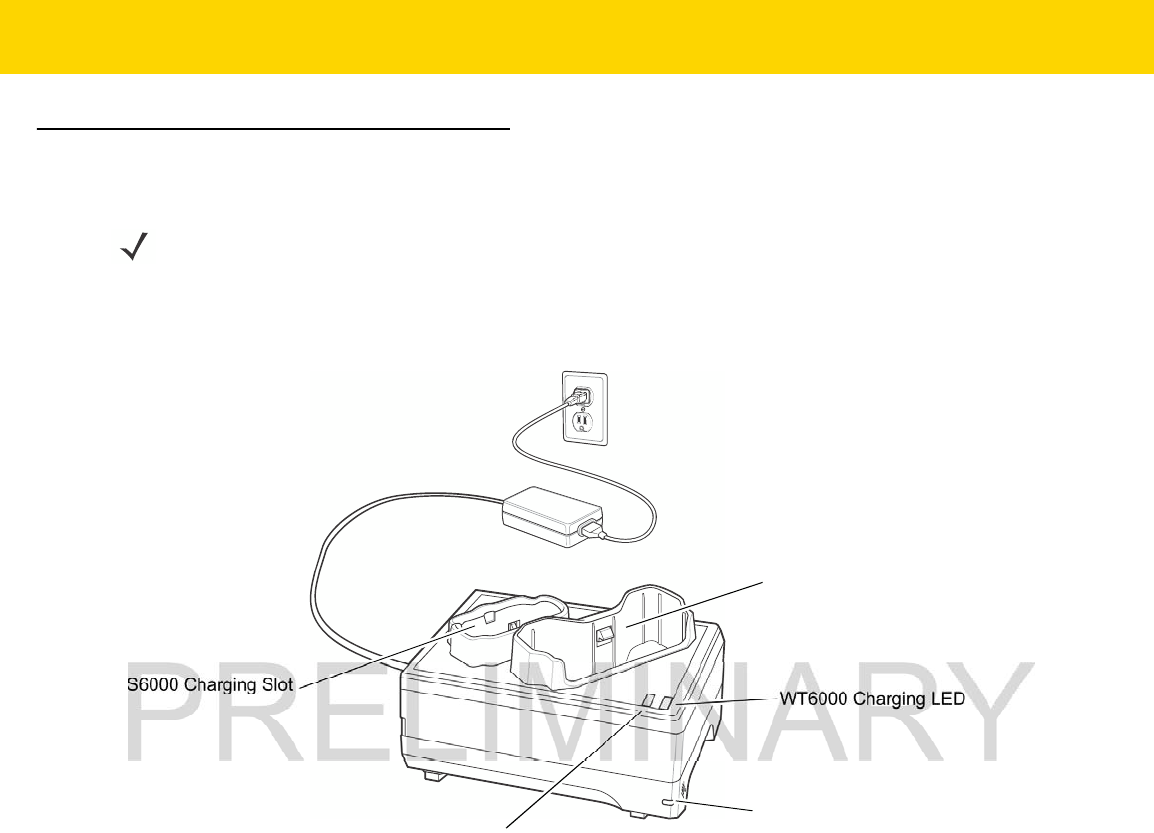
Accessories 6 - 7
2-Slot WT6000/RS6000 Charging Cradle
The 2-Slot WT6000/RS6000 Charging Cradle:
•
provides 5.4 VDC (nominal) power for operating the WT6000 and RS6000.
Figure 6-4 2-Slot WT6000/RS6000 Charging Cradle
Charging the WT6000
1. Insert the WT6000 into the WT6000 charging slot.
NOTE
Ensure that you follow the guidelines for battery safety described in Battery Safety Guidelines on page 7-1.
RS6000 Charging LED
RS6000 Charging Slot
Power LED
WT6000 Charging Slot
WT6000 Charging LED
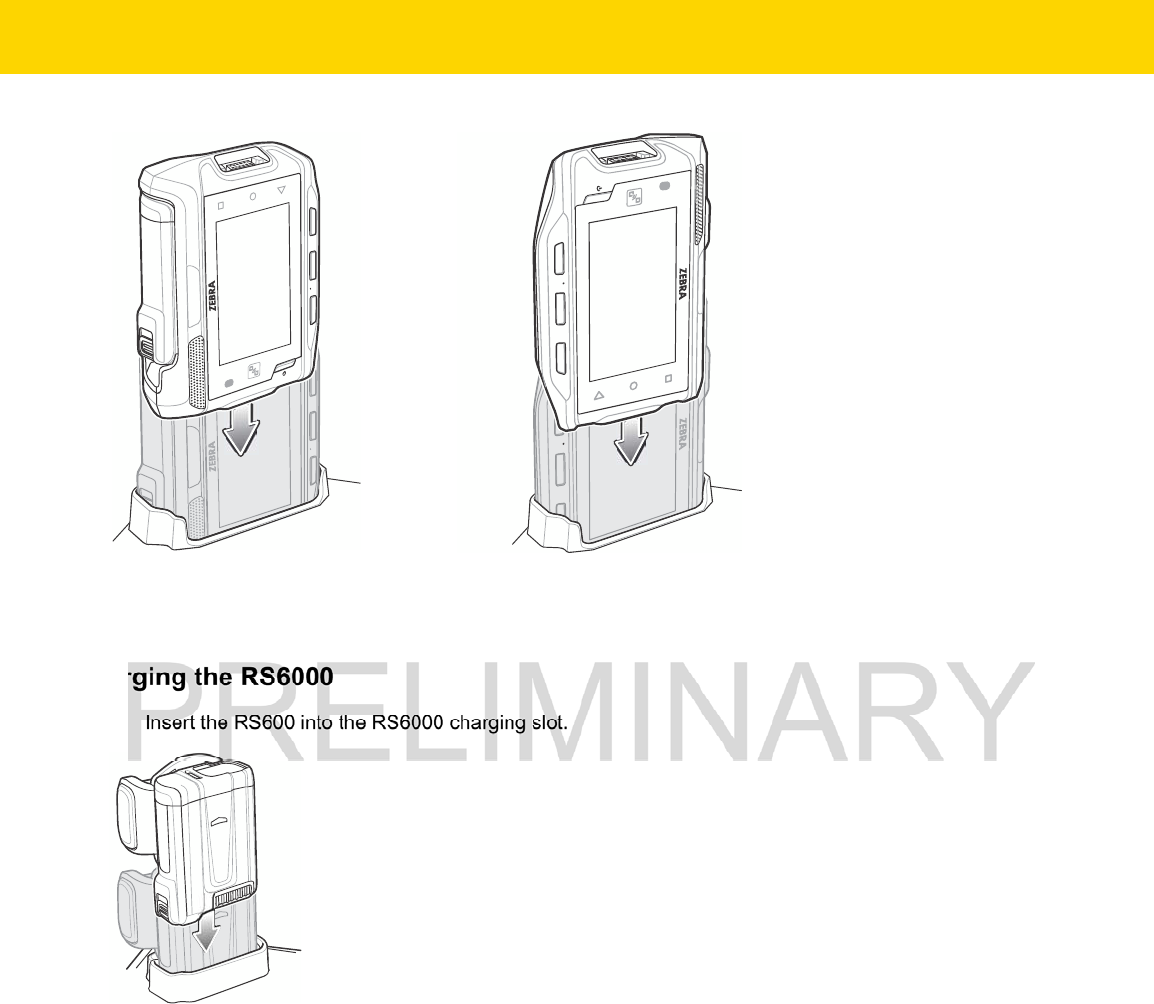
6 - 8 WT6000 User Guide
Figure 6-5 Insert WT6000 into Cradle
2. Ensure the WT6000 is seated properly. The WT6000 Charging LED blinks indicating charging.
Charging the RS6000
1. Insert the RS600 into the RS6000 charging slot.
Figure 6-6 Insert RS6000 into Cradle
2. Ensure the RS6000 is seated properly. The RS6000 Charging LED blinks indicating charging.
Battery Charging
The WT6000 Charging LED indicates the charging status of the battery in the WT6000 and the RS6000 Charging
LED indicates the charging status of the battery in the RS6000. See Table 6-2 on page 6-5. The 3,350 mAh battery
fully charges in less than four hours at room temperature.
Charge batteries in temperatures from 0 °C to 40 °C (32 °F to 104 °F). The device or cradle always performs
battery charging in a safe and intelligent manner. At higher temperatures (e.g. approximately +37 °C (+98 °F)) the
device or cradle may for small periods of time alternately enable and disable battery charging to keep the battery at
acceptable temperatures. The device and cradle indicates when charging is disabled due to abnormal
temperatures via its LED.
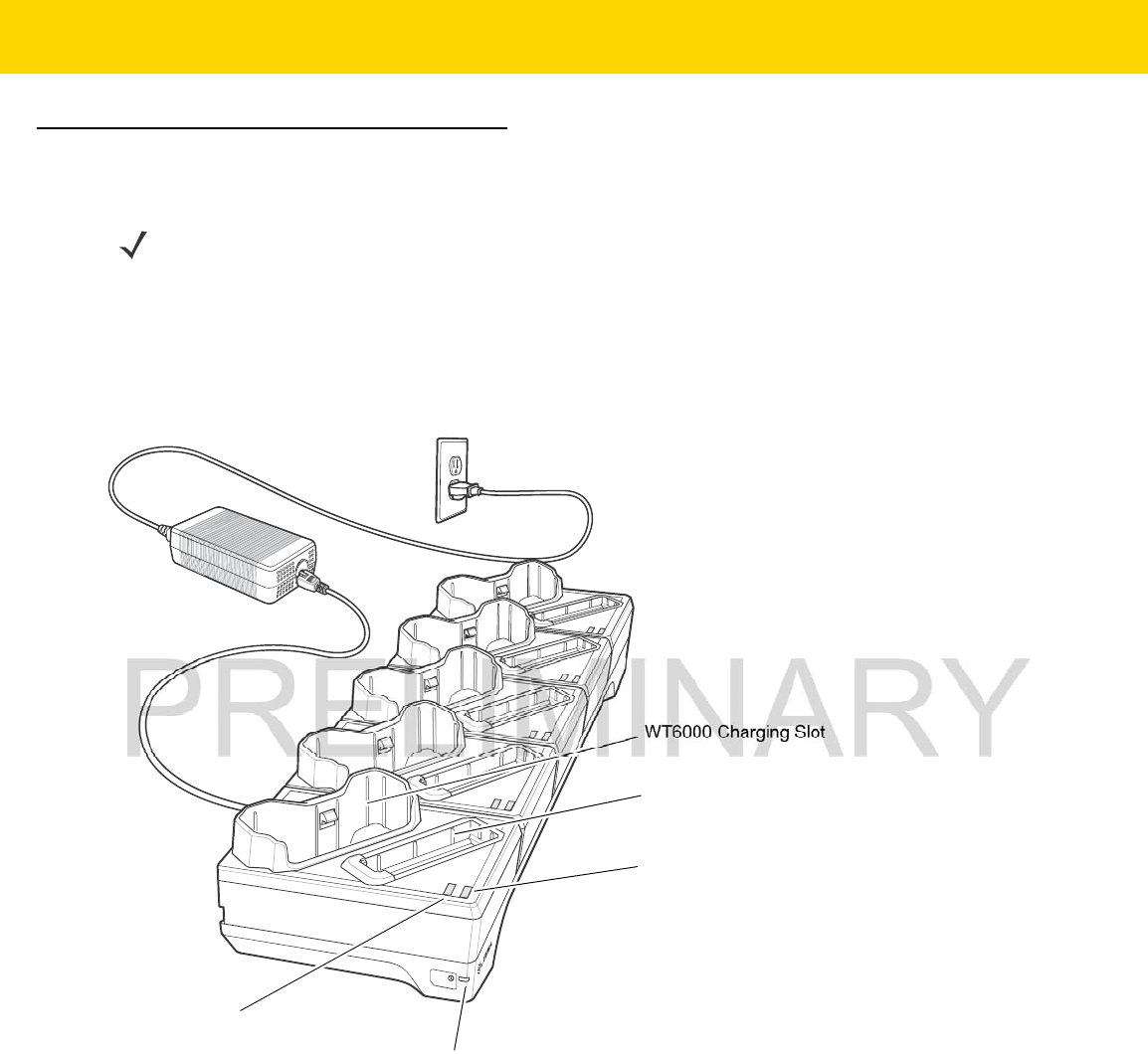
Accessories 6 - 9
5-Slot WT6000 Charge Only Cradle
The 5-Slot Charge Only Cradle:
•
Provides 5.4 VDC (nominal) power for operating up to five WT6000 devices.
•
Simultaneously charges up to five WT6000 devices.
•
Simultaneously charges up to five spare batteries.
Figure 6-7 5-Slot WT6000 Charge Only Cradle
Charging the WT6000
To Charge the WT6000:
1. Insert the WT6000 in a WT6000 charging slot.
NOTE
Ensure that you follow the guidelines for battery safety described in Battery Safety Guidelines on page 7-1.
Spare Battery Charging LED
Spare Battery Charing Slot
Power LED
WT6000 Charging Slot
WT6000 Charging LED
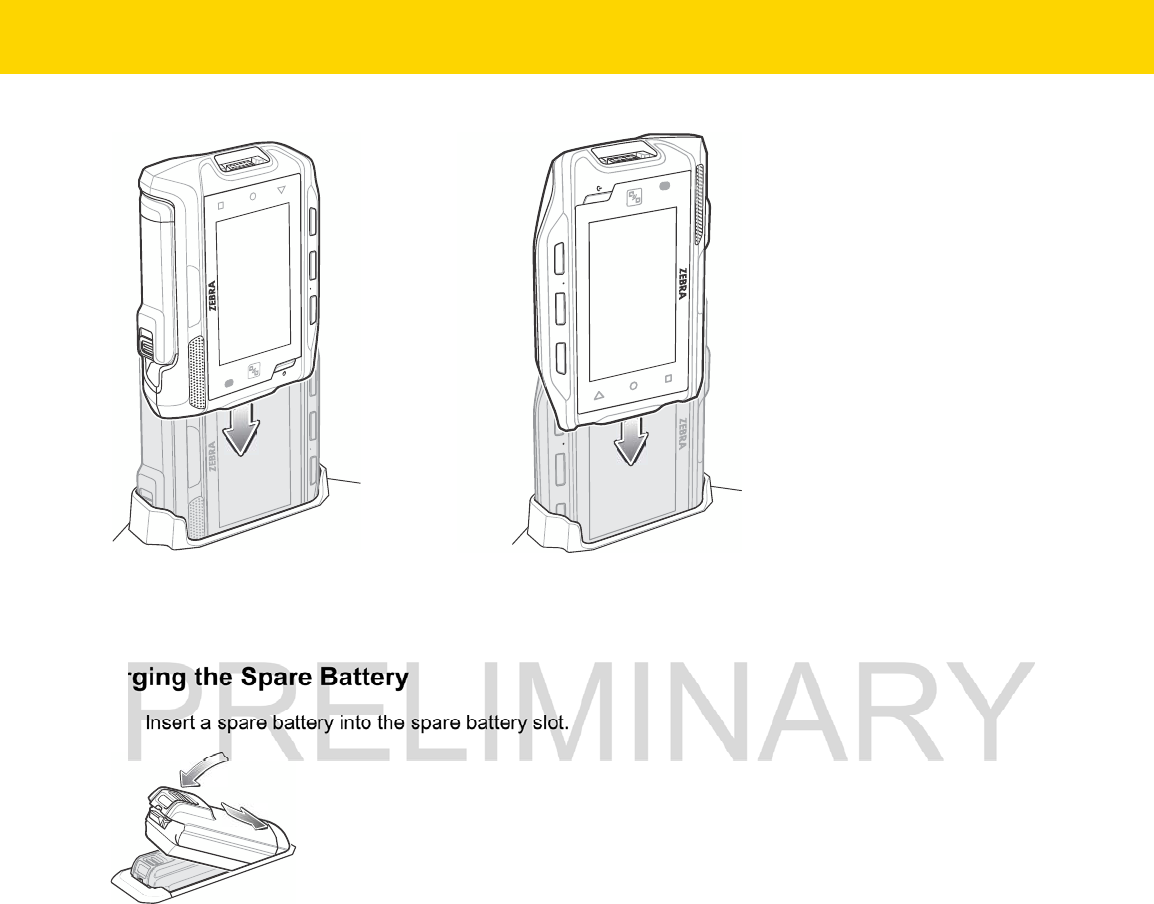
6 - 10 WT6000 User Guide
Figure 6-8 Insert WT6000 into Cradle
2. Ensure that the WT6000 is properly seated in the charging slot.
Charging the Spare Battery
1. Insert a spare battery into the spare battery slot.
Figure 6-9 Insert Battery into Cradle
2. Ensure the battery is seated properly. The Spare Battery Charging LED blinks indicating charging.
Battery Charging
The WT6000 Charging LED indicates the charging status of the battery in the WT6000 and the Spare Battery
Charging LED indicates the charging status of the spare battery. See Table 6-2 on page 6-5. The 3,350 mAh
battery fully charges in less than four hours at room temperature.
Charge batteries in temperatures from 0 °C to 40 °C (32 °F to 104 °F). The device or cradle always performs
battery charging in a safe and intelligent manner. At higher temperatures (e.g. approximately +37 °C (+98 °F)) the
device or cradle may for small periods of time alternately enable and disable battery charging to keep the battery at
acceptable temperatures. The device and cradle indicates when charging is disabled due to abnormal
temperatures via its LED.
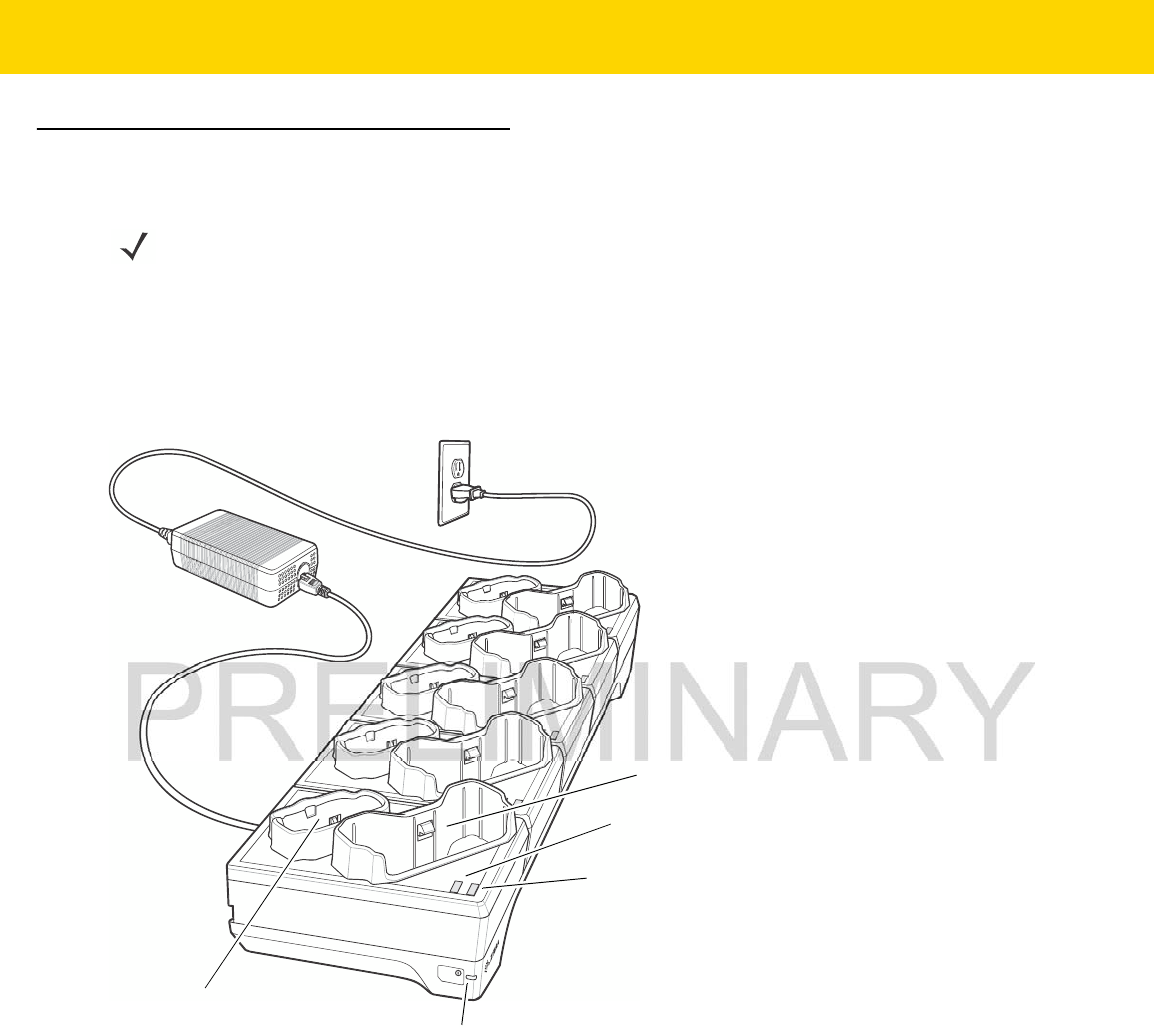
Accessories 6 - 11
10-Slot WT6000/RS6000 Charge Only Cradle
The 10-Slot Charge Only Cradle:
•
Provides 5.4 VDC (nominal) power for operating the WT6000 and RS6000.
•
Simultaneously charges up to five WT6000 devices.
•
Simultaneously charges up to five RS6000 devices.
Figure 6-10 10-Slot WT6000/RS6000 Charge Only Cradle
Charging the WT6000
To Charge the WT6000:
1. Insert the WT6000 in the WT6000 charging slot.
NOTE
Ensure that you follow the guidelines for battery safety described in Battery Safety Guidelines on page 7-1.
Power LED
WT6000 Charging Slot
WT6000 Charging LED
RS6000 Charging Slot
RS6000 Charging LED
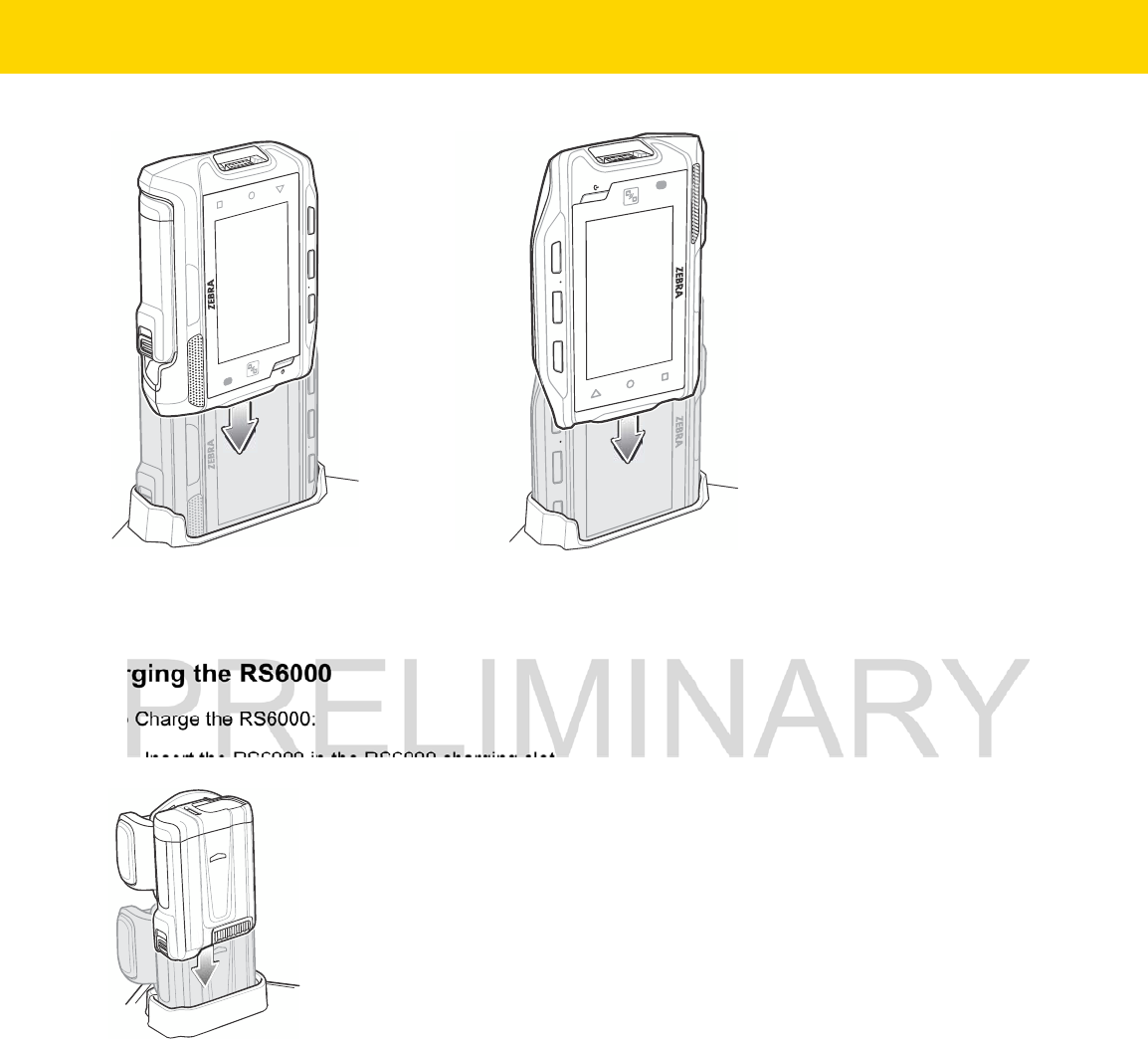
6 - 12 WT6000 User Guide
Figure 6-11 Insert WT6000 into Cradle
2. Ensure that the WT6000 is properly seated in the charging slot.
Charging the RS6000
To Charge the RS6000:
1. Insert the RS6000 in the RS6000 charging slot.
Figure 6-12 Insert RS6000 into Cradle
2. Ensure that the RS6000 is properly seated in the charging slot.
Battery Charging
The WT6000 Charging LED indicates the charging status of the battery in the WT6000 and the RS6000 Charging
LED indicates the charging status of the battery in the RS6000. See Table 6-2 on page 6-5. The 3,350 mAh battery
fully charges in less than four hours at room temperature.
Charge batteries in temperatures from 0°C to 40°C (32°F to 104°F). The battery charger always performs battery
charging in a safe and intelligent manner. At higher temperatures (e.g. approximately +37°C (+98°F)) the battery
charger may for small periods of time alternately enable and disable battery charging to keep the battery at
acceptable temperatures. The battery charger indicates when charging is disabled due to abnormal temperatures
via its LED.
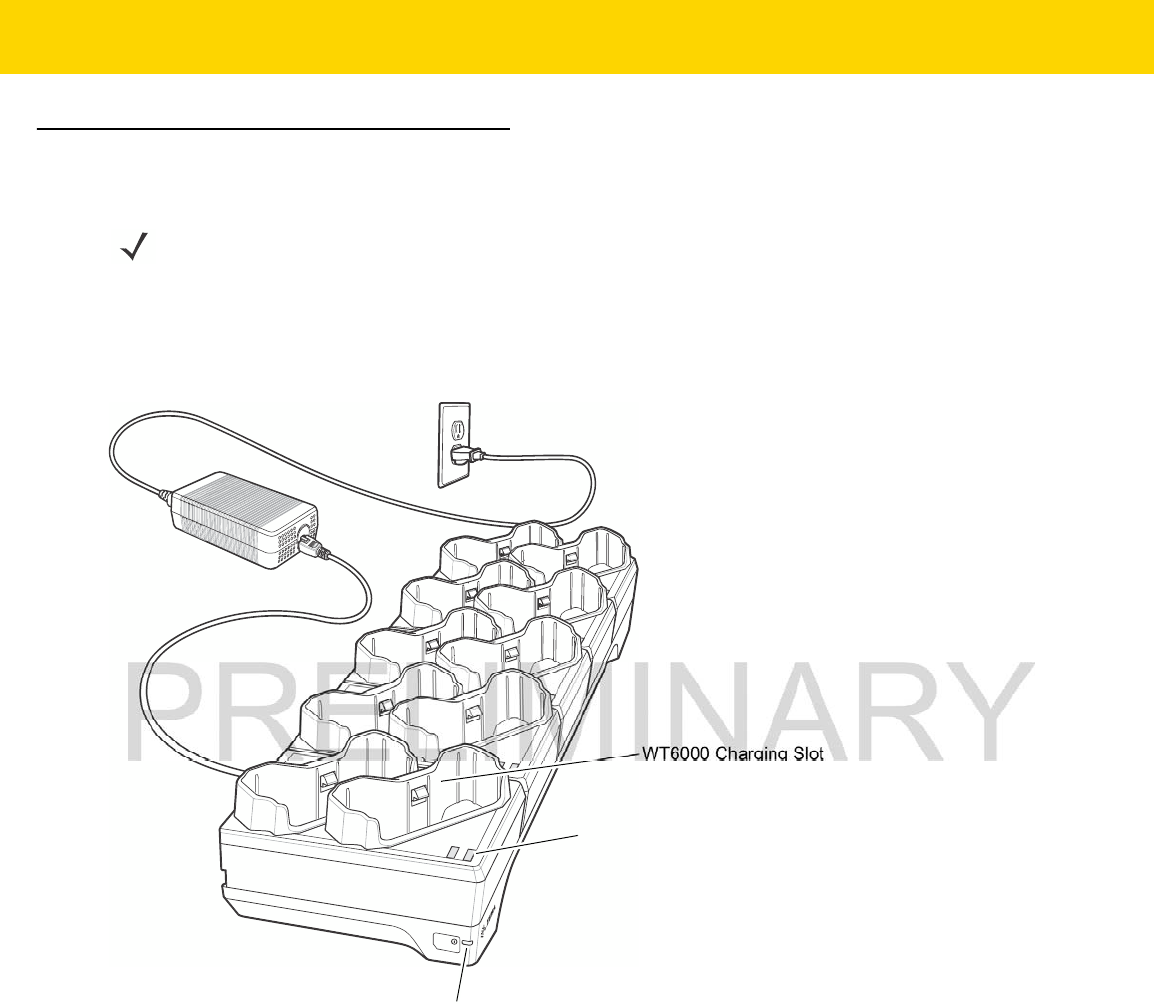
Accessories 6 - 13
10-Slot WT6000 Charge Only Cradle
The 10-Slot WT6000 Charge Only Cradle:
•
Provides 5.4 VDC (nominal) power for operating the WT6000.
•
Simultaneously charges up to 10 WT6000 devices.
Figure 6-13 10-Slot WT6000 Charge Only Cradle
Charging the WT6000
To Charge the WT6000:
1. Insert the WT6000 in the charging slot.
NOTE
Ensure that you follow the guidelines for battery safety described in Battery Safety Guidelines on page 7-1.
Power LED
WT6000 Charging Slot
WT6000 Charging LED